

How to plan a Trip to Zanskar Valley – A Complete Travel Guide
Featured , Ladakh , Zanskar
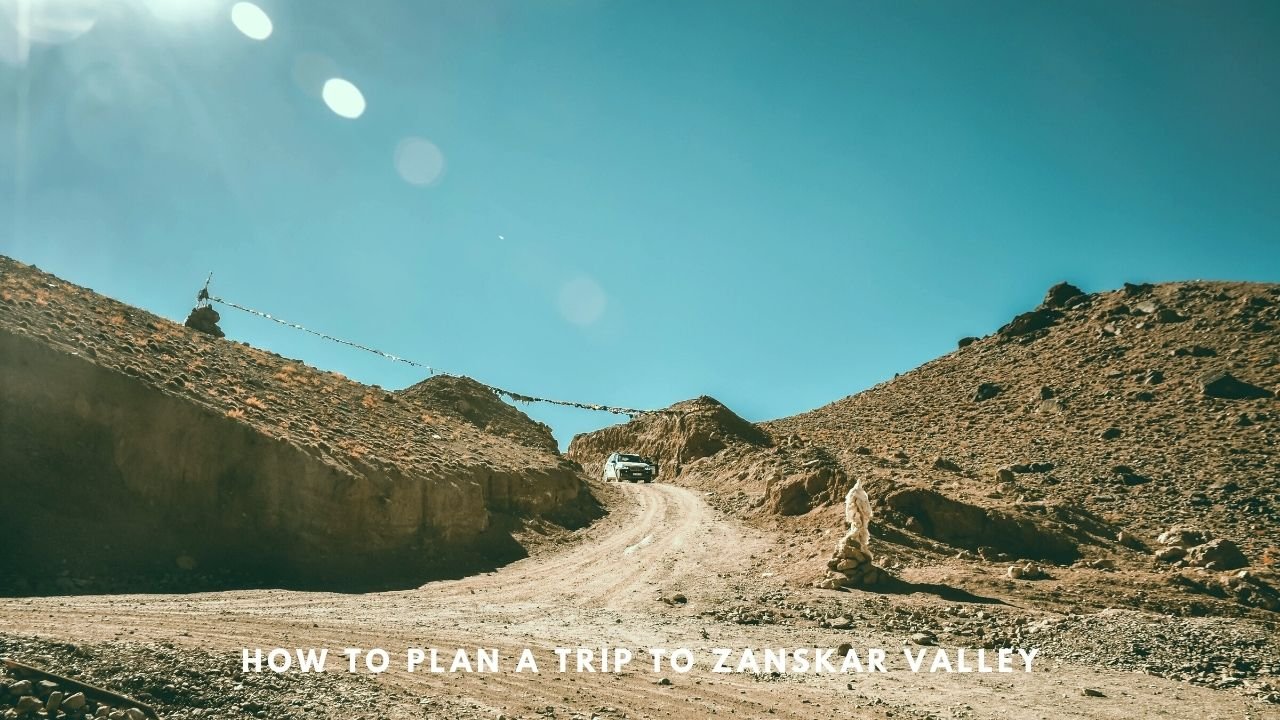
Last Updated on: Feb 10, 2023
I was introduced to Zanskar valley through a photograph of the Phugtal Monastery almost 8 years ago. It was then I had tried to know more about the place and had started planning a trip there. But information about Zanskar was not quite easy to get, especially at that time. Zanskar valley was also a difficult place to reach. The place literally remains under snow for almost 7 months of the year. The only way someone from Zanskar could connect to the outside world is by walking over the frozen Zanskar River!
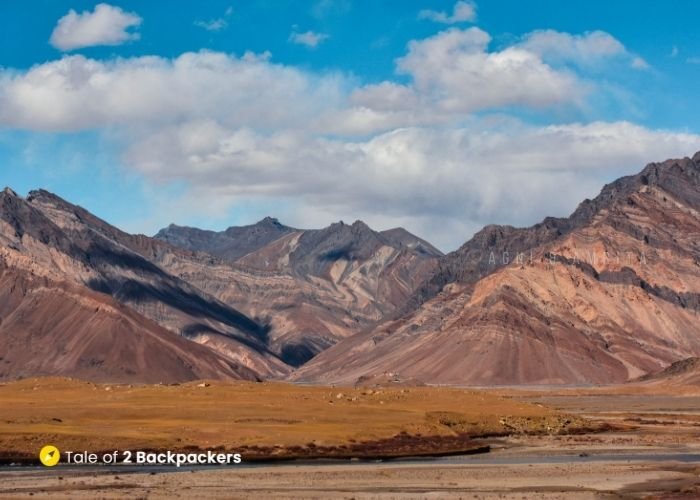
The remoteness gives an aura of mystery to Zanskar Valley. After visiting Zanskar Valley, we can definitely say that Zanskar is one of the most enchanting and beautiful places in India. Zanskar Valley is located in a remote corner of Ladakh. Reaching there can be tricky and difficult. So, after spending some time at Zanskar and exploring this wonderland, we are sharing our best tips to visit Zanskar Valley. If you are wondering how to plan your Zanskar valley trip, then you have come to the right place. Read on!
About Zanskar Valley
Zanskar Valley is like a hidden world. Located at an altitude of 13154 feet in the northern part of the Great Himalayas, Zanskar Valley is literally cut off from the rest of the world due to geographical constraints. Without the influence of outside influences, Zanskar valley has remained one of the last strongholds of the ancient Tibetan Buddhism culture and tradition.
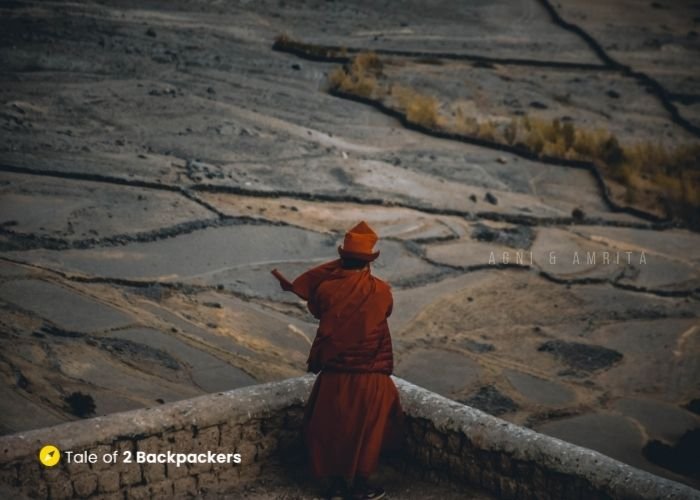
Even a few years back, Zanskar valley was a self-sustaining community living off the land by farming and cattle rearing. The winter season is quite harsh in Zanskar. Temperature goes down as low as -40-degree Celcius. The Zanskaris, therefore, work, trade and travel during the summer month and store for the winter season.
The valley gets cut off from the rest of the world for almost 7 months in a year due to snowfall. Roads get blocked and Zanskar is yet to have an airport. The only way to connect to the outside world is by walking over the frozen Zanskar river, popularly known as the Chadar Trek . The almost 100 km Chadar (meaning blanket) trek is the only way by which the locals can get out of this remote valley.
And this trek is only possible in the months of January and February because of the challenges of walking over sheets of ice on the Zanskar river. However, the Zanskaris have well mastered the art of reading the ice and have found a way to traverse the icy ways.
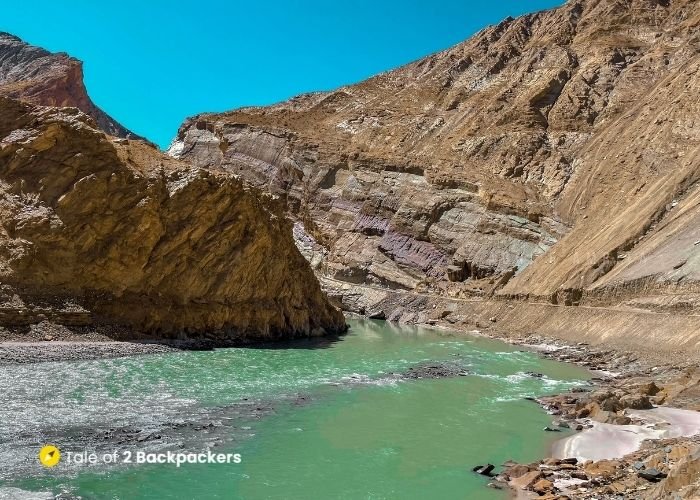
Changing Times
Things, however, are changing. Earlier, there was only one road to reach Padum, the main town of Zanskar valley. It was the 230 km road crossing the 5000 m Penzi La Pass from Kargil to Padum.
But last year, in 2020, two new roads opened up. Although these roads are not yet fully constructed, you can definitely travel through these roads. The road from Leh to Padum through the Singe La Pass has considerably reduced the time taken to reach Padum from Leh. Earlier, you would have to travel to Kargil from Leh (220 km) and then travel another 230 km from Kargil to Padum.
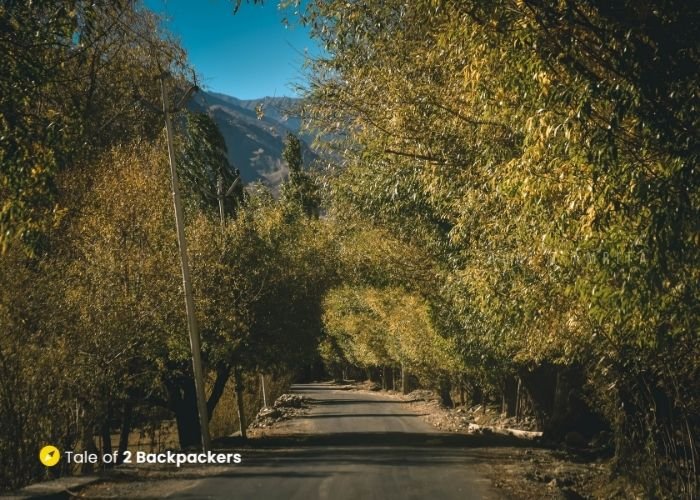
The second road is from Darcha near Manali, Himachal Pradesh via the Shinku La Pass. Although the road is barely constructed, you can still reach Padum in 2 days.
Another road is being constructed from Leh to Chilling to Padum. When constructed, this will reduce the time of travel considerably. This is also going to be an all-weather road, thus providing all-year connectivity to Zanskar Valley when the rest of the roads are closed during winter.
We also heard that very soon Zanskar will have an operational airport soon.
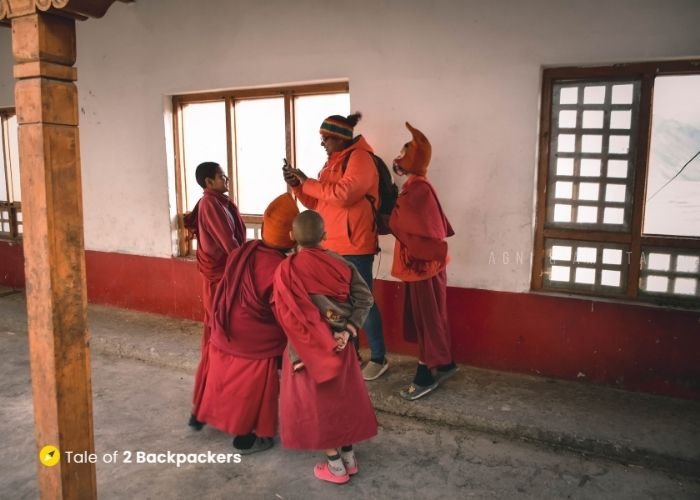
With changing times and exposure to the outer world, life is also changing in Zanskar Valley. Earlier, children used to attend schools in Zanskar Valley. Now, many students are sent to Leh and Kargil to attend schools and colleges.
The ancient and traditional practices are also getting replaced by modern technology. Earlier, the locals used yaks and dzo (a hybrid between yak and domestic cattle) for the farm work. Very recently one village had started the use of tractors. Electricity and water are gradually reaching every house in Zanskar villages. Mobile network has also reached most of the villages. So, Zanskar is on the threshold of modernization.
Life in Zanskar Valley – A Cinematic Film
How to reach Zanskar Valley?
Reaching Zanskar Valley has always been quite tough. Earlier, Zanskar was connected to the rest of Ladakh by only the Kargil-Padum road. It is almost a 250 km journey on this road taking 2 days.
But last year 2 new roads were opened to Zanskar Valley which makes reaching Zanskar a tad bit easier.
Zanskar does not have any airports yet. You can either fly into Srinagar or Leh and then carry on towards Zanskar Valley.
Reaching Zanskar from Leh
Kargil – padum road.
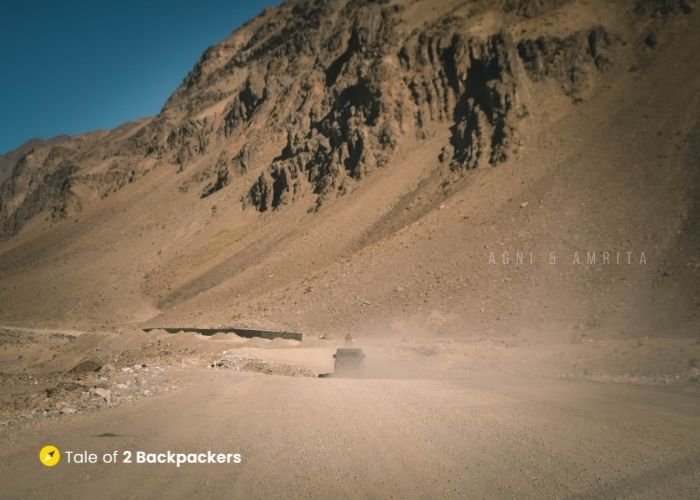
Earlier, Kargil – Padum Road was the only way to reach Zanskar. The distance covered is almost 250 km on this route. The Kargil – Padum Road crosses the Pensi La Pass (4400 m or 14436 feet) and remains closed during the winter due to snowfall.
The route is as follows:
Kargil – Sankoo – Panikhar – Parkachik – Rangdum – Padum
You can either start from Srinagar or Leh and reach Kargil, and then carry forward towards Padum. You can halt at either Panikar, Parkachik or Rangdum for the night and then carry forward towards Padum the next day.
Leh to Padum via Lingshed
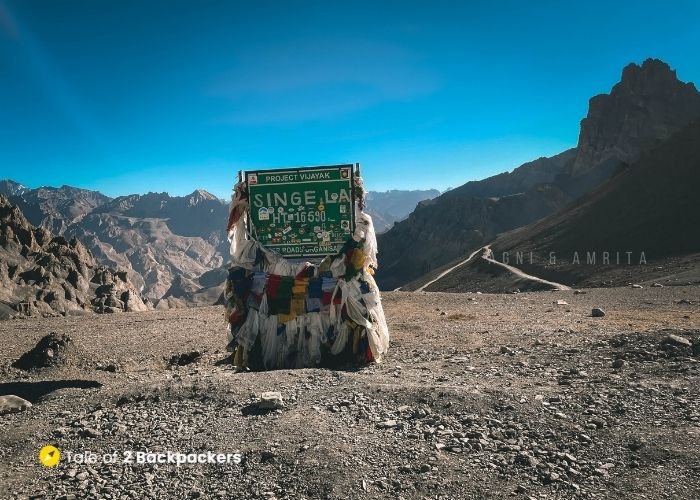
This is the new route opened in 2020. This makes travelling to Zanskar easier from Leh. You do not have to travel all the way to Kargil. Instead, you can take this new road towards Zanskar Valley. If you start early enough from Leh and do not stop on the way very much, then you can reach Padum on the same day itself.
Leh – Khaltse – Wanla – Sir Sir La – Photoksar – Singe La – Lingshed – Zangla – Padum
A few kilometers beyond Wanla, the trail is totally off-road having mainly dirt tracks. But travelling on this road is an adventure for sure.
Reaching Zanskar from Manali
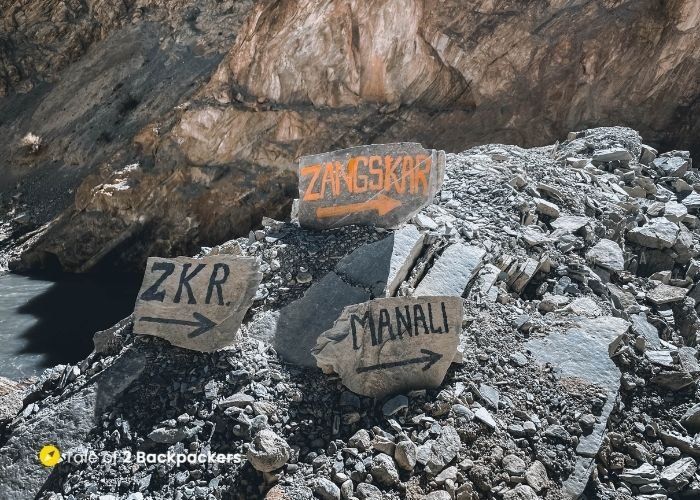
This is another road that opened in 2020 and the best thing about this road is that it connects the Lahaul Valley to Zanskar Valley via the Shinku La Pass (16580 feet). So basically, you can start your trip from Manali and reach Zanskar Valley.
Manali – Keylong – Darcha – Kurgiakh – Purne – Padum
Beyond Darcha, there are no proper roads yet. All you can find is a dirt track. The road runs parallel to the Manali – Leh route and you will find a similar landscape on the way, but far more isolated!
You are going to cover almost 270 km from Manali to Padum. So, a night stay is definitely recommended.
All these roads remain opened only during the summer months. Winters witness heavy snowfall at the passes and the roads remain closed.
READ MORE ABOUT HOW TO REACH ZANSKAR VALLEY
Private Vehicles – Bike Ride or Self drive
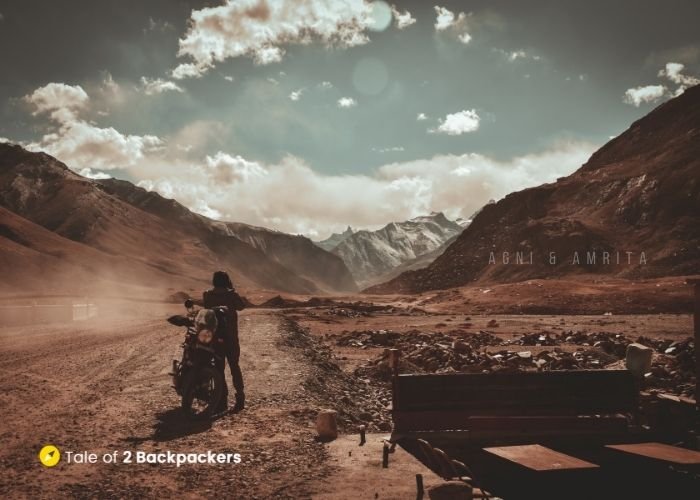
Reaching Zanskar Valley is an adventure in itself. And if you want a real feel of thrill on road, then you can ride self-drive or ride your bike to Zanskar Valley. You will drive through one of the most adventurous and tough terrains in India. You can take your own car or bike and can even take a rented one.
However, be careful while driving through these roads. Be prepared to drive/ ride through dirt roads, muddy trails and crossing over streams and nallahs.
For cars, we recommend using an SUV on these roads. There are parts in the roads from Leh to Padum via Lingshed and the one from Darcha have parts that can be maneuvered only by SUVs. A 4WD will definitely make driving easier.
Zanskar by hiring a private taxi
To be honest, transportation in Zanskar Valley is quite expensive. So, hiring a private taxi for your Zanskar trip can be a bit expensive.
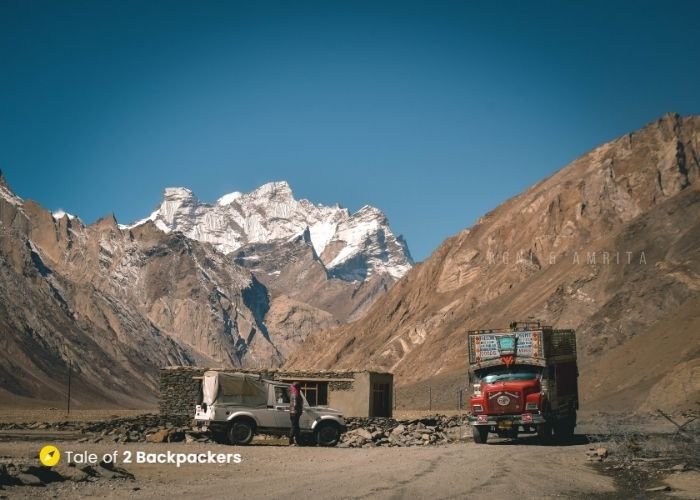
Public Transport to reach Zanskar Valley
Shared taxis are available these days in all the 3 routes mentioned above.
Shared taxis to Kargil from both Leh and Srinagar are easily available. You will also get shared taxis to Padum from Kargil.
Shared taxis from Leh to Padum via Shinge La and Manali to Padum via Shinku La Pass are fewer in numbers and you have to inquire beforehand and book your seats.
What is the best time to visit Zanskar Valley?
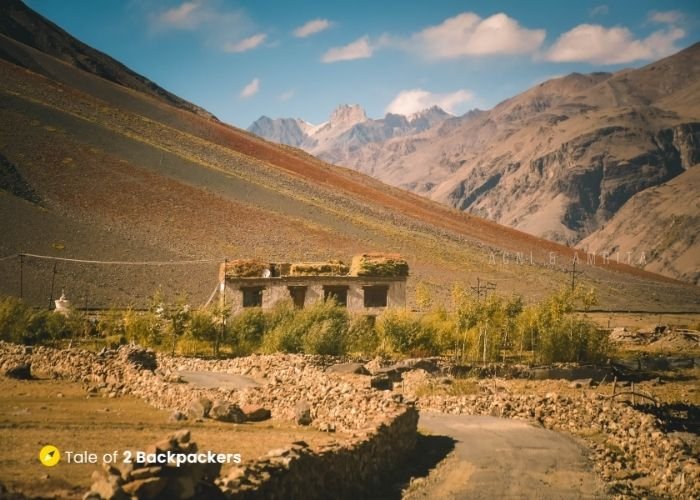
The best time to visit Zanskar Valley is during the summer months. And summer here means the months between June to September. During this time, the temperature remains pleasant. The mornings are usually bright and sunny and the evenings are cool, without being chilling. The roads to Zanskar also remain open during these months.
October is a shoulder season. During October, the temperature dips. The mornings are cooler, but evening and night tend to get quite cold. Also, I would recommend you to visit Zanskar within the first 2 weeks of October. After that, the weather becomes quite unpredictable and there are chances of the roads getting closed due to snowfall.
We visited Zanskar Valley during October. We had great weather and clear blue skies during our entire trip. But two days after we returned to Leh from Zanskar, we heard that both the Shingay La and Shinku La Pass had been closed due to snow. So I am saying it once again, if you want to visit during October, it is better to do so within the first 2 weeks.
Where to stay in Zanskar Valley?
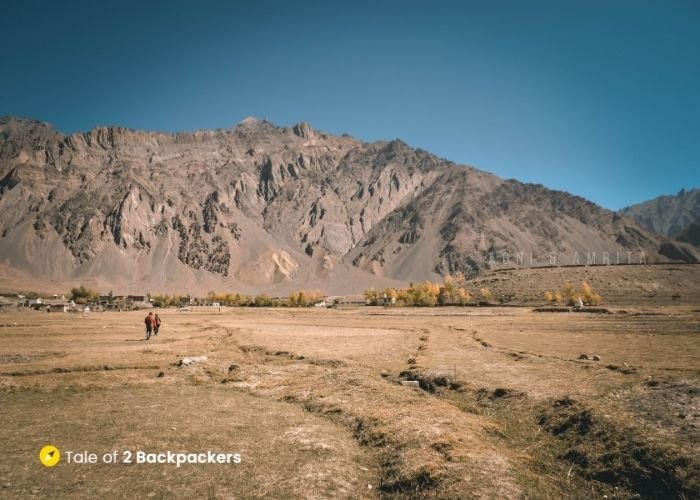
For your first time in Zanskar Valley, you will probably base your stay at Padum and then explore the area. Padum is the main town of Zanskar Valley. It is a small town having a few hotels and guest houses.
You can also stay at homestays located in villages around Padum. We stayed at a homestay at Tsazar near Padum.
While travelling to and from Zanskar Valley, we recommend you to make night stays on your way. Here are a few recommendations for night stays on the way to Padum.
Kargil – Padum Road
You can stay at Panikhar, Parkachik or Rangdum. There are homestays available at all these places.
Leh – Padum via Singe La Pass
If you start early from Leh, you can reach Padum in a day. However, if you want to take a break at night, you can stay at Lingshed village. Lingshed has a few homestays.
Manali – Padum via Shinku La Pass
Start early from Manali and cover as much distance as you can on the first day itself. You can stop for the night at Kurgiakh or travel forward to Purne. If you stop at Purne, you can plan a trek to the Phugtal Monastery as well.
What to do in Zanskar Valley?
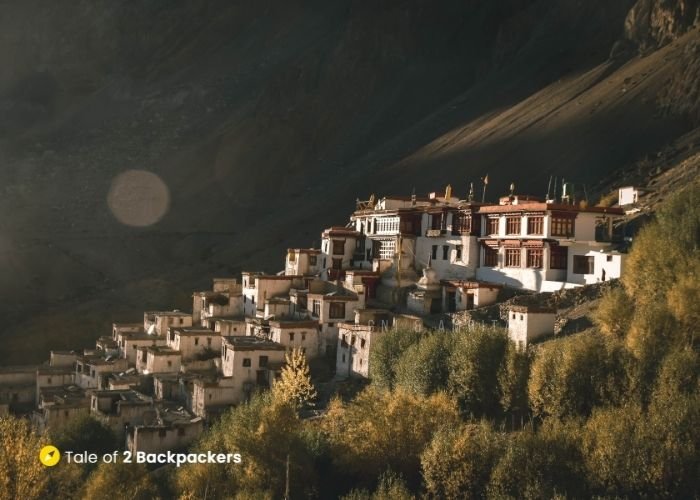
Now that you have reached Zanskar Valley, you will probably want to do some sightseeing. There are a lot of things to see and experience in Zanskar Valley. However, for the first time, you can definitely do the following:
- Phugtal Monastery Trek
- Visit the monasteries in and around Padum
Zanskar is one of the places where traditional Tibetan Buddhism is still practiced. And there are beautiful monasteries around Padum. I will list here the monasteries that you should not miss around Padum-
- Zangla Palace and Nunnery
- Stongdey Monastery
- Karsha Gompa
- Sani Gompa & Sani Lake
- Dzongkhul Monastery
- Pibiting Monastery
- Stakrimo Monastery
- Statue of 5 Dayani Buddha
- Bardan Monastery and Muney Monastery (These can be done on your way towards Phugtal Monastery)
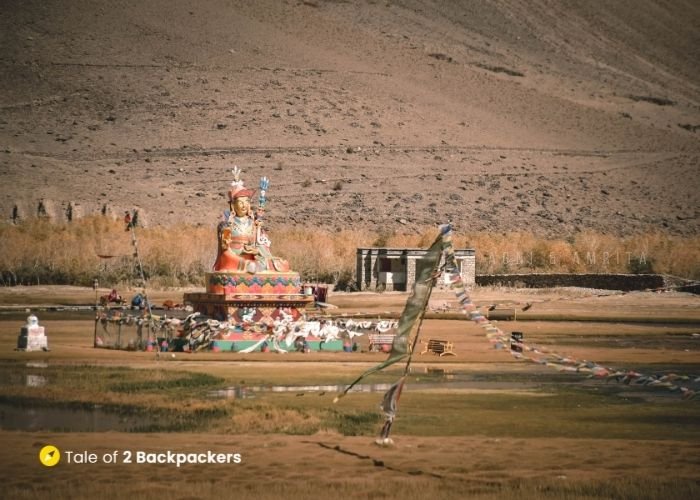
- Visit the local villages
- Hiking and trekking
There are numerous beautiful trekking trails in Zanskar Valley, the most famous being the Chadar Frozen River trek taking place in the winter months of January and February.
Suru Valley is also gorgeous in its own right. So, if you are travelling through the Kargil – Padum Road, then we recommend you to take your time and explore a bit around Suru Valley as well.
Acclimatization in Zanskar Valley
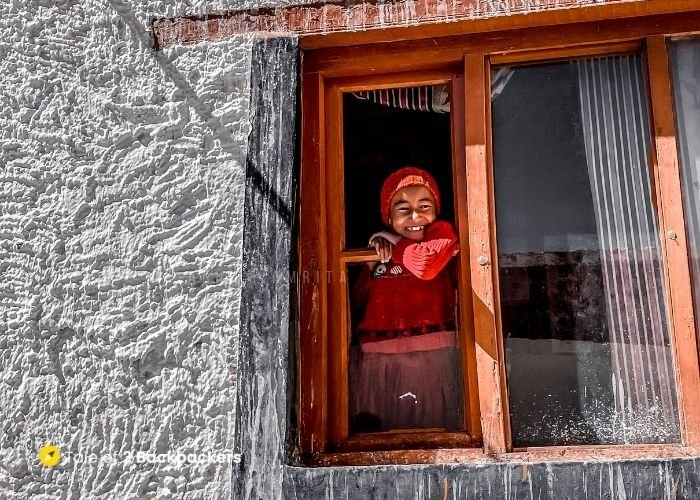
Just like Ladakh, acclimatization is quite important in your Zanskar trip. Padum is located at a similar altitude to Leh. If your body is not ready for the higher altitude, then your trip will be spoiled. So please take acclimatization seriously.
- If you have flown into Leh, spend at least one entire day in Leh before heading towards Zanskar Valley. Also, it is better to take stops in your journey. Here are a few tips for better acclimatization –
- Drink enough water and keep your body hydrated.
- Try to avoid sleeping at high altitudes.
- Refrain from tobacco and alcohol for these few days.
- Do not sleep during the day.
- While travelling to and from Padum, try to cover the distance in 2 days, stopping somewhere during the night. This goes for all the three routes I have mentioned above.
- Carry medicines for AMS.
- If you find any symptoms of AMS, visit a doctor. If your symptoms increase, it is better to descend to a lower altitude.
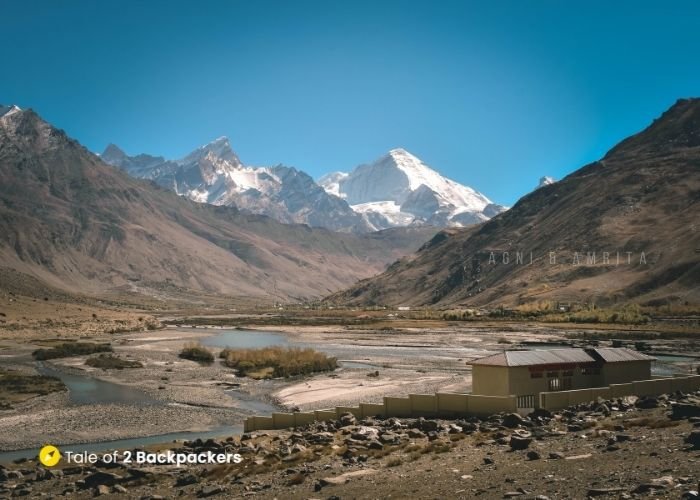
Medical Facilities in Zanskar Valley
Leh and Kargil have proper medical facilities that include decent hospitals and doctors. Padum also has a good hospital where you can visit if need arises. However, the hospital at Padum is the only hospital you will find in Zanskar Valley.
When we visited Phugtal Monastery, there was a bike accident. The patient had to be taken to Padum for treatment.
What to Pack for a Zanskar Valley Trip?
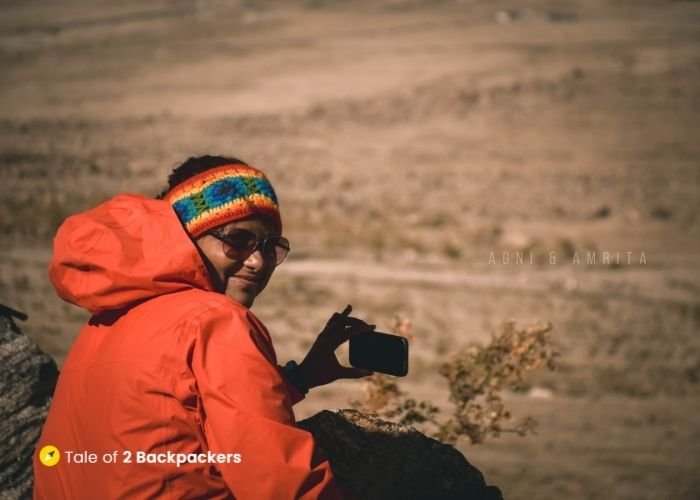
- Let us first talk about clothes. During the summer months between June to September, carry cotton clothes, light woolen and a jacket. The mornings are usually quite sunny and warm.
- For October, carry enough woolen and jackets. Also carry gloves, socks, scarfs and woolen caps. The evenings get quite cold during this time.
- If you are visiting Zanskar during the winter, you have to carry enough warm clothes, thermals, heavy jackets, socks, scarves, gloves and balaclava.
- Whenever you visit Zanskar, do not forget to carry a good sunscreen. The sun in the morning is particularly harsh and a good sunscreen is required.
- Carry Vaseline with you. Zanskar is a dry region and Vaseline can be a lifesaver there.
- Also, please do not forget a cap or hat. It will help protect you from the harsh sun rays during the day.
What to eat in Zanskar?
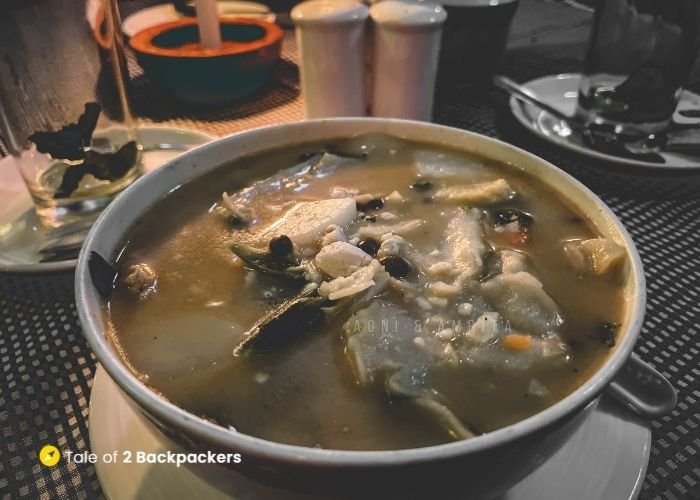
At Zanskar, you can try Tibetan dishes. There are small restaurants at Padum Market that serve good Tibetan dishes. The dishes you can try in Zanskar are:
- Tingmo – Tibetan bread
- Thentuk – a soupy broth containing noodles, vegetables, chicken and more
- Mokthuk – A broth containing Noodles and momos – it is like thukpa having momos in it.
- For drinks, you can try butter tea. It really keeps you warm. However, butter tea is an acquired taste.
If you want to have North Indian dishes, then there is one restaurant at Padum Market serving North Indian fares. The samosas are really tasty in that restaurant.
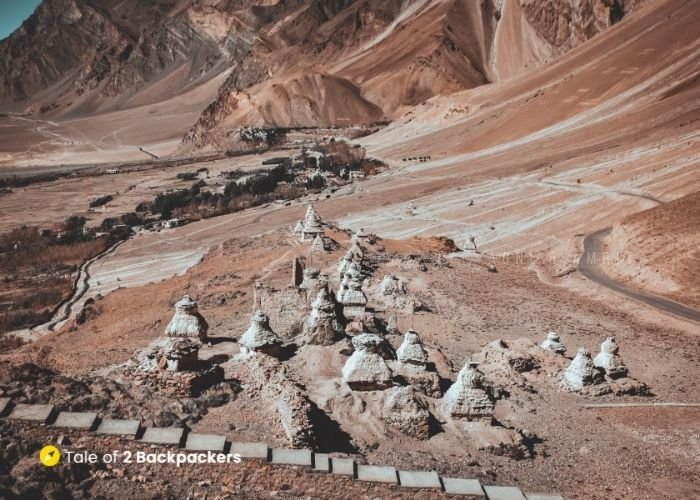
Zanskar Valley Trip (FAQs Answered)
Zanskar Valley is definitely worth your time. The valley, tucked in a remote part of Ladakh is both naturally beautiful and culturally enriching. The landscape of Zanskar is absolutely stunning with rugged mountains, barren browns and beautiful monasteries located in remote locations. While Zanskar is known for its stark landscapes of a cold desert, Suru Valley is famous for its lush greenery. You will definitely not be disappointed in your Zanskar trip.
Zanskar Valley is known for its high mountain passes, mountains and beautiful landscape. The place is also culturally enriching. It is one of the few places that still practices the ancient Tibetan Buddhism traditions. There are a number of beautiful Monasteries in Zanskar Valley. The Phugtal Monastery, one of the most secluded monasteries in India is located in Zanskar Valley.
The language of Zanskar is Zangskari.
The best time to visit Zanskar Valley is the summer months between June to September. During this time, the weather remains pleasant. October is the shoulder season, but we would recommend you to visit within the first 2 weeks of October. Winters are extremely cold in Zanskar Valley and temperature often dips down to -30-degree celcius. Also, the roads to Zanskar valley gets closed down during the winter due to snowfall.
There are only 2 petrol pumps at Padum. You will not find any other petrol pumps elsewhere in Zanskar Valley. You will also not find any petrol pumps on your way to Padum to Kargil or Padum to Leh or Padum to Manali.
There is one ATM at Padum Market. Please remember to carry enough cash in Zanskar Valley. Cards, wallets and UPI are usually not accepted at the local shops, petrol pumps and restaurants.
Only Postpaid connection works in Ladakh. You will get BSNL and Jio connections almost everywhere in Zanskar. Our Airtel Postpaid did not work in Zanskar Valley, not even in Padum. Jio worked fine. The Internet, however, is slow and intermittent once you are out of Padum town.
Zanskar Valley in Photographs
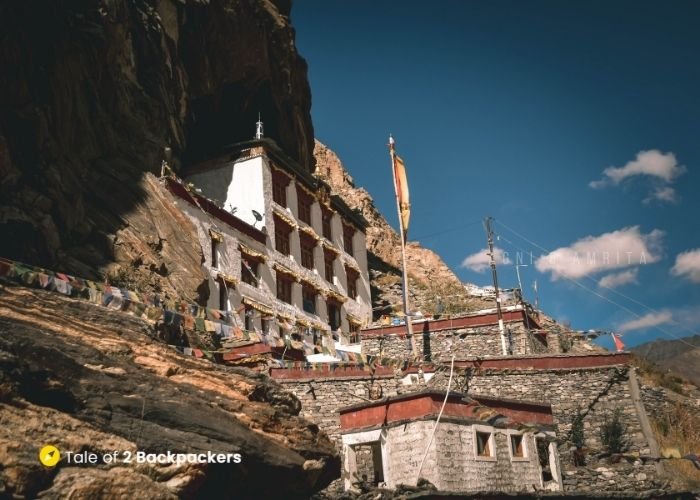
Did you like the post? If you have found this useful, please share this with your family, friends and neighbours.
Do check out our YouTube Channel for travel videos!

Agni Amrita
Related posts.

Hunderman – Ghost Village near Kargil with Museum of Memories
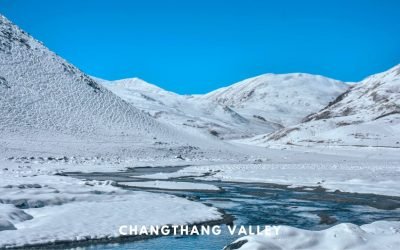
A Trip to Changthang Valley in Ladakh and a Failed one to Tso Moriri
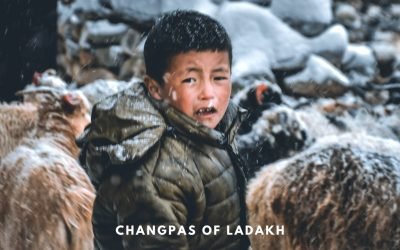
Changpa Tribe of Changthang, Ladakh – The Story of Pashminas
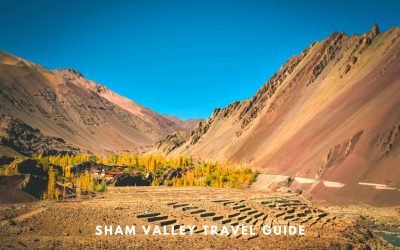
Sham Valley in Ladakh – A Complete Travel Guide
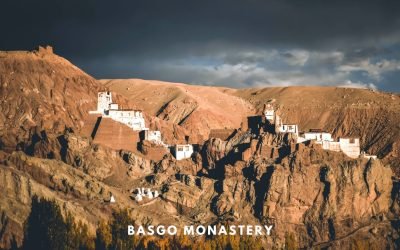
Basgo Monastery, Ladakh – Ruins of Palace and Fort
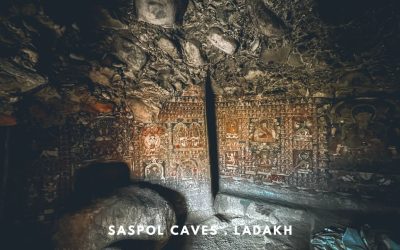
Saspol Caves – Best-kept Secret of Sham Valley, Ladakh
13 comments.
Very helpful, thank you. I trekked the Leh-Padum-Darsha route in 1984. Spectacular! I wonder if the Darsha-Padum road is completed now? Is there a separate path for walking and for ponies over the Shinkun-la other than the roadway? Or do pony caravans follow the road? Many thanks.
Hey Robert! I am so glad to know that you trekked the route way back in 1984. I am a bit envious too! The Darcha-Padum road is being made, though it is not completed. The road conditions are rough. As of now, we did not see any ponies or pony caravan moving on the road. There might be a different route.
Planning a road trip to Zanzkar valley this October, any important tips you can provide, we are planning to drive to Srinagar and then to Kargil to Padam do you have any suggestions for that
First of all, if you are planning in October, make sure to do it in the first week itself. Later, the place might get snowfall and you might get stuck at various places. Also, please read our blogs. We have covered almost all our travel tips there. And if you have any specific queries, we will be happy to answer them. Have a safe and wonderful trip.
How to find proper transport for Zanskar? Where to find car (with/without driver) for a 5 days long trip? Is there an option to find taxi from Padum?
Hello Chris! Thanks for reading our blog. You will get car with driver from Leh for Zanskar trip. You will also get taxis from Padum for day trips. Please send us an email for more details on transportation in Zanskar Valley.
Very helpful post! Are permits required to visit Zanskar?
Thank you Niranjan. No permits are required for visiting Zanskar.
Hello, I want to plan a 7 days trip to Leh and Zanskar. Will you be able to help me here?
Sure, we can help. Please drop us a mail at info [@] taleof2backpackers [.] com
Kindly let me know if one needs special passes (inner line permit etc.) for self & private vehicle to visit Zanskar. Thanks.
Nice Article
Submit a Comment Cancel reply
Your email address will not be published. Required fields are marked *
Submit Comment
This site uses Akismet to reduce spam. Learn how your comment data is processed .
Pin It on Pinterest

Zanskar Valley: The Ultimate Travel Guide and Itinerary
Table of Contents
Tucked away in the remote corners of Ladakh, Zanskar Valley is a place of breathtaking beauty and sheer adventure. Nestled between the mighty Himalayas and the Zanskar mountain range, this valley is a paradise for nature lovers and thrill-seekers alike. Its pristine wilderness, rugged landscapes, and captivating culture offer an unmatched travel experience.

Geography & Climate:
- Zanskar is situated in the eastern part of the Indian state of Jammu and Kashmir.
- It is surrounded by high mountain ridges on all sides, effectively cutting it off from the rest of the world for several months each year due to heavy snowfall.
- The valley experiences harsh winters with temperatures dropping to as low as -30 degrees Celsius. However, summers are quite pleasant with temperatures ranging from 15 to 30 degrees Celsius.
Culture & Lifestyle:
Zanskaris are known for their simple yet vibrant lifestyle. Predominantly Buddhist, the region is dotted with numerous ancient monasteries. The locals are warm, welcoming, and always ready to share tales of their unique culture and traditions.
Adventure Opportunities:
- Chadar Trek: An exhilarating winter trek over the frozen Zanskar River.
- Rafting: Experience the thrill of white-water rafting in the Zanskar River during summer.
- Mountain Biking: Ride through some of the world’s most challenging terrains.
Now that you have a basic understanding of Zanskar Valley, let’s dive into the specifics of planning your trip!
Preparation for Zanskar
When it comes to preparing for a trip to Zanskar Valley, there are a few key points to consider. This is not your everyday vacation spot and the journey requires careful planning. But don’t worry, we’ve got you covered.
- Weather: To enjoy the best of Zanskar Valley, you should be aware of the weather conditions. The region experiences harsh winters, so the best time to visit is from June to September, when the weather is more pleasant.
- Health Precautions: Due to its altitude, Zanskar Valley can pose a risk of altitude sickness. Take the necessary medication and give yourself time to acclimatize.
- Equipment: Don’t forget to pack essential items like warm clothing, trekking gear, sunblock, and other necessary supplies.
Note: Always remember to respect the local culture and traditions of the Ladakhi people residing in Zanskar Valley.
With these tips in mind, you are ready to embark on an unforgettable journey to Zanskar Valley!
Getting to Zanskar?
How to reach zanskar from kargil.
Nestled in the heart of the Himalayas, reaching the remote Zanskar is an adventure in itself. Being located at a considerable distance from the nearest commercial airport and railway station, the journey to this secluded paradise mostly involves road travel. From Kargil, one of the nearest towns with significant connectivity, you have a couple of options to reach the Zanskar Valley.
By Road:
- Bus: There is a bus service from Kargil to Padum (Zanskar’s administrative center) which runs twice a week. This journey takes around 14-16 hours.
- Private Vehicle/Taxi: You can hire a private vehicle or taxi from Kargil. The journey time is the same as the bus but it provides more flexibility and comfort.
By Trek:
Seasoned adventurers might opt to trek from Kargil to Zanskar Valley via the famous Suru Valley. This challenging and scenic trek takes approximately 5-6 days.
Note: The road to Zanskar Valley is usually closed during winter due to heavy snowfall. It is best to plan your trip between June and September, when the roads are open and the valley is at its scenic best.
How to reach Zanskar from Manali?
Planning a trip to the mystical Zanskar Valley? Wondering how to navigate the beautiful yet challenging terrain from Manali? Don’t worry, we’ve got you covered. Let’s embark on this exciting journey together!
- One of the most adventurous ways to reach Zanskar Valley from Manali is by road. It’s a matchless experience driving through the breathtaking landscapes, crossing high altitude passes, and witnessing the sublime beauty of nature.
- The overall distance is approximately 500 km that takes around 14-16 hours depending on the condition of the roads. The route goes via Rohtang Pass, Gramphu, Kokhsar, Tandi, Keylong, Jispa, Darcha, Zing Zing Bar, Baralacha La, Sarchu, Gata Loops, Nakee La, Lachulung La, Pang, More Plains, Tanglang La, Upshi, Karu, Leh, and then finally to Zanskar.
- Road conditions can be quite challenging, hence, a sturdy vehicle like an SUV or a good bike is recommended. Also, keep in mind that the Manali-Leh highway opens up for tourists from June to October.
How to reach Zanskar from Leh?
Encompassed by the mighty Himalayas and draped in the sheer beauty of the rugged landscapes, Zanskar is a breathtaking destination nestled in the Indian state of Jammu and Kashmir. One of the most exciting aspects of planning a trip to this idyllic haven is the journey itself. Here’s a quick guide on how to reach the Zanskar Valley from Leh.
Note: The journey to Zanskar is part of the adventure, filled with scenic vistas, challenging terrains, and a true sense of exploration. Be prepared for an exciting and memorable travel experience.
- By Road: The most adventurous and preferred way to reach Zanskar is by road. It’s a 12-hour drive from Leh to Padum, the heart of the Zanskar valley. You can hire a taxi or opt for a JKSRTC bus.
- By Trek: For the thrill-seekers, a 10-day Chadar trek over the frozen Zanskar River during winter is an unforgettable experience.
Best time to visit Zanskar
When planning a trip to Zanskar, it’s essential to consider the season. The region’s harsh, unpredictable climate can significantly impact your travel experience.
Here are the best times to visit Zanskar:
- Summer (June to September): This is the ideal time to visit Zanskar. The weather is pleasant, the roads are clear, and the valley is in full bloom. Most trekking routes, including the famous Chadar Trek, are open during this time.
- Winter (December to February): This is a great time for adventurous souls who want to experience the thrilling Chadar Trek. However, this is also the coldest season, with temperatures dropping to -30°C. It’s important to be well-prepared for the harsh weather.
Note: Zanskar is closed for tourists from October to May due to heavy snowfall and road blockages. Make sure to check the current weather conditions and road status before planning your trip.
Regardless of the season, Zanskar Valley offers breathtaking beauty and unforgettable experiences.
Accommodation Options in Zanskar Valley?
Here are a few recommendations: short on places to rest your weary head. From guest houses to homestays, this region offers a variety of lodging options.
- Hotel Zanskar Continental: This is a budget-friendly hotel offering basic amenities and a decent place to rest.
- The Kargil: For a more luxurious stay, consider The Kargil. The hotel offers beautiful rooms with modern amenities and a stunning view of the valley.
- Zanskar Home Stay: If you’re interested in experiencing the local culture, consider a homestay. Zanskar Home Stay offers a warm and hospitable environment.
Remember, accommodation can fill up quickly during the peak tourist season. So, it’s advisable to book your stay well in advance.
Note: The availability and quality of accommodations can vary. So, it’s always a good idea to check recent reviews before booking.
Food and Drinks in Zanskar Valley
One of the many facets of the Zanskar Valley that never fails to thrill visitors is its unique and flavorful cuisine. The harsh climates and challenging terrains have shaped the eating habits of the locals, who primarily depend on barley, meat, and dairy products. However, visitors can also enjoy a range of dishes that cater to diverse palates.
“Food is symbolic of love when words are inadequate.” -Alan D. Wolfelt
Here are some must-try dishes and drinks when you tour Zanskar Valley:
- Thukpa: A noodle soup that is a staple across Ladakh and Zanskar.
- Skyu: A traditional dish made from wheat dough and meat or vegetables.
- Chang: A popular local brew made from barley.
These local specialties not only provide nourishment but are also an intrinsic part of the cultural experiences that Zanskar Valley offers. However, during peak tourist seasons, several restaurants cater to a wider range of cuisines, including North Indian, Tibetan, and even some continental delicacies.
Regardless of your culinary preferences, the food and drink of Zanskar Valley are sure to leave you with unforgettable memories of your journey.
Exploring the Culture of Zanskar Valley
Zanskar Valley, nestled in the heart of the Indian Himalayas, is not just a paradise for nature enthusiasts but also a hub for culture vultures. The region is known for its rich heritage, vibrant festivals, and unique lifestyle that has remained unaltered for centuries.
The Vibrant Festivals
One of the highlights of Zanskar culture is its colorful and joyous festivals. The valley is particularly vibrant during these occasions, with locals coming together to celebrate with traditional music, dance, and food. Two of the most notable festivals are:
- Karsha Gustor: This is held in the largest monastery of Zanskar, Karsha Monastery. The festival, taking place in July, celebrates the victory of good over evil with masked dances known as Chaam.
- Dalai Lama Festival: This festival is held in the honor of the Dalai Lama’s visit to the valley. It is a grand occasion with sermons, prayers, and processions.
The Unique Lifestyle
The locals of Zanskar Valley, known as Zanskaris, lead a simple yet unique lifestyle. Much of their lives are shaped by the tough geographical conditions. However, they are known for their warmth and hospitality.
The Zanskaris have found ways to adapt and thrive in the harsh conditions of the Himalayas, making their lifestyle a testament to human resilience and adaptability.
Traditional Art and Crafts
Zanskar Valley is also known for its traditional art and crafts. The locals are skilled artisans, and they create beautiful handicrafts and artifacts, often using materials available locally. The table below illustrates some of the most popular traditional crafts of Zanskar Valley.
Exploring Zanskar Valley’s culture is a journey into a vibrant, resilient community that has preserved its traditions despite modern challenges. It offers a fascinating insight into the region’s past and present, making it a must-visit for any traveler seeking an enriching and unique experience.
Things to do in Zanskar Valley
Located in the remote corners of Ladakh, the Zanskar Valley is known for its rugged beauty and adventurous activities. From trekking to sightseeing, the valley has a plethora of experiences to offer. Here are some of the best things to do in Zanskar Valley:

- Trekking: With mountains all around, Zanskar Valley is a paradise for trekkers. The famous Chadar Trek on the frozen Zanskar River is a must-try for the thrill-seekers.
- Visiting Monasteries: The valley is home to several ancient Buddhist monasteries, showcasing the rich culture and traditions of the region.
- White Water Rafting: The Zanskar River provides a great opportunity for white water rafting. It’s an adrenaline-pumping adventure that shouldn’t be missed.
- Photography: The stunning landscapes of Zanskar Valley provide an ideal setting for photography. Capture the beauty of the snow-clad mountains, deep gorges, and vast barren lands.
“Zanskar Valley is not just a destination, it’s an experience. Each corner of the valley offers a unique adventure, making it a favorite among travelers seeking thrill and serenity.”
Remember, no matter what activity you choose, the magic of Zanskar Valley lies in its serene beauty and the tranquility that it offers. So, take a deep breath and let the allure of the place sink in.
Top attractions in Zanskar Valley
With its untouched landscapes and tranquil ambiance, Zanskar Valley is a paradise for nature and adventure enthusiasts alike. Nestled in the northernmost region of India, this valley boasts an array of attractions that are sure to leave every traveler awestruck. Let’s delve into the must-visit spots in this Himalayan haven.

- Phugtal Monastery: This cliffside monastery, accessible only by foot, is a unique spectacle of peace and spirituality. Its remote location adds a sense of adventure to the tranquil experience.
- Zanskar River: Known for the popular Chadar Trek in winter, the river offers an exhilarating white-water rafting experience in summer. A trip to Zanskar is incomplete without a visit to this majestic river.
- Drang-Drung Glacier: One of the largest glaciers in Ladakh, this stunning formation will leave you breathless. Don’t miss the spectacular view of the glacier from Pensi La pass.
- Zongkhul Monastery: Built into the rock face, Zongkhul Monastery offers panoramic views of the valley. Its murals and statues are a testament to the rich Buddhist culture in the region.
- Panikhar: For those seeking tranquility, Panikhar is a must-visit. This small village provides a spectacular view of the Nun and Kun peaks, and is a great spot for trekking.
Each attraction in Zanskar Valley has its own charm and allure, promising an unforgettable experience. Romantic, thrilling, serene or spiritual – whatever your preference, this valley has it all.
Mobile Network in Zanskar Valley
Remaining connected to the outside world while immersing oneself in the serenity of Zanskar Valley can be quite a challenge. The area is remote and the network coverage is sporadic at best.
However, fret not! There are a few service providers who manage to offer their services in this rough terrain.
Note: Coverage can vary based on the exact location within the valley and the weather conditions. It’s always advisable to inform your loved ones about the connectivity issues before you embark on your adventure to Zanskar Valley.
So, while you soak in the mesmerizing beauty of Zanskar Valley, remember that you might have to rely on good old-fashioned letters or satellite phones for communication. After all, a digital detox could be a significant part of your unique travel experience!
Safety Precautions in Zanskar Valley
As enchanting as it may be, Zanskar Valley is also known for its challenging terrain and unpredictable weather conditions. Therefore, it’s crucial to take proper safety precautions when planning your trip to this Himalayan paradise. Let’s dive into some safety measures you should keep in mind.
- Acclimatization: This high-altitude region can induce Acute Mountain Sickness (AMS). Spend a couple of days in Leh for proper acclimatization before heading to the Zanskar valley.
- Travel Insurance: Invest in comprehensive travel insurance that covers emergency evacuation, considering the remoteness of the area.
- Medical Kit: Carry a well-equipped medical kit with essentials like pain killers, band-aids, antiseptic creams, and altitude sickness medicines.
Note: Always remember, prevention is better than cure. Pay heed to your body’s signals and act promptly.
Furthermore, let’s talk about some additional precautions:
By following these safety measures, you can ensure an enjoyable and memorable experience in the breathtaking Zanskar Valley.
Tips for traveling to Zanskar Valley
Traveling to Zanskar Valley offers a unique opportunity to experience the untouched beauty of the Himalayas. However, to ensure a safe and enjoyable journey, there are some important tips you should keep in mind.
Understanding the Terrain
Zanskar Valley, nestled in the remote corners of Ladakh, is known for its rugged terrain. You’ll be navigating winding mountain roads, crossing icy rivers, and trekking through high-altitude trails. It’s essential to come prepared for the physical demands of this journey.
- Physical Fitness: Ensure you’re in good health before embarking on a trip to Zanskar Valley. A certain level of physical fitness is required to handle the rigors of high-altitude trekking.
- Acclimatization: Give your body time to adjust to high altitudes. Spend a couple of days in Leh or another base camp before proceeding to Zanskar Valley to prevent altitude sickness.
Packing Essentials
Packing appropriately is crucial for a trip to Zanskar Valley. Here are some essentials you shouldn’t forget:
- Warm Clothing: Temperatures can drop significantly in the evening, even during the summer.
- Medical Kit: Carry basic medications for altitude sickness, headaches, and stomach ailments.
- Hydration: Carry plenty of water and energy bars. Staying hydrated is crucial in high altitudes.
Travel and Accommodation
Planning your travel and accommodation in advance can make your journey smoother.
Remember, the infrastructure in Zanskar Valley is basic and limited due to its remote location. Prepare for occasional power outages and lack of luxury amenities.
- Travel: The roads leading to Zanskar Valley are often challenging. Hiring a local driver who is familiar with the terrain can make your journey safer and more comfortable.
- Accommodation: Book your accommodations in advance. Homestays are a popular option, offering a chance to experience local culture.
Lastly, respect the local culture and environment. Zanskar Valley is home to a rich cultural heritage and stunning natural landscapes. Let’s do our part in preserving this beautiful corner of the world for future generations.
Recommended Itinerary
Planning your Zanskar Valley trip can be a daunting task, given the plethora of attractions and activities the region offers. Here is a suggested itinerary to help you make the most of your visit:
In conclusion, a journey to Zanskar Valley is more than just a trip; it’s a life-altering experience that leaves one with unforgettable memories and a sense of accomplishment. So pack your bags, tie your boots and embark on this incredible journey of exploration and self-discovery in the enchanting Zanskar Valley.
About The Author
Mahendra Singh Solanki
Related posts.

Shinku La Pass: The Ultimate Gateway to Zanskar Valley

Phugtal Monastery: The Ultimate Travel Guide
Leave a comment cancel reply.
Your email address will not be published. Required fields are marked *
2itchyfeets
Travelling together!!!
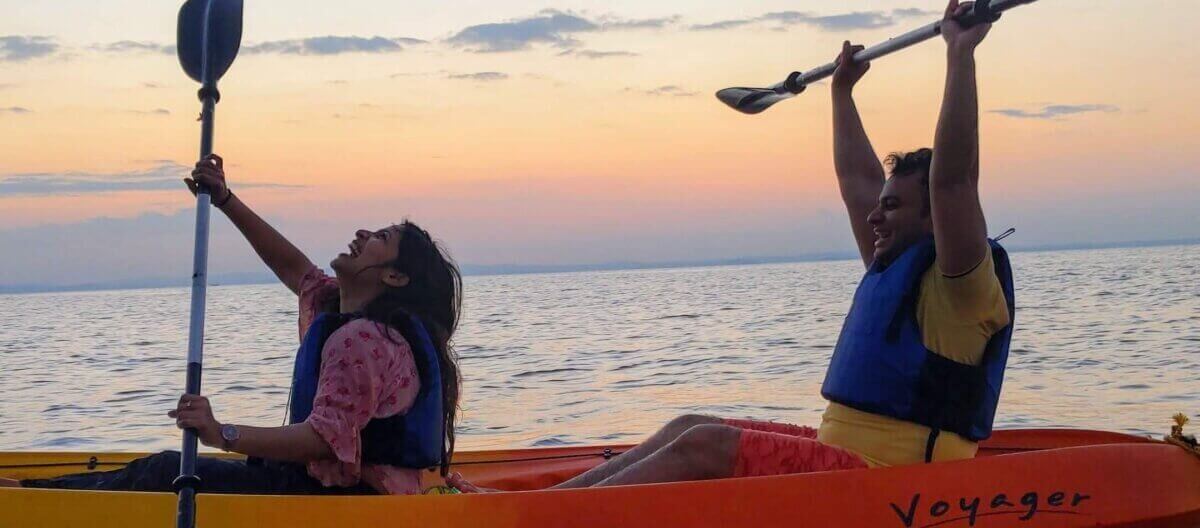
Complete guide to an ultimate trip to Zanskar Valley in Ladakh
Some places are about lifetime experiences, they are hard to reach but once you reach them they never come out of your mind. If you are also searching for one such place, Zanskar Valley hits the target.
Just 4-5 years ago, most of the places in Zanskar Valley were reachable only by foot as there were hardly any roads.
Though the roads are still not in good shape and the travel is long and bumpy, what you see, experience and feel are worth any struggle.
We have created this guide to help you plan a smooth trip to Zanskar Valley. All our budget details, itinerary, tips, and local contacts are included in this article.
But before you go through this guide, we want to tell you that Zanskar is an area with harsh weather conditions and a delicate environment. These areas are not sightseeing places. Travel here only if you love traveling and enjoy being out of your comfort zone with bare minimum facilities.
Also, read our Andaman Post to plan an epic trip to one of the most beautiful places in India.
Table of Contents
How to reach Zanskar Valley in Ladakh
By flight – We took a flight from Delhi to Leh. It takes less than an hour to reach Leh from Delhi by flight. After acclimatizing to Leh for a day, we reached Padum (Zanskar Valley) via Kargil by taking a taxi from Leh.
By road – Another way to reach Padum (Zanskar Valley) is by road from Manali. You can either drive your car (only if you have an SUV and you are an expert in driving in rough mountainous terrains) or rent a taxi to reach Padum (Zanskar Valley) directly from Manali.
Acclimatization in Leh
Leh is at a height of 11000 ft above sea level and due to the lack of oxygen, it is recommended to rest for a day especially if you are reaching by flight. Otherwise, mountain sickness can hit you hard. Sleep, hydration, and no physical activity are a must on your first day in Leh. You can also have a Diamox tablet daily for your first few days in Ladakh.
Itinerary to a trip to Zanskar valley
Day 1: Reach Leh and Acclimatize
Day 2: After breakfast, leave for Sham Valley Tour and Reach Kargil
Day 3 – 4: Explore Kargil and nearby Places.
Day 5: Leave for Zanskar Valley Tour, Explore places on the way like Suru Valley, Rangdum, etc., and reach Padum
Day 6: Explore Padum
Day 7: Leave for Phugtal Monastery and stay in Purne Village
Day 8: Leave for Sarchu and stay in a Camp at Sarchu Village
Day 9: Leave for Leh and Stay overnight
Day 10: Flight back home
Best time to visit
June to September is considered the best time to visit Zanskar Valley. Most of the roads are open during this time.
We went on this trip in the first week of August. The sun was harsh in the afternoons. Mornings and evenings were cold.
Do check the weather forecast before planning this trip. Avoid Monsoon season as the roads might be closed during that time.
Mobile connectivity in Zanskar
Only Postpaid connections work in Ladakh. In the Zanskar region, mostly BSNL and Jio networks work, and that too in particular areas.
Budget for a 9 Nights 10 Days trip to Zanskar
Accommodation – We stayed for 2 days in Kesaar Palace, 3 days in Hotel the Kargil, 2 days in Omasila Hotel in Padum, one day in Himalayan Homestay in Purne Village, and one day in Dorje camps in Sarchu.
Kesaar Palace Leh range between INR 5500 – 7500 per room (with breakfast), Hotel the Kargil range between INR 6500 – 12000 per room (with breakfast), Omasila Hotel Padum cost around INR 3500 per room (with breakfast and Dinner), Himalayan Homestay Purne cost around INR 1500 per person (Breakfast and Dinner) and Dorje Camps stay cost around INR 2500 per day (with breakfast, snacks, and Dinner).
So, for 9 night 10 days trip, expect to spend around INR 21000-28500 (for two people) on accommodation if you choose your stay in a similar range.
If you are on a budget, you can book your stays online in the range of INR 2000 – INR 3000 per day or even less. For a decent price of a property, prebook your stay at least 2 months in advance.
Transport – You can hire a taxi, take your car (if you have an SUV and experience in driving on tough mountainous terrains), or bike for this road trip. We rented a taxi from Leh for our 9-night 10 days trip. As we were traveling in a group of four, renting a taxi was not only comfortable but also saved us a few bucks.
Also for sightseeing in Leh, we spent around INR 3000. Airport pick-up and drop cost us around INR 3000 in total.
Expect to spend around INR 70,000 – 80,000 per taxi for 9 nights 10 days if you rent a taxi as we did.
Food – We carried Haldiram’s ready-to-eat food packets because there are very less or negligible eating options while you commute in Ladakh.
In Leh, there are many cafes and a variety of food. You can easily get a meal for INR 500-800 (two people).
In Kargil, we mostly ate in our hotel The Kargil.
In Padum, there are a few cafes/ local food joints where one can easily get a meal for INR 300-500 (two people)
In Purne and Sarchu, there are no options to eat outside. Your place of stay is the only option to eat.
Others – There is a ticket price for visiting a few locations like War Memorial and Monastery Museums that range between INR 50 – 100 per person.
How to Book a taxi for Zanskar Trip
As per Ladakh Taxi Union Rules, for sightseeing in Leh, you need a Leh number Taxi and for sightseeing in Kargil and Zanskar Valley, you need a Kargil number taxi. For Leh Tour, we booked a taxi with a local Mr. Otsal. You can contact him at +91-9622951297.
For the rest of the trip, we booked a Kargil number taxi from Ayub Bhai, a local in Kargil. His smooth driving and knowledge of the routes took this trip to another level for us. If you also want to book your taxi with him, contact him at +91-8899942881, 9541254816 (his uncle Javed Bhai).
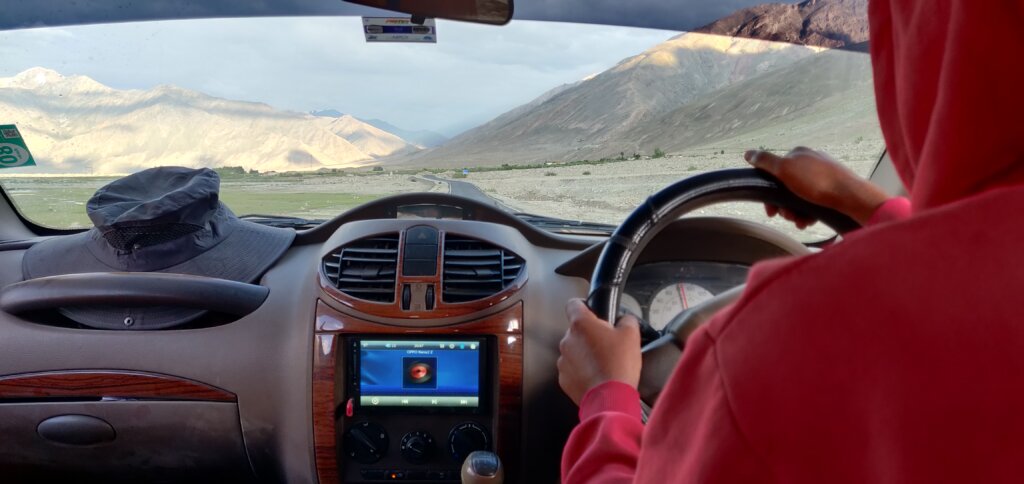
Daywise breakup of our trip to Leh, Kargil, and Zanskar Valley
Day 1 Reached Leh
- We reached Leh early in the morning (around 6 am). Took a taxi from Airport to our hotel.
- Check-in at the hotel. We stayed in hotel Kesaar Palace in Leh. Built in Ladakhi-style with rooms having a view of Stok Kangri, Shanti Stupa, and Leh Palace, hotel Kesaar Palace is a comfortable stay equipped with all the modern facilities. For booking your stay with Kesaar Palace Leh, contact them at +91-9953157209.
- To acclimatize better and avoid mountain sickness, hydrate yourself well and rest as much as possible on your first day in Leh.
- We rested till evening. We were feeling fine, so we went for a walk up to Leh market which is around 5 minute walk from Hotel Kesaar Palace. We had Coffee and Sandwiches at Brazil Café in Leh Market.
- After coming back to our hotel, we hired a taxi (with the help of our hotel staff) to visit Leh Palace and Shanti Stupa. At Shanti Stupa, avoid taking the stairs on your first day in Leh. Vehicles can go up to the parking from where Shanti Stupa is a short and easy walk. The restaurant at Shanti Stupa serves ultimate momos.
- Dinner at our hotel.
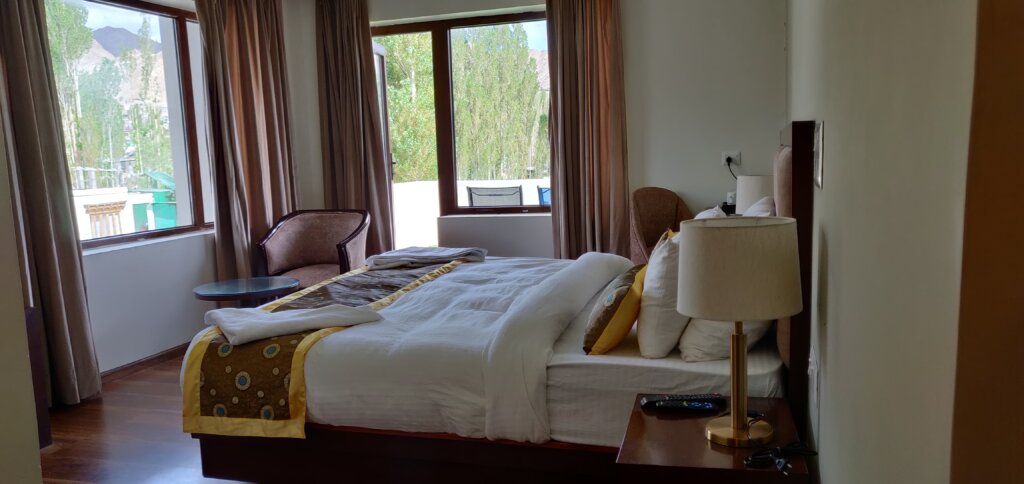
Day 2 Reached Kargil
- After Breakfast at our hotel, we left for Kargil in the taxi we had booked for this entire trip.
- If you are leaving early you can visit Gurudwara Pather Sahib, Magnetic Hills, Sangam, Basgo palace, Likir Monastery, and Alchi Monastery along the way. This tour is known as Sham Valley Tour. If you are starting late from Leh, it is better to skip some of these locations else it might delay you for the journey ahead.
- Visit Lamayuru Monastery along the way which is one of the oldest Monasteries of Ladakh. The landscape at the village of Lamayuru is similar to the moon’s surface and famously known as Moonscape/ Moonland.
- Visit Heniskot/ Zbayul Village along the way which is also known as the hidden village. It requires walking for 10-15 minutes up on a hill to get a glimpse of the hidden village. As it went already dark before we reached the village, we could not go to the village but we visited a Museum which looked no less than a haunted house and had a collection of utensils, instruments, and other things of the old times. One can also visit this village from Kargil.
- Visit Mulbekh Monastery along the way. Here a 30 feet statue of Buddha is carved on an enormous slab of stone.
- Reached Kargil around 11:00 PM and checked in at Hotel The Kargil. Equipped with all the modern amenities, hotel The Kargil is one of the best hotels in Kargil. For booking your stay with hotel The Kargil, contact them at +91-9811995752.
- Dinner at Hotel the Kargil.
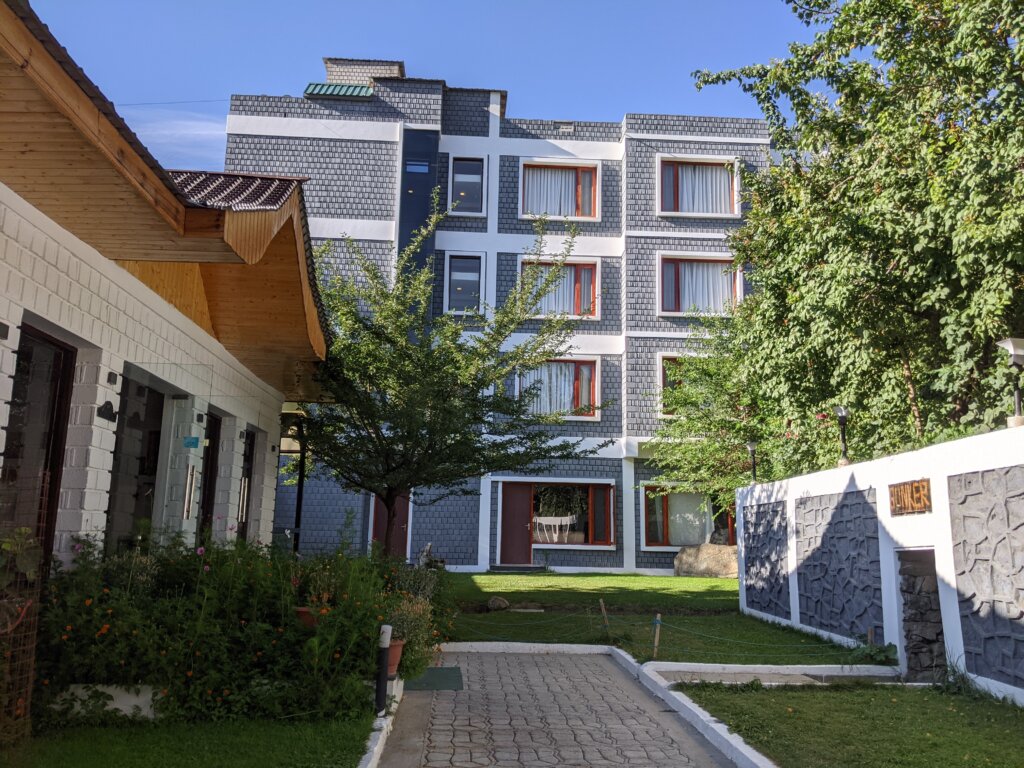
Day 3 Explore Kargil
- After Breakfast at Hotel the Kargil, we left for Drass which is around 60 km from Kargil. It is the 2nd coldest inhabited place on earth. The journey up to Drass is smooth and beautiful.
- Visit Kargil War Memorial along the way.
- Drive up to Mushko Valley from Drass for its wildflowers and beautiful views. Spend some time near Drass River in Mushko Valley.
- After coming back to Kargil, visit the LoC viewpoint in the evening. From the LoC viewpoint, one can see Indian and Pakistani bunkers. Do not forget to have Kashmiri Kahwa from a tea stall here.
- Further 2 km from the LoC viewpoint, visit Hunderman Village, the last village in India. We visited a 200-300-year-old house in the village. The way it was built gave a deep insight into the lives of the local people of the area. The Museum inside this house has a collection of ornaments, utensils, clothes, games, coins, money, and letters from the people of this area. If you have a guide or a local with you here, you will be mesmerized by the stories they tell. We were lucky to get accompanied by our host Zaheer from Hotel the Kargil.
- Dinner at Hotel The Kargil.
Day 4 Trekking in Kargil
- We were having breakfast in our hotel when its owner Zaheer joined us and while he was telling us about all the things Kargil has to offer, he mentioned a trek to a Monastery that passes through narrow gauges with water streams flowing through it. He then offered to accompany us on the trek so that he could also live some of his childhood moments again. How could we not hop on this opportunity of going deep in Kargil and that too with a local!!! And the next moment we were on to this adventure. Urgen Dzong Trek is around 5-6 km (to and fro) and it takes around 5-6 hours to complete this trek and come back. At the top, there is a small cave Monastery and multiple other caves where lamas are said to mediate for years. We went inside one of these caves and it was really hard to get inside and come out of it.
- After the trek, we came back to our hotel around 5:30 PM.
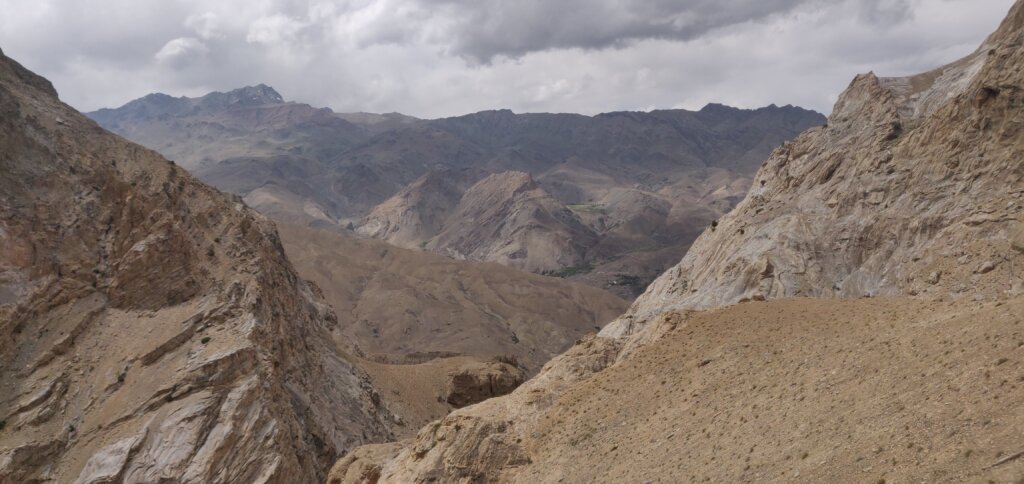
Day 5 Journey to Zanskar Valley
- We got our breakfast packed from our hotel and left early morning (5:30 AM) for Zanskar Valley.
- We stopped by Suru Valley and enjoyed the views of the largest peaks of the region, Nun and Kun.
- We visited Rangdum Monastery along the way. And ate our ready-to-eat Haldiram Lunch in the kitchen of Rangdum Monastery.
- We got to see one of the largest glaciers of Ladakh, the Drang Drung Glacier. It was a sight to behold.
- We visited Sani Gompa in Sani Village, just 6 km before Padum.
- We stayed in Hotel Omasila in Padum. Padum is the district headquarters of Zanskar and the base of the tourists visiting Zanskar Valley. Hotel Omasila is one of the best stays in Padum. For booking your stay with hotel Omasila, contact Norbu Bhaiya at +91-7889857547.
- Dinner at Hotel Omasila.
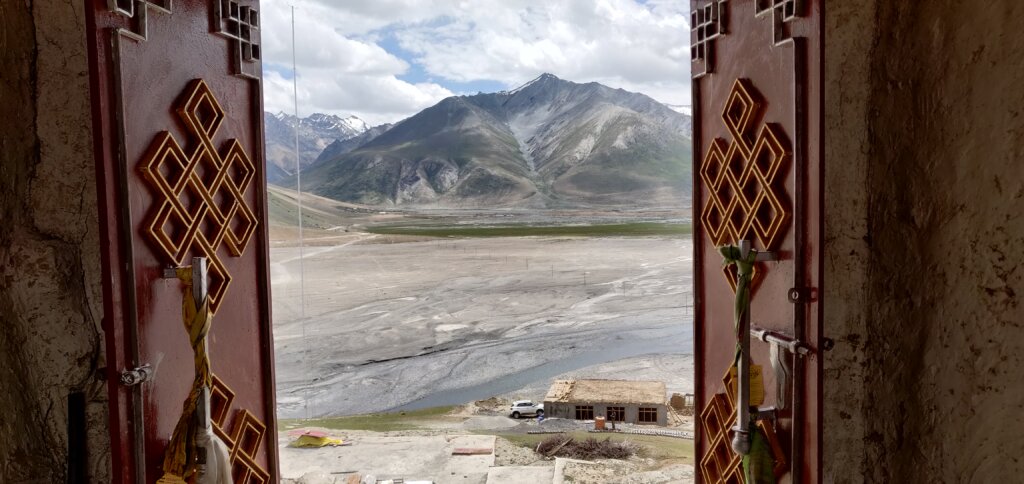
Day 6 Explore Padum in Zanskar Valley
- Sunrise at Guru Gompa which is just 10 minutes easy hike from Hotel Omasila. The views of the Zanskar valley from Guru Gompa are breathtaking.
- We visited Pibiting village after sunrise which is right there in between Guru Gompa and Hotel Omasila. It felt nice seeing the houses in the village made of stones and mud and people starting their day by taking their cattle for grazing.
- After breakfast at Hotel Omasila, we left for Karsha Monastery. Karsha is the largest monastery of Zanskar.
- Thereafter, we visited Chuchik Jal Nunnery which is the abode of nuns from Karsha Monastery. It was such a nice experience interacting with the nuns and kids out there.
- Visit Stackrimo Monastery, which is at the backside of Padum. The view from the Monastery is the widest one can have of the entire region.
- Lunch at Changthang Café in Padum Market. We had Palak Paneer Skew (Zanskari Dish), Mushroom Soup, Thupka, Veg Pizza, and Momos. The food has never tasted this good before.
- After lunch, we visited Stongdey Monastery which is built on a rocky hill to give panoramic views of the valley. Stongdey is famous for its festival which is held around the month of June-July every year. Monks wear their traditional big face masks and perform in the festival.
- Visited Zangla Palace, which is in ruins today but used to be the home of the king of the region. The palace is a 10 minutes hike from Zangla Village. The views of the Zanskar range from the Zangla Palace are sure to make you sit for hours.
- Visited Sheela Waterfall. We never thought Zanskar would have Waterfalls. It was nice visiting one.

Day 7 Trek to Phugtal Monastery
- After breakfast at Omasila Hotel Padum, we left for Phugtal Monastery.
- Visited Gyalwa Ringna along the way which is an ancient rock carving site in Padum. Five Dhyani Buddhas are engraved here on a rock.
- Visited Bardan Monastery along the way which is at a picturesque location.
- On the way to Phugtal, visited Ichar Village and Maitreya Buddha Statue safeguarding the Ichar village.
- Reached Cha Village and started the trek to Phughtal Monastery. There are two ways to reach Phugtal Monastery. One from Cha Village and the other from Purne Village. They run parallel to each other, separated by the Tsarap River in between. We went via Cha Village and came back via Purne Village. Our driver dropped us at Cha Village and waited for us at Purne Village. It takes around 3 hours to reach Phugtal Monastery from either side. The trek from Cha village is narrower and more difficult comparatively, so if you are not an experienced trekker, do take the other route. Orange hills stand in contrast to the turquoise-blue Tsarap River and the entire landscape is sure to give you Goosebumps.
- We had lunch at Hotel Gonpa in Phugtal Monastery. Hotel Gonpa is run by local monks and also provides stay facilities to tourists.
- Around 2500 years ago, Phugtal Monastery used to be only a cave where monks would visit and meditate for years. Gradually a monastery was built using mud and wood. Around 1200 years ago, Phugtal Monastery was rebuilt the way it is today.
- We went back to Purne Village and stayed in Himalayan Homestay.
- Watched the Milkyway galaxy and millions of stars at night in Purne.
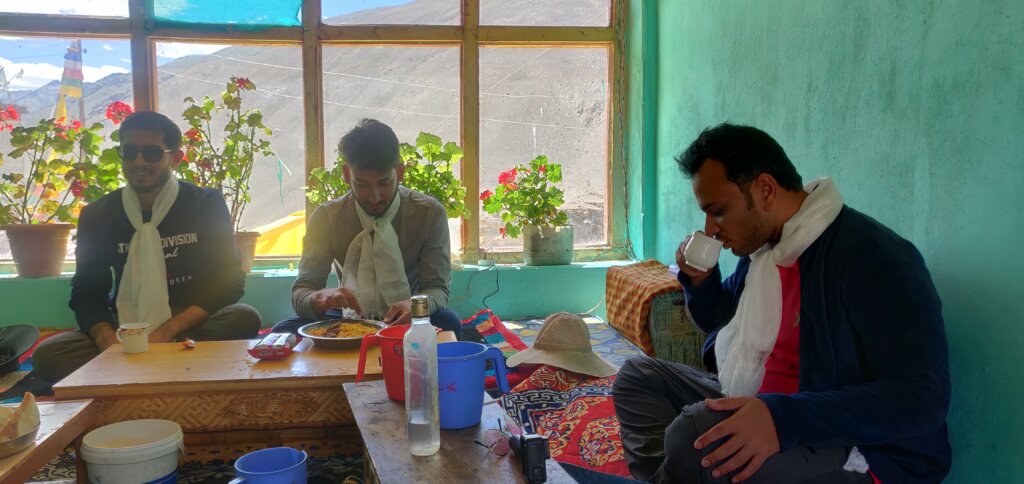
Day 8 Camps at Sarchu Village
- After breakfast, we left Purne Village.
- Reached Sarchu by noon and stayed in Swiss camps. Sarchu, located at 14,500 feet height marks the border of Himachal and Ladakh. A wide open area surrounded by rugged mountains from all sides, Sarchu is a nice place to spend a day at. We stayed in Dorjee Camps. The camps were clean and cozy with attached bathrooms. The facilities at Dorjee camps and the food they serve are impressive. For booking your stay with Dorjee Camps, contact them at +91-9418356382.
Day 9 Back to Leh
- After breakfast, we left for Leh.
- Checked in at Hotel Kesaar Palace in Leh.
- We roamed around Leh market and stuffed ourselves with loads of food.

Day 10 Back home
- Early morning flight back home
Virtual Tour to Leh, Kargil and Zanskar Valley
We have a YouTube Channel where we post our travel videos. We have posted videos from Leh, Kargil, and Zanskar Valley on our channel to help you plan your trip better.
Do watch these videos and let us know what you think of them. Also, if you like our videos, do subscribe to our channel. It really motivates us to create more such content.
Ultimate things to do in Leh
Things to do in Kargil
The journey from Kargil to Padum
Things to do in Padum
Trek to Phugtal Monastery
Staying in camps at Sarchu
Hope this guide helped you in making an amazing trip to Leh, Kargil, and Zanskar Valley. If you have any questions for us, do ask them in the comments.
Leave a Reply Cancel reply
Your email address will not be published. Required fields are marked *

- Trekking & Travel Events
- Travel Organizations
- Himalayan Treks
- Maharashtra Treks
- Karnataka Treks
- Travel Guides
- Weekend Getaways
- Trekking Tips & Advice
Zanskar Valley – Ulimate Travel Guide 2024
Table of Contents
Why Should you visit Zanskar Valley?
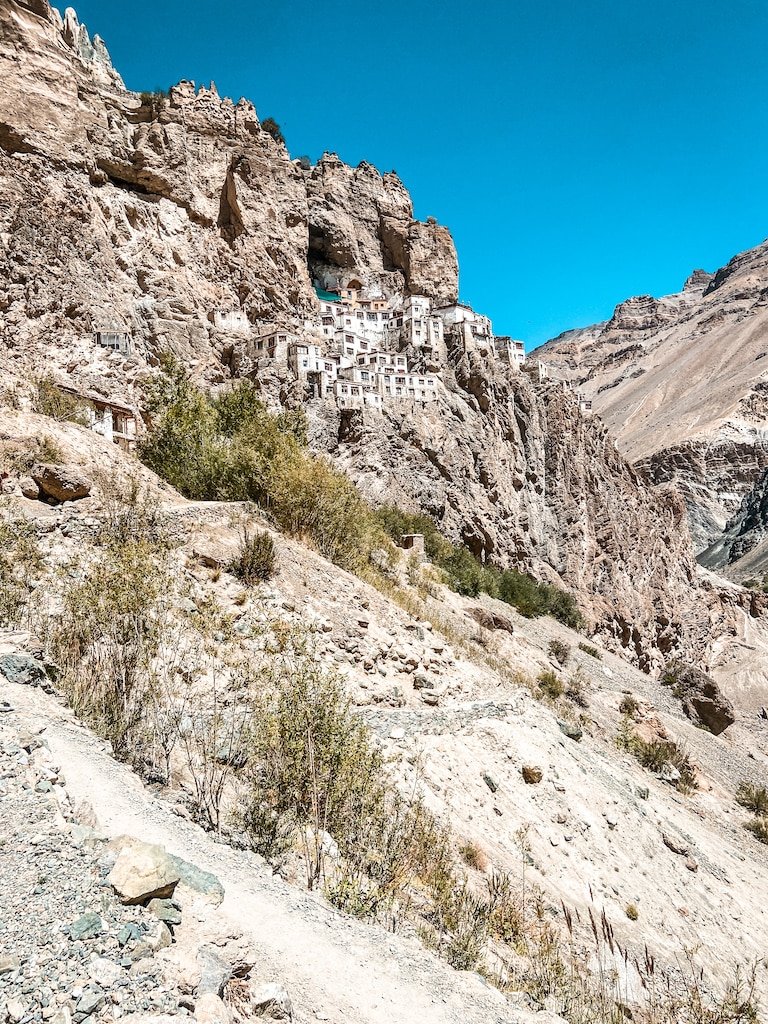
Zanskar Valley, when someone hears about this place, the only thing that usually comes to mind is the Chadar trek (a frozen river trek surrounded by snow capped mountains).
When one considers travelling to Ladakh, one only goes to places like Leh, Nubra valley, Stok, Turtuk, and Karzok.
It is like that introverted employee with all the excellent skills, knowledge, and the best attributes but lacks personal branding & doesn’t like to brag about himself. But there is so much more to Zanskar; it is one of the hidden gems in the union territory of Ladakh beyond Kargil district & Suru valley.
This place should be on top of your travel bucket list because of its rich heritage & culture, the warmth & hospitality of the people, the beautiful monasteries, the pure rawness & the beauty of the valley.
How to plan a trip to Zanskar via public transport?
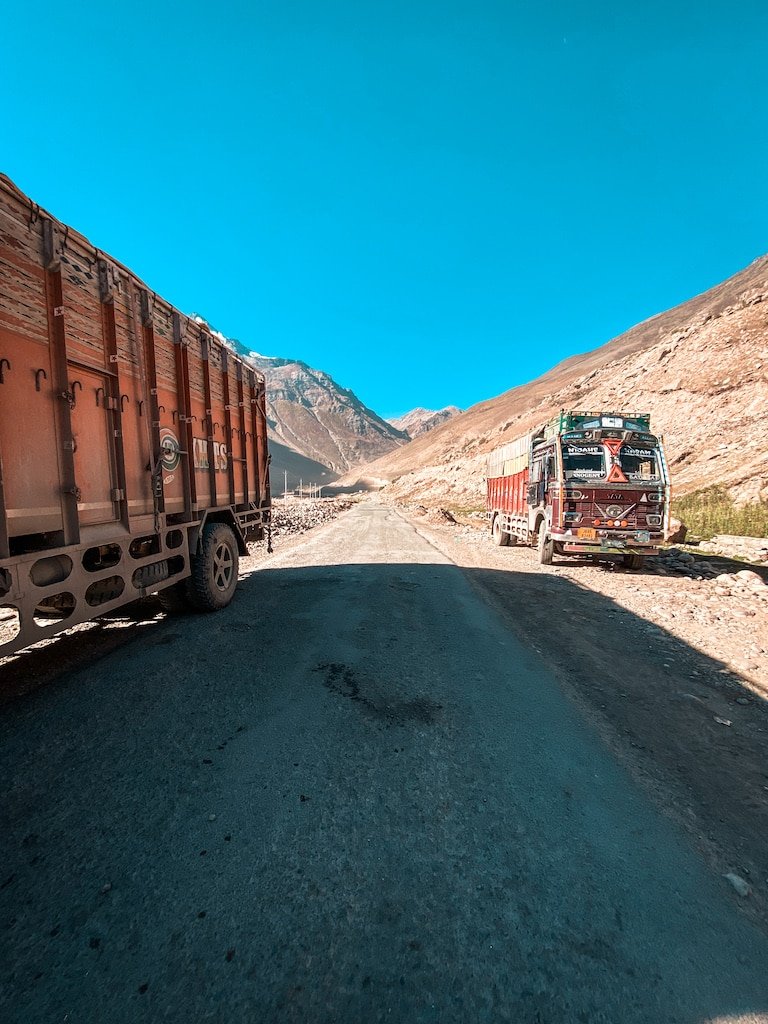
You can reach Zanskar Valley from Manali, Leh & Srinagar only via shared cabs or your vehicle.
Only one bus runs from Leh to Padum weekly, which is unreliable.
However, you can take bus from Leh to Kargil & then a shared cab to Padum.
The fare for a shared cab from Manali & Leh is INR 2500 & from Kargil is around INR 2200. The time taken from all these places to reach Padum is around 10-12 hours. These shared cabs take only one break in the journey; however, they also take 4-5 toilet breaks.
Our Recommendation: Take a bus from Leh or Srinagar to Kargil & then take a shared cab from Kargil, because on your way back Reaching Leh or Srinagar, you can also visit places like Sankoo, Panikhar, Parkachik & Rangdum in Suru valley, which is a 3-4 day trip in itself.
If you are on a shoestring budget, you can take one of the many local buses/vans that run from Kargil to Parkachick, which costs between INR 50 – INR 150.
Once in Parkachik, you can hitchhike a ride to Padum, as many trucks, tempos, and local vehicles travel on this route often. (you should try it from 6 AM to 11 AM because by then, most of the cars cross Parkachik.)
Where to stay in Zanskar valley?
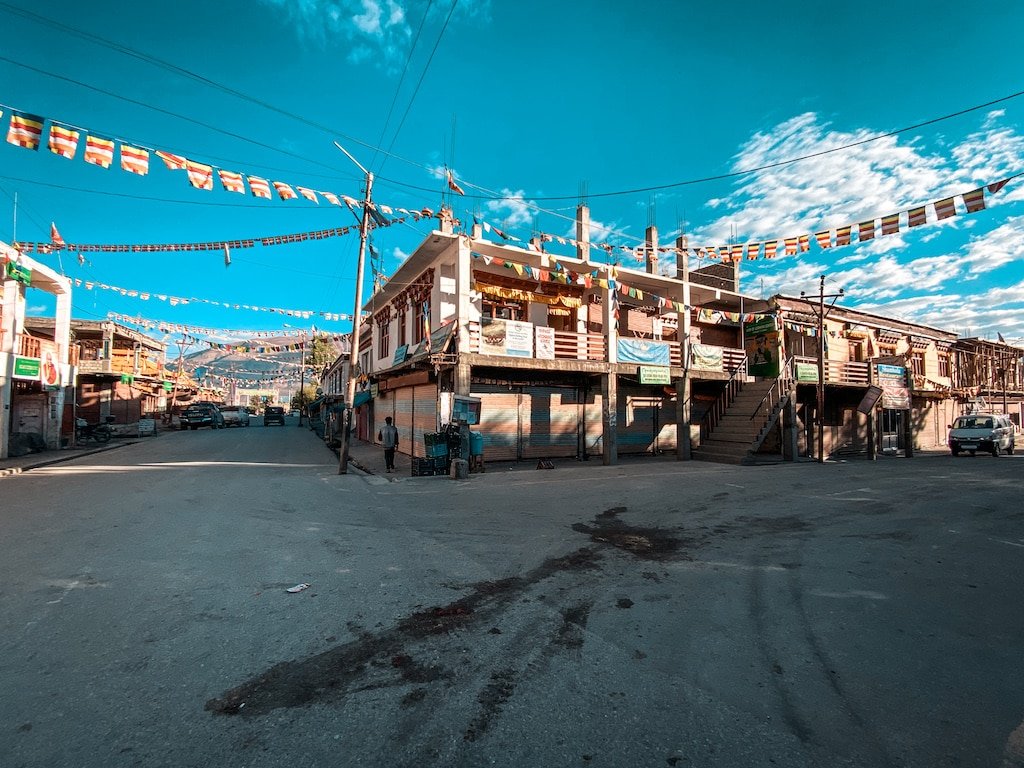
When in Zanskar, most of your night stay will be in Padum (Located at an high altitude of 3,669M). But you can also have a homestay experience in Zangla, Karsha, Cha & Purne.
Padum is a tiny town with only a few good places to stay.
We would highly recommend staying in Hotel Zambala , as it is closer to the taxi stand & is in the main town. A reasonable INR 1,000 – INR 2,000 for a night for two people (depends on how well you negotiate), spotless & spacious rooms, and an excellent hot water supply. A local family runs it.
Marq and Ibex are other options in the same price bracket in the main town. Hotel The TRC Zanskar & Omasila Hotel Zanskar are the other two options but are far from the main area.
Things To Do & Places To See
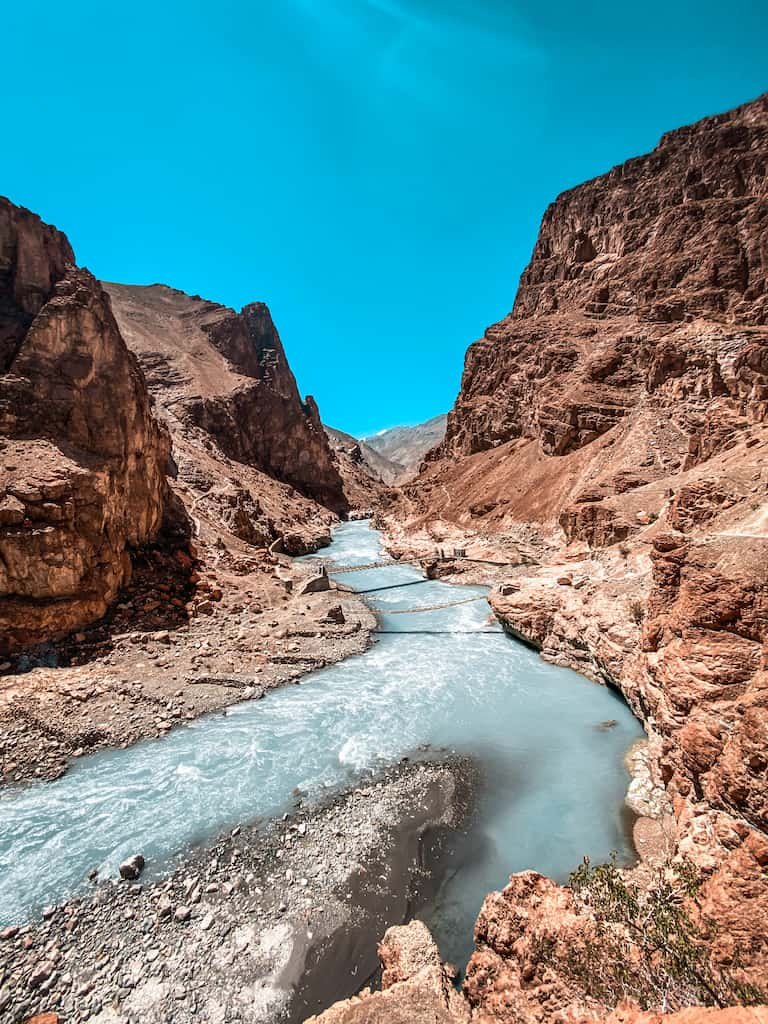
(Click on the image to enlarge)
Zanskar has a lot to offer. Traveling to the valley is an experience in itself. However, here’s a list of places you can visit in the region.
Phugtal Monastery trek
- When in Padum, the must-do thing is to do the Phugtal Monastery trek. The trek starts from the villages of Purne and Cha.
- You can take a shared cab which is going to Manali and ask them to drop you at Purne.
- They will ask you to pay for the entire amount of INR 2500, but you can negotiate to settle anywhere between INR 1200-INR 1500 per person.
- The distance to Purne is around 2.5 – 3 hours. Once in Purne, you have three options:
- Option 1: Finish the trek on the same day and return to Padum if you get a ride from Purne.
- Option 2: Camp overnight at Purne, at Dolma Campsite & Homestays . They charge INR 1000 for the camping experience with breakfast & dinner. Similarly, there are 2-3 other campsites in Purne.
- Option 3: Return to Purne after the trek, go to Gonbo Rongjon and camp there for the night. The Dolma Campsite’s owner offers to drop and pick up and can charge anywhere between INR 3000 – INR 5000. It is a feasible option only if you are three or more.
Zangla Palace:
Zangla Palace is a 17th-century palace located in the village of Zangla in the Zanskar region of Ladakh, India. The palace is situated on a hilltop overlooking the village and the Zanskar River valley. It is a three-storey structure with a central courtyard. The palace was built by the Zangla royal family, who ruled the region from the 16th to the 19th centuries. The palace was abandoned in the late 19th century after the region was conquered by the British.
Stongdae Monastery:
Stongdey Monastery is a beautiful and historic monastery in the Zanskar region of Ladakh, India. It is a popular destination for pilgrims and tourists alike. The monastery is home to a number of important religious texts and manuscripts, and it offers stunning views of the surrounding village.
Karsha Monastery:
Karsha Monastery is a Buddhist monastery located in the Padum Valley of the Zanskar region of the union territory of Ladakh in northern India. It is the largest and most important monastery in Zanskar.
The monastery was founded in the 11th century by Phagspa Shesrab, a translator who studied with the famous Indian teacher Atisha. The monastery is home to over 100 monks and is affiliated with the Gelugpa school of Tibetan Buddhism.
The monastery is a popular tourist destination and is known for its annual Gustor festival, which is a masked dance that is performed to celebrate the victory of good over evil.
Sheela Waterfall:
Sheela Waterfall is a beautiful waterfall located in the Zanskar Valley of Ladakh, India. It is a popular tourist destination and is known for its stunning views and refreshing waters. The waterfall is located about 4.5 kilometers from the town of Padum and can be reached by a cab.
The waterfall is located in a small village called Sheela and is named after it. The waterfall is about 20 meters high and cascades down a rocky cliff into a pool of water.
Sani Lake is a beautiful lake located near the village of Sani, which is home to a Buddhist monastery. The lake is believed to be sacred by the local people and is a popular spot for camping and picnics for the locals.
There is also a magnificent statue of Guru Rinpoche right in the middle of the lake.
The local cab drivers will charge you around INR 3000 – INR 4500 to visit all these places.
We recommend you take your time and visit these places in two days, so you can spend enough time at all these places and enjoy the experience.
- Visit Gyalwa Ringna, which is 2kms walking from the main town of Padum.
- If you are coming from Kargil, you can also stop at the Penzi La pass and admire the beauty of Drang Drung Glacier.
Where To Eat
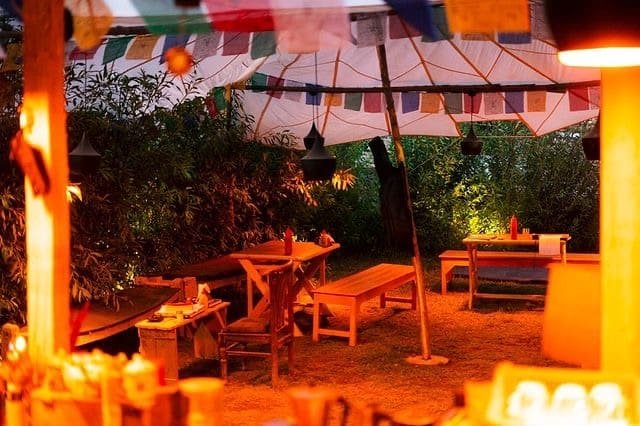
Padum has very few cafes and restaurants; however, we recommend eating at Zanskar kitchen; they serve the best food in all of Padum.
If you crave pizza, you can eat at the newly opened, only pizza place in Padum, called Za Pizza. They serve delicious pizzas at a reasonable price.
Other options include Changthang restaurant, Cafe Ale Yato & Karsha Chamling.
The Best Season To Visit
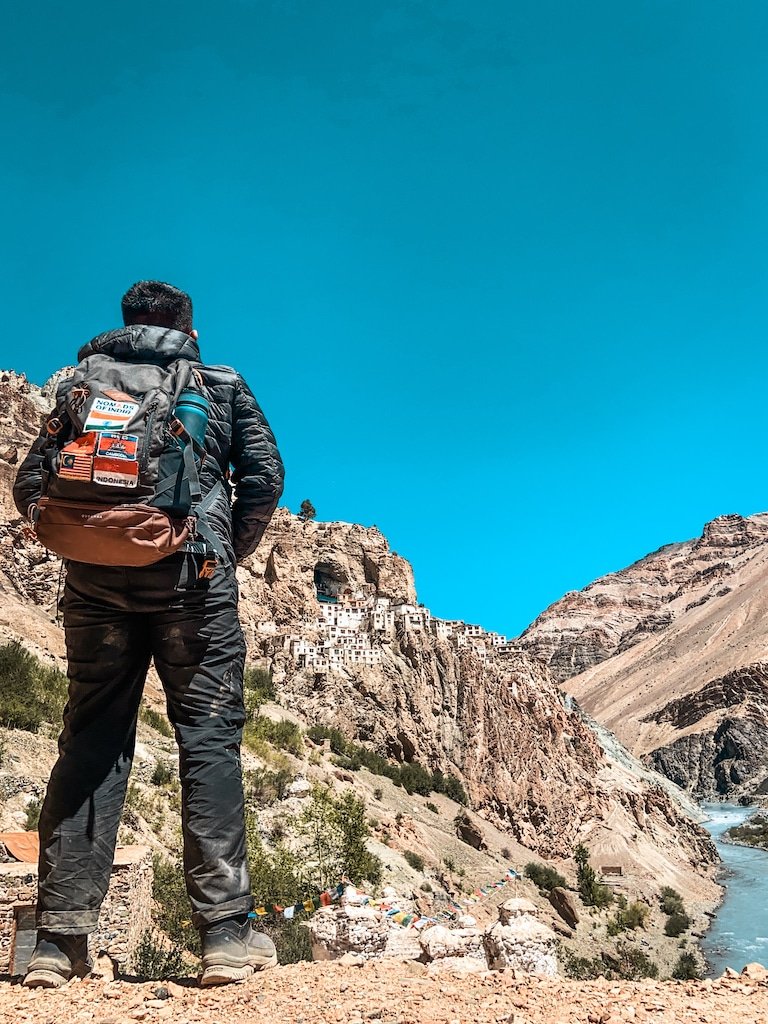
The roads to Zanskar are open from May till mid-October as BRO clears all the passes, allowing vehicle movement from Leh, Srinagar & Manali.
One can visit from the months of June to September.
Our Recommendation: Visit Zanskar in August or September, as the weather is pleasant & clear to explore the Zanskar mountain range, everything is open, and the chances of road closures are next to none; during these months, many people travel to Zanskar, so the chances of getting shared rides are also excellent.
Budget for a 7-Day Trip
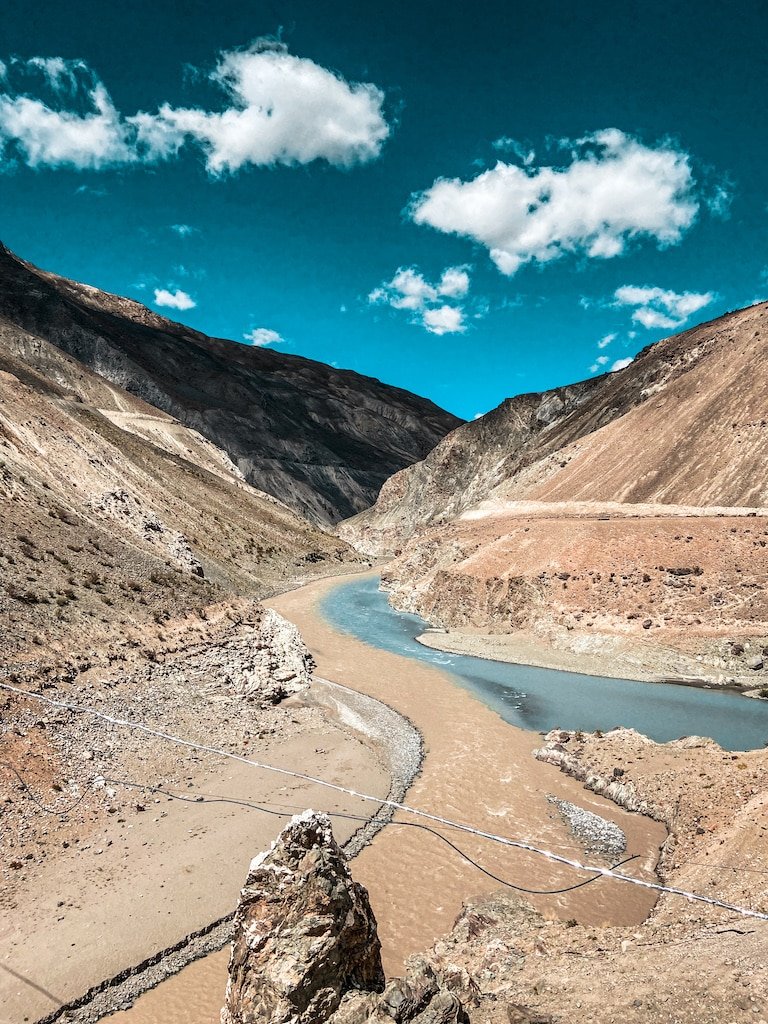
- A ride to Padum from Kargil & Leh in a shared cab will cost you INR 2200 & from Manali, it will cost you INR 2500. The same will be for the return journey.
- Three meals a day will cost you around INR 500 – INR 800.
- You will pay around INR 1000 – INR 1200 for a night’s stay.
- A shared cab ride to Purne will cost you INR 1200
- A cab for local sightseeing will cost you INR 3000 – INR 4500 (if you are lucky, you can find travellers at the taxi stand or in your hotel and ask them if they would want to join you for the plan and this will bring down your cost)
If your trip is for around five days & four nights, you can expect to pay around INR 15000 – INR 18000 per person.
Ideas on saving costs:
- Travel as a group of friends (2-4 people)
- Hitchhike rides wherever possible
- If you have time on you, walk to places wherever possible.
- Do not buy packaged water. Refill it everywhere.
- Carry ready-to-eat food, coffee & tea packets
- Opt for places that offer breakfast or dinner
- Share meals with your friends or people you travel with
- Talk to fellow travellers, ask them about their plans, join them or tell them to join your plan; this will help you cut down your local travel plans.
- Do not pre-book the hotels. Reach there and look for options and negotiate. You will get far better deals.
A 7-day itinerary (from Srinagar)

- Day 1: Take an early morning bus to Kargil. Relax for the rest of the day.
- Day 2: Take an early morning shared cab to Padum from Kargil. Reach & relax for the day.
- Day 3: Take a local shared cab to Purne, do the Phugtal Monastery trek and camp overnight at Purne. Or travel to Gonbo Rongjon & centre there overnight.
- Day 4: Return to Padum & relax for the day or go to Gyalwa Ringna.
- Day 5: Go for local sightseeing: Karsha monastery, Stongdae Monastery, Sheela waterfall & Sani lake.
- Day 6: Take a local shared cab to Sankoo. Explore Sankoo & stay there for the night.
- Day 7: Take a local bus/cab to Kargil & then take a shared taxi to Srinagar.
Frequently Asked Questions (FAQs)
Zanskar is famous for its stunning landscapes, remote Buddhist monasteries, and trekking trails that offer breathtaking views of the surrounding mountains.
The Chadar river trek is one of the most famous treks in Zanskar which happens during the winter months.
The hidden-gem Phugtal Monastery is also in Zanskar, which is a 2 hour hike from the village of Purne.
Yes, the Zanskar Valley is definitely worth visiting for those who enjoy outdoor adventures and scenic landscapes.
Zanskar region has some of the most peaceful monasteries in India. Phugtal monastery, Stongdae monastery, & Karsha monastery being few of them. The Gonbo Rongjon is a holy mountain for the Zanskari people & is one of the picturesque mountains in the country.
The best time visit Zanskar is in August or September, as the weather is pleasant, everything is open, and the chances of road closures are next to none; during these months, many people travel to Zanskar, so the chances of getting shared rides are also excellent.
Zanskar valley is in the north Indian union territory of India.
Did you like this travel guide for Zanskar Valley?
We have many more such guides on similar off-beat experiences & we send out such guides, offers, hidden gems, and trekking destinations weekly via our email newsletter. Subscribe to our newsletter to get them directly into your inbox.
- zanskar valley
Now that’s one hell of a blog..!
Robert Meurant
Great help, thank you! Just what I was looking for.
Yogesh Nikam
Very well written blog .read a whole blog after so many days. can’t wait to visit zanskar .thank u for efforts
Add a comment
Leave a reply · cancel reply.
Your email address will not be published. Required fields are marked *
This site uses Akismet to reduce spam. Learn how your comment data is processed .
- Share via...
Travel Around The World Blog
A Journey Through the Land of Mystic Beauty: Zanskar Valley Tour Itinerary
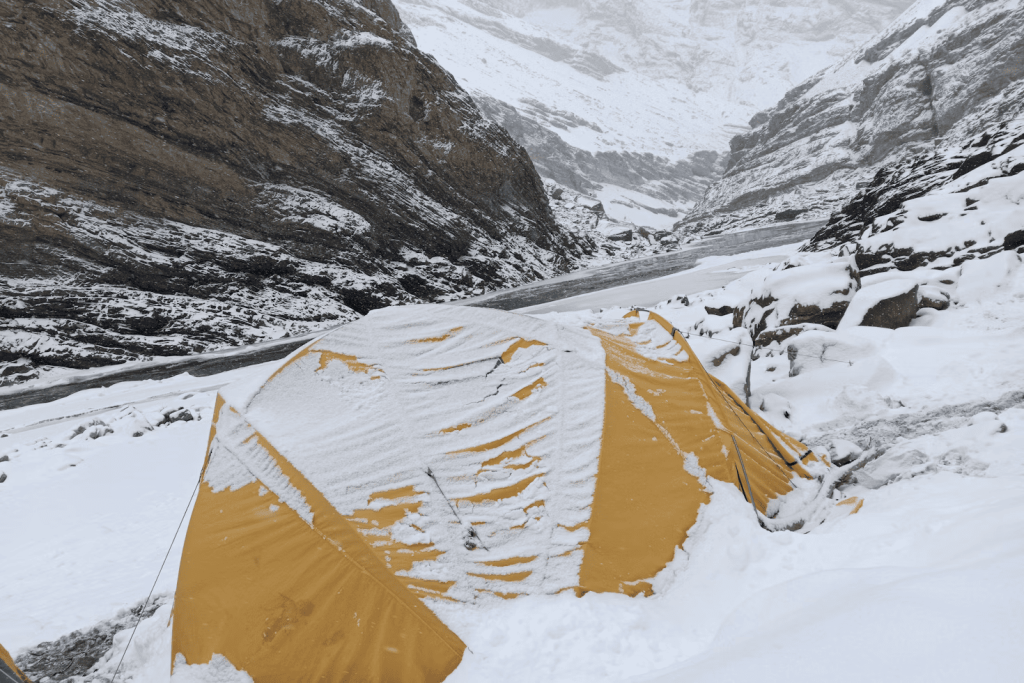
Nestled amidst the mighty Himalayas, Zanskar Valley stands as a testament to nature’s grandeur and mystique. Tucked away in the remote reaches of Ladakh, this pristine region offers intrepid travelers an unforgettable journey through rugged landscapes, ancient monasteries, and traditional villages. Embark on a soul-stirring adventure as we unveil the enchanting itinerary for a Zanskar Valley tour, promising a rendezvous with the sublime.
Leh – Gateway to the Himalayas
Your journey begins in Leh, the capital of Ladakh, where you’ll acclimatize to the high altitude and immerse yourself in the local culture. Explore the bustling streets adorned with colorful prayer flags, visit historic monasteries like Thiksey and Hemis, and marvel at the panoramic vistas of the Indus Valley.
Leh to Padum – The Road Less Traveled
Depart from Leh towards Padum, the administrative center of Zanskar Valley, via the scenic Srinagar-Leh Highway. En route, cross the mighty Zoji La Pass and witness the dramatic shift in landscape as barren mountains give way to lush valleys. Arrive in Padum, where time seems to stand still amidst the tranquil surroundings.
Padum – Exploring Ancient Monasteries and Villages
Spend the day exploring Padum and its surroundings, starting with a visit to the iconic Zangla Monastery, perched atop a hill overlooking the valley. Immerse yourself in the rich cultural heritage of Zanskar as you stroll through traditional villages like Stongdey and Karsha, adorned with intricately carved stupas and prayer wheels.
Padum to Pukhtal – Into the Heart of Zanskar
Embark on a thrilling off-road journey towards Pukhtal, a remote village nestled amidst towering peaks and glistening glaciers. Traverse rugged terrain and cross pristine rivers as you delve deeper into the heart of Zanskar Valley, encountering nomadic herders and pristine alpine meadows along the way.
Pukhtal to Shinku La – Conquering High Mountain Passes
Rise early and embark on a challenging ascent to the majestic Shinku La Pass, standing at an elevation of over 16,000 feet. Marvel at the breathtaking vistas of snow-capped peaks and azure skies as you conquer this high-altitude pass, a testament to your spirit of adventure and perseverance.
Shinku La to Jispa – Descending into Serenity
Descend from the lofty heights of Shinku La and make your way towards the serene village of Jispa, nestled along the banks of the Bhaga River. Relax and rejuvenate amidst the tranquil surroundings, surrounded by towering mountains and pristine wilderness.
Jispa to Umling La – Offbeat Adventures Await
Embark on an offbeat adventure towards Umling La, one of the world’s highest motorable passes, offering unparalleled views of the Himalayan landscape. Navigate winding roads and hairpin bends as you ascend to dizzying heights, with every twist and turn unveiling a new facet of Zanskar’s mystique.
Umling La to Leh – Journey’s End
Bid farewell to the enchanting landscapes of Zanskar Valley as you make your way back to Leh, retracing your path through rugged mountain passes and ancient villages. Reflect on the memories made and the experiences shared during your journey through this land of mystic beauty.
Conclusion:
A Zanskar Valley tour is not just a journey; it’s an odyssey of the soul, weaving through landscapes of unparalleled beauty and cultural richness. From the ancient monasteries of Padum to the high mountain passes of Shinku La and Umling La, every step of the way reveals the timeless allure of the Himalayas. So, pack your bags, embark on this extraordinary adventure, and let the mystic beauty of Zanskar Valley leave an indelible mark on your heart.
More Stories
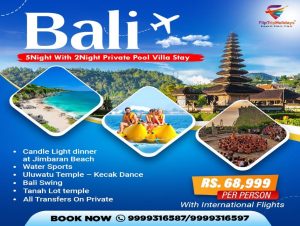
Embark on an Adventure with Our Bali Trip Package
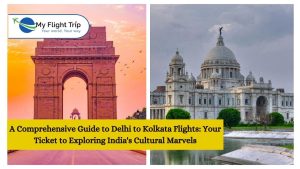
A Comprehensive Guide to Delhi to Kolkata Flights: Your Ticket to Exploring India’s Cultural Marvels

The Ultimate Guide To Road Trip: Planning Your Epic Adventure
You may have missed.
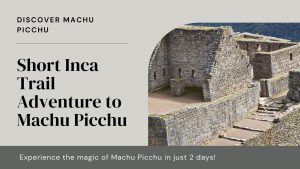
Unlocking the Charms of the Short Inca Trail 2D/1N to Machu Picchu
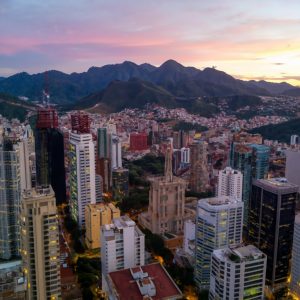
Caracas Travel Diaries: A Journey to the Vibrant Soul of Venezuela’s Capital
TREKKING IN LADAKH
Winter treks, mountaineering in ladakh, cultural tours in ladakh, adventures in ladakh, fixed departure treks - join a group, ladakh information, mountaineering, cultural tours, join a group, zanskar valley - cultural tour, tour highlights, zangla palace & monastery, stongde monastery, karsha monastery, sani monastery, zongkhul monastery, pensi la & drang drung glacier, rangdum monastery, suru valley, parkachik glacier & nun-kun mountains, shargole monastery, mulbek rock carving, indus valley from leh to lamayuru.

Tailored Experiences, Memorable Journeys
Choose from our pre-designed itineraries or customize your trip with us to turn your travel dreams into reality. Whether you seek adventure in the mountains, cultural immersion, or relaxation by the beach, we're here to create the perfect itinerary for your wanderlust.
Indian Packages
Discover the captivating heritage and breathtaking landscapes of India with our carefully curated tour packages. Whether you're interested in exploring historical wonders or seeking thrilling adventures, India has it all. Immerse yourself in the diversity and charm of this incredible country.
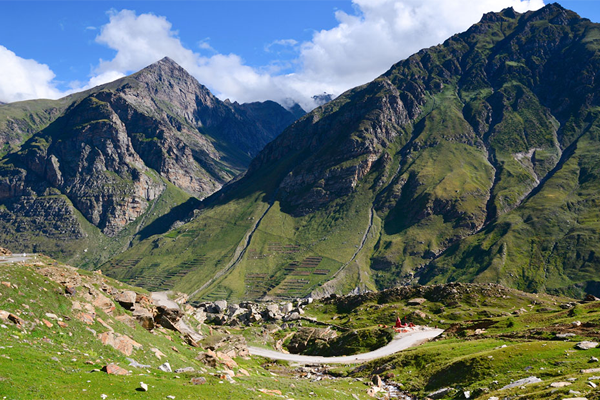
Spirit of Spiti
Duration: 10 Days
Explore the valleys of Spiti, home to ancient monasteries and breathtaking landscapes. Join us on a spiritual and adventurous journey through this enchanting region.


Upcoming Trips: Explore, Experience, Enrich
These upcoming trips promise unforgettable experiences, unique cultural encounters, and a chance to create cherished memories. Stay tuned for more details and booking opportunities.

Comming Soon
Zanskar valley tour packages, lorem ipsum, customized trips - tailored adventures awaits, explore the world your way with our customizable trips. whether it's spiti, zanskar, sikkim, or more, our journeys are designed to suit your preferences. these exciting adventures are open for booking across all our enchanting destinations. let your wanderlust guide you..

- Our Packages
© 2023 Zanskar Feels | All Rights Reserved.
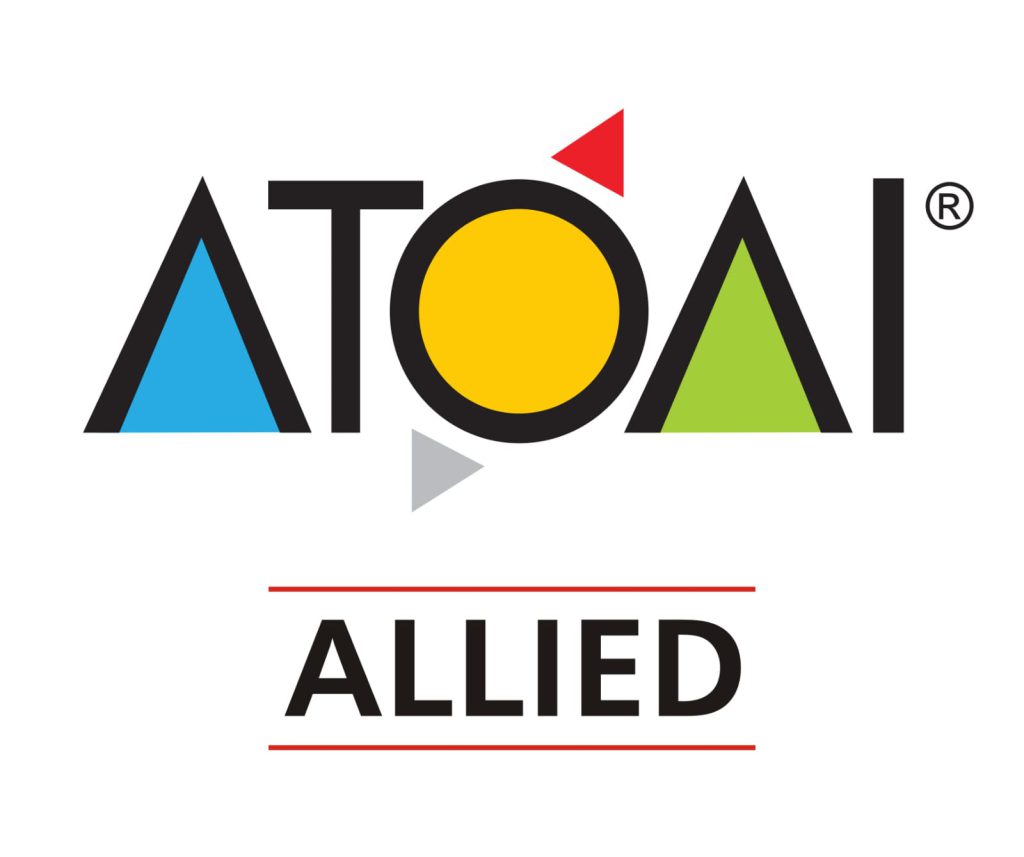
- Privacy Policy
- Terms of Services
Zanskar Valley: 18 Things to Remember Before Planning a Trip Here.
Remember the cliché fairy tale phrase of “land far, far away”? Zanskar Valley , believed to be one of the remotest places in India, fittingly fits into this fabled adage. The faraway land of Zanskar is surrounded by the mighty Himalayas and crisscrossed by the feisty Zanskar river and its tributaries. The valley is further sprinkled with glassy lakes with occasional dollops of icy glaciers. The entire vista of Zanskar Valley appears otherworldly, thus making it India’s “Shangri La”.
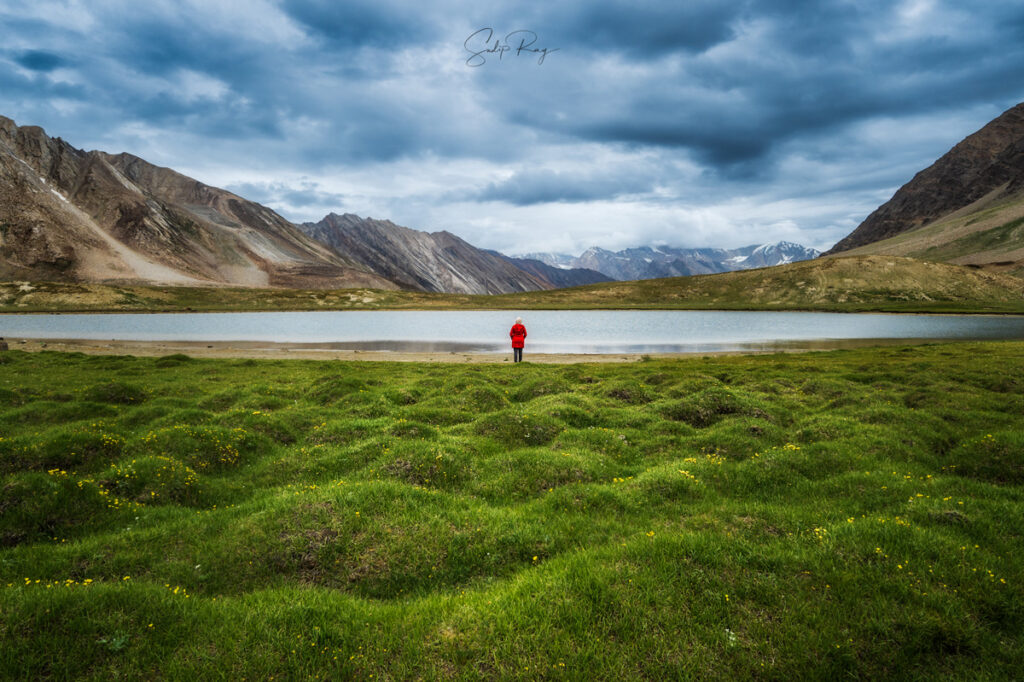
Table of Contents
Where is Zanskar Valley located:
Zanskar Valley is located in the Kargil district of the Indian Union Territory of Ladakh. The valley is predominated by the Zanskar range of the Greater Himalayas as also the Zanskar river.
About Zanskar Valley:
The word Zanskar or Zangskar bears testimony to the abundance of copper in the area since the Tibetan word for copper is ‘zangs’. Zanskar is translated variously to “white copper” (Zangs-dkar), “copper star” (Zangs-skar), “copper palace” (Zangs-mkar), and “copper valley” (Zan-skar).
Previously, Zanskar formed a part of the Tibetan Guge kingdom and continued as a peaceful Buddhist kingdom. Later, Ladakhi kings occupied this region.
The Zanskar Valley is a semi-arid region, perched at an average height of 13,000 ft. The road to Zanskar remains open only for 5 months in the summer. For the rest of the year, the valley remains cut off owing to heavy snowfall. The only medium of communication during this time is the frozen Zanskar river. For the Zanskari people, walking on the frozen river is their sole way to remain connected with the outer world. For travelers and trekkers, the icy river renders the renowned Chadar Trek.
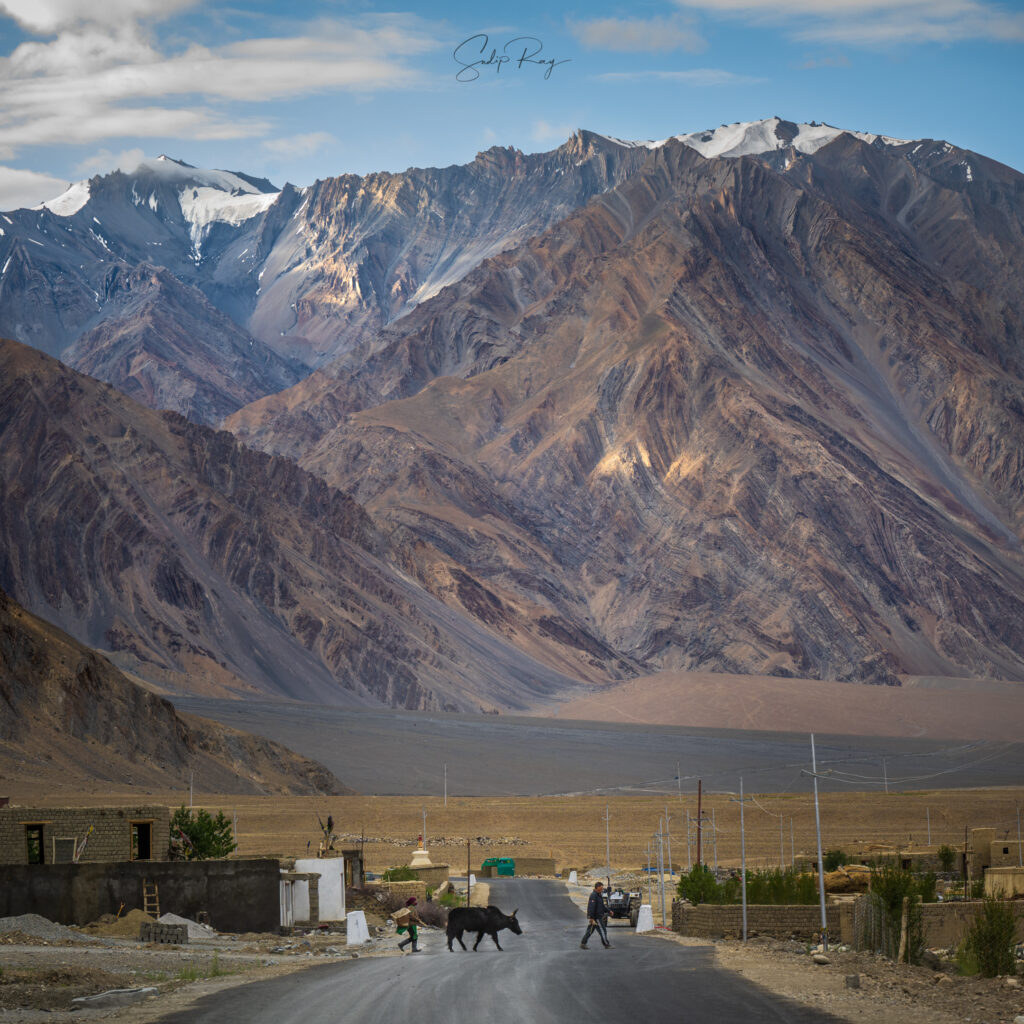
Why you need to visit Zanskar Valley:
Owing to its geographical location, Zanskar Valley has literally remained hidden from the outer world. It has successfully averted the onslaught of tourists and continued to remain an off-beat destination. This entails that, you will find the natural beauty of Zanskar to be pristine and unadulterated. The charm of its vista is just off the charts and can hardly be described in words. You need to see and experience Zanskar to believe in its ethereal allure.
The remoteness of Zanskar also means that it’s Tibetan Buddhism heritage and culture have retained their originality. Almost every destination in Zanskar has a ‘gompa’ or monastery that dates back ages. You will hardly come across such an experience anywhere else in India.
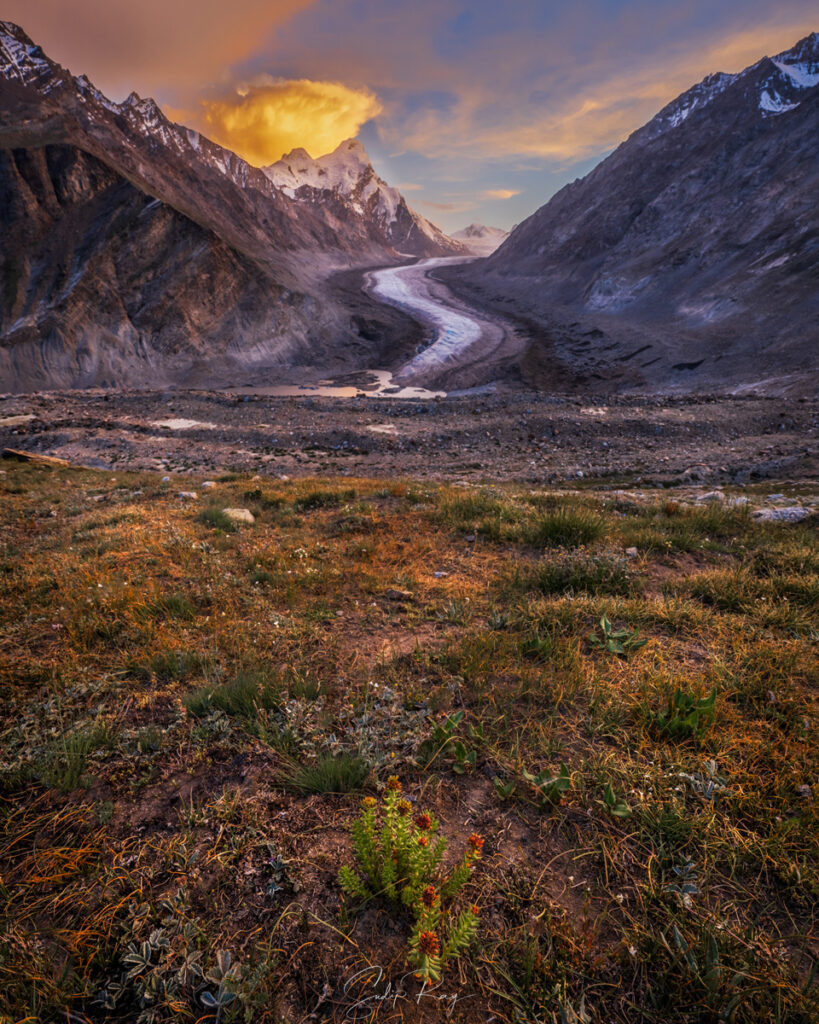
The Zanskar Valley will also quench your thirst for adventure and off-roading. The entire road connectivity across Kargil’s Suru Valley and Zanskar Valley is laden with adrenaline-pumping hairpin bends, river crossings, and whatnot. Also, Zanskar is known for several trek routes. Apart from the famous Chadar Trek, there is the Phugtal Monastery trek, Padum – Darcha trek, Padum – Gumbok Rangan Trek, Zanskar – Sham Valley trek, and Lugnak Trail trek.
Furthermore, if you are into camping, Zanskar offers amazing camping sites at Pensi La, Gumbok Rangan, Zangla, and Lingshed.
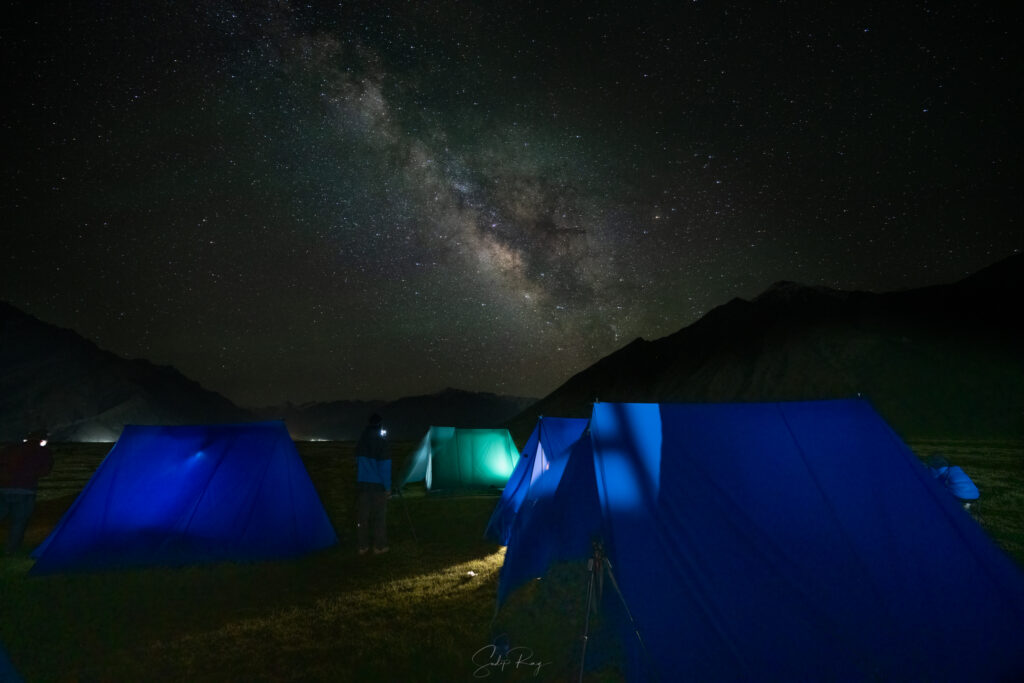
How to reach Zanskar Valley:
- By air: The nearest airport is Kushok Bakula Rimpochee airport of Leh, which is well-connected with Delhi and Mumbai.
- By rail: Jammu Tawi is the nearest rail station, which is around 700 km from Leh.
From Leh, there are two roads connecting Zanskar Valley. The first is Kargil – Padum Road via Suru Valley and Pensi La. The road goes through Sankoo, Damsna, Panikhar, Parkachik, Rangdum, and Pensi La and ending at Padum.
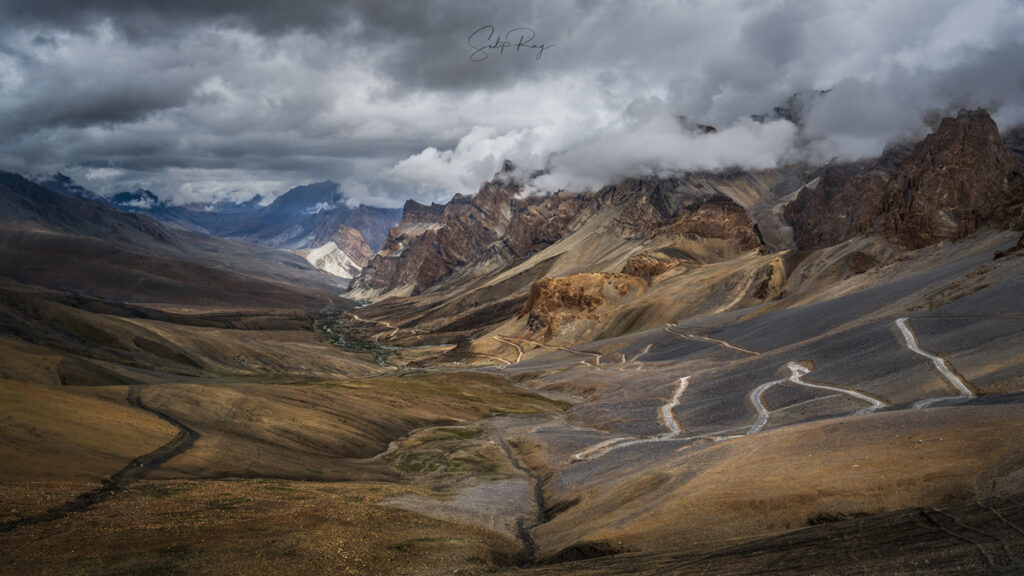
The second road runs from Leh to Padum via Sir Sir La and Shinge La. It will take you through Leh, Khaltse, Wanla, Sir Sir La, Photoksar, Shinge La, Lingshed, Zangla, and ending at Padum.
The road conditions in Zanskar are mostly hellish. The pitched road is scarce in both the aforesaid routes. You need to travel on thin dirt roads which remain strewn with pebbles and rocks, pass lanky bridges, and cross swift streams of rivers. However, the backbreaking journey will be duly compensated with the unparalleled natural vistas of Zanskar Valley.
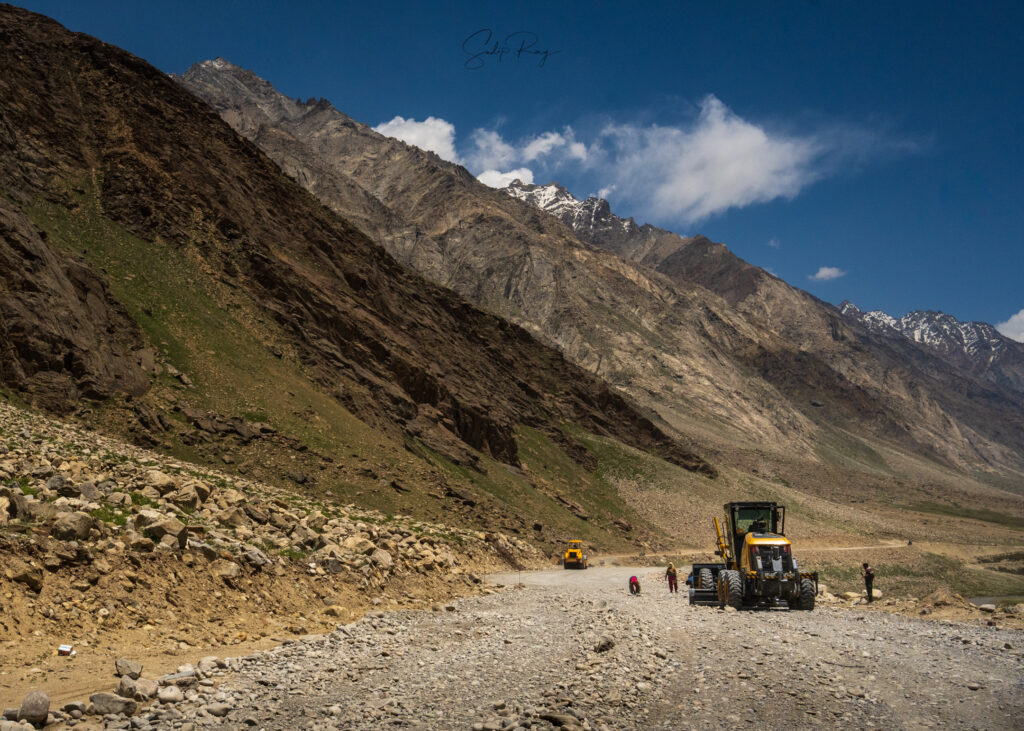
Distance charts of important places:
- Leh to Kargil – 216 km
- Kargil to Sankoo – 40 km
- Sankoo to Damsna – 20 km
- Damsna to Panikhar – 4.5 km
- Panikhar to Parkachik – 16 km
- Parkachik to Rangdum – 46 km
- Rangdum to Pensi La – 26 km
- Pensi La to Padum – 78 km
- Padum to Zangla – 32 km
- Zangla to Lingshed – 32 km
- Padum to Kargil – 230 km
- Padum to Leh – 440 km
Weather in Zanskar Valley:
The Zanskar Valley remains covered under snow during the winter months. As mentioned earlier, it becomes inaccessible in the winter. Winter generally sets off here from the end of October. The temperature drops way below the Freezing Point and the average temperature remains at -10 degree Celsius. Heavy snowfall, coupled with a biting wind, starts in December and continues till the end of March.
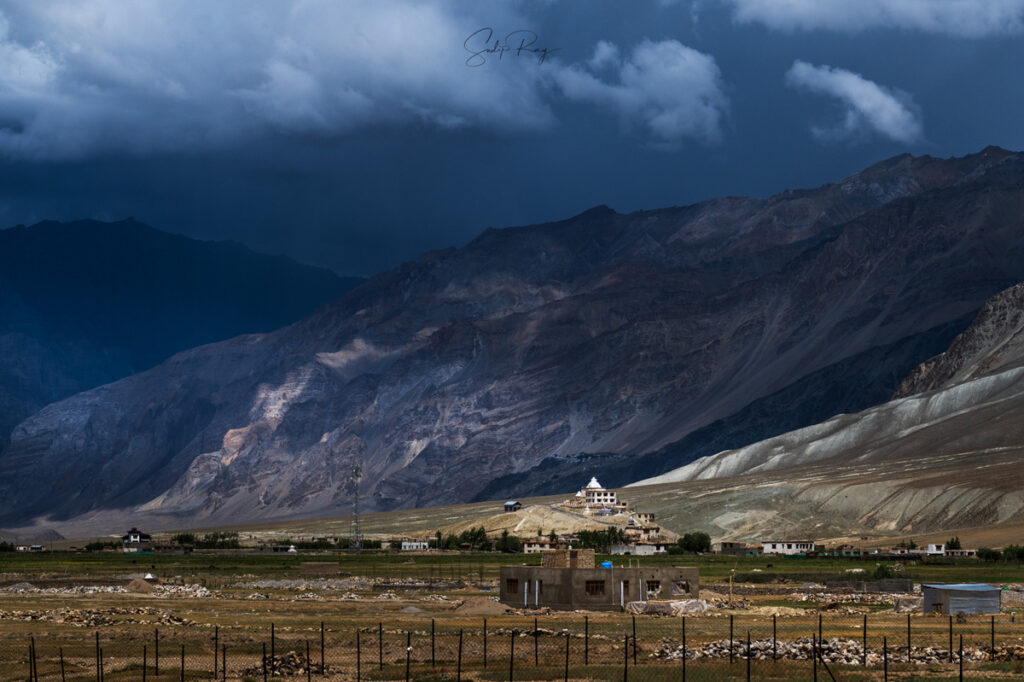
The snow starts melting in April. Roads start to get cleared from the end of April. Summer arrives by mid-May and continues till September. The days become pleasant with bright, sunny mornings, while the temperature drops significantly once the sun sets. The temperature during the day hovers around 15 degrees Celsius, while it falls to 3 – 5 degrees Celsius at the night. Though Zanskar is a cold desert area, light rains do occur rarely during June – July.
Best time to visit Zanskar Valley:
The summer months (June to September) are ideal for visiting Zanskar. The roads are all cleared and the temperature remains pleasant for exploring this beautiful valley.
However, if you are willing to go on the Chadar Trek, you must visit Zanskar from January – February.
We visited in the first week of July and found the weather to be perfect, sans one or two incidents of stray rainfall.

What to pack for a trip to Zanskar:
- During the summer months, the trick is to dress up in layers in Zanskar Valley. The temperature remains quite low during sunrise. Temperature increases gradually as the day progresses. Hence, try wearing layers of comfortable clothes, woolens, and jackets so that you can peel off one after the other as per the need.
- The summer mornings in Zanskar are quite sunny and warm. Thus, pack your regular cotton clothes, light sweaters, or jackets for the mornings. However, it starts to get chilly in the evening, while the nights are downright freezing. So, if you are planning to venture out after sunset for astrophotography, you will need thermals, heavy jackets, hand gloves, a balaclava, a muffler, and woolen socks.
- We found windcheater jackets handy during our Zanskar Valley trip. They provide protection both from cold wind and sudden rainfall.
- Winter is altogether a different story in Zanskar Valley. You will need to pack heavy woolen, puffer jackets, thermal inner-wears, woolen caps, mufflers, hand gloves, and socks.
- Apart from clothing, you must carry a good sunscreen lotion (at least with SPF 50), sunglass, and hats/caps. The sun is quite harsh and scorching in the high altitudes.
- Also, as Zanskar is a cold and dry region, carry a good moisturizer, Vaseline, Boroline, and if possible, coconut oil. These will protect you from getting dry skin, chapped lips, or cracked heels.
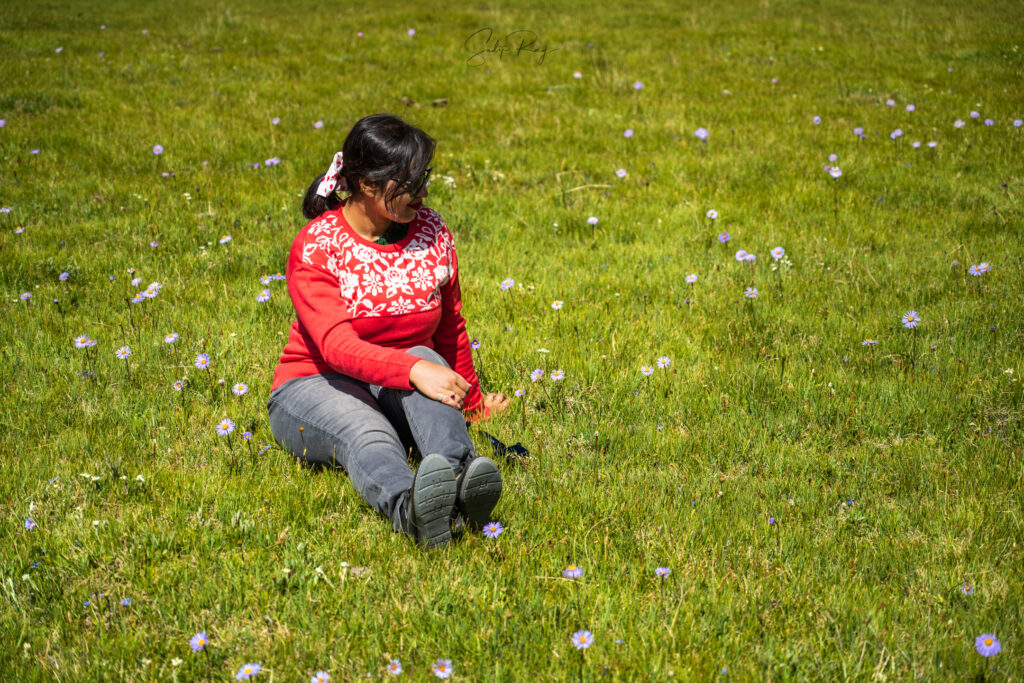
What to do and see in Zanskar:
The Zanskar Valley has something for everyone. Those with a penchant for nature will find Zanskar’s bounties abounding. For history and heritage buffs, there are countless monasteries and remnants of forts all across Zanskar. Wildlife enthusiasts may spot various birds and a few animals here. Zanskar also provides ample opportunity for photography, especially astrophotography. If you have been longing for that perfect shot of the Milky Way, Zanskar should be your one-stop destination.
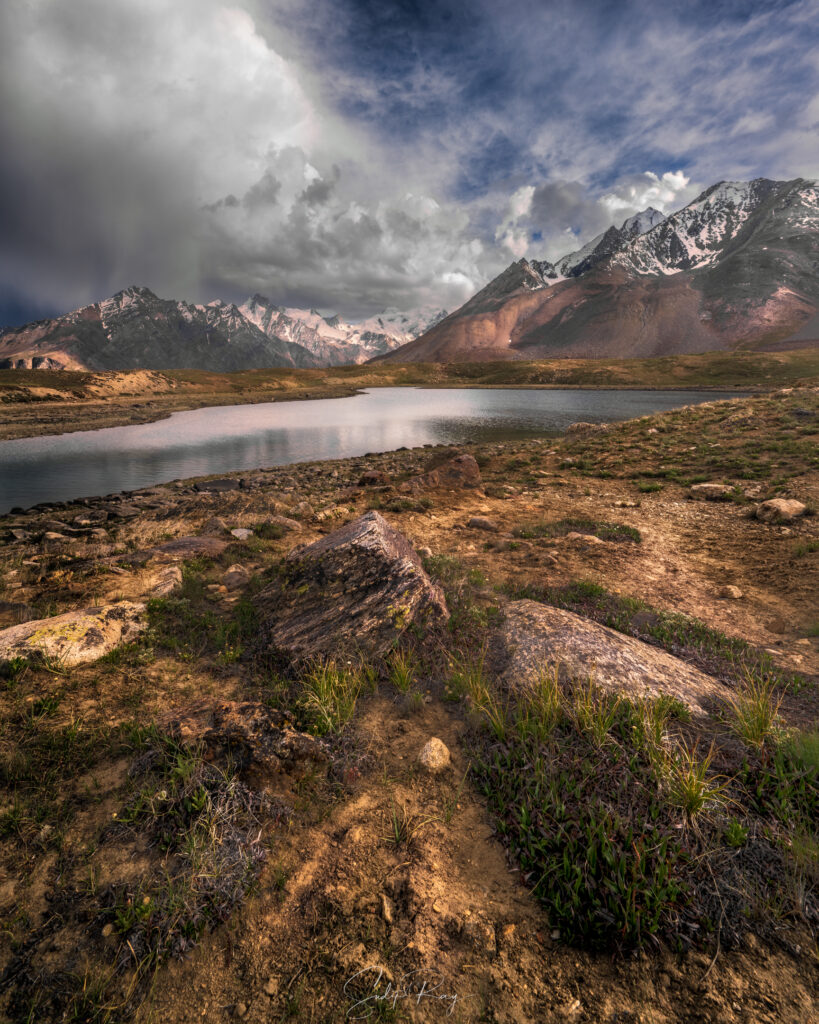
You can visit the following places:
1. Natural wonders of Zanskar such as Shafat Glacier, Parkachik Glacier, Drang Drung Glacier, Nun-Kun peaks, Ta Tso and Lang Tso twin lakes, and Gumbok Rangan.
2. Mountain passes like Parkachik La, Pensi La, Shingey La, and Sir Sir La.
3. Monasteries like Phugtal Monastery, Padum Monastery, Sani Monastery, Karsha Monastery, Stongdey Monastery, Pibiting Monastery, Dzongkhul Monastery, and Rangdum Gompa.
4. Ruins of fortresses at Rangdum and Zangla.
5. Look out for wildlife such as Himalayan Marmots, Kiangs, Asiatic Abex, Blue Sheep, Chukar Partridge, Himalayan Golden Eagle, and so on.
6. Zanskar is perfect for camping. You can set up camps at the twin lakes, Pensi La, Gumbok Rangan, and Zangla.
7. Zanskar is also ideal for stargazing if you are an astrophile.
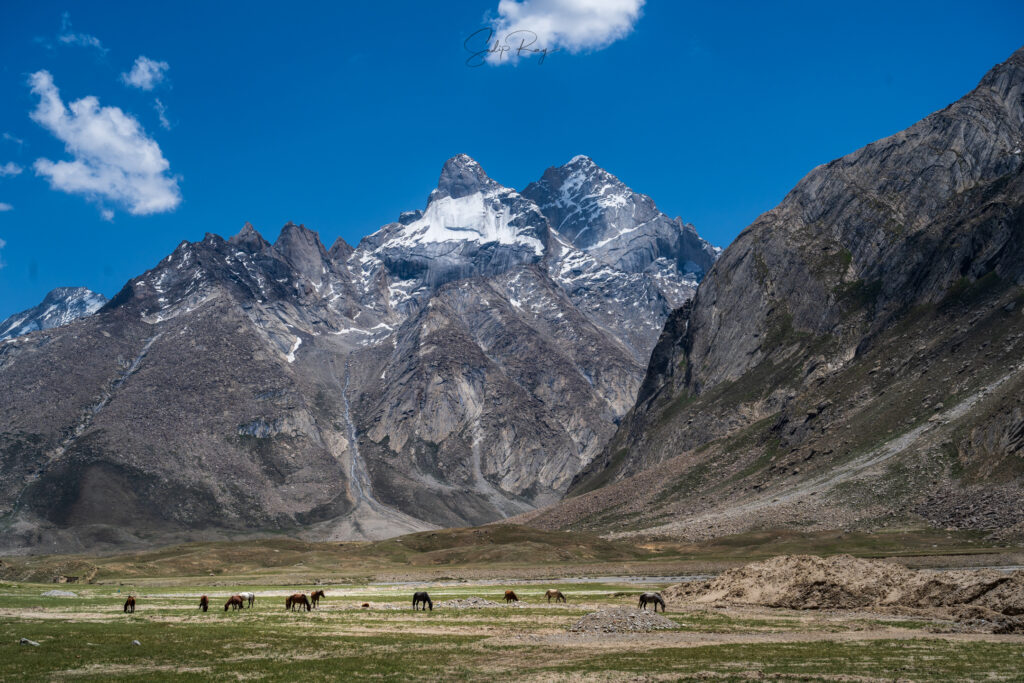
Where to stay in Zanskar:
There are small hotels, guesthouses, and homestays in almost every town and village of Zanskar. However, owing to the remoteness of Zanskar Valley, the amenities available are basic. Room rates are comparatively cheaper than the other areas of Ladakh. Electricity is erratic and, in most places, you won’t get running hot water. Also, toilets are mostly dry composting types.
- Hotels – You will find hotels (even three-star ones) at Kargil and Padum. Some of the well-known hotels of Padum are Omasila Hotel, Mont Blanc Guesthouse, Hotel Rigyal, and Padum Guesthouse. We stayed in Omasila Hotel and found it quite good.
- Guesthouses – Guesthouses are available in Sankoo such as Goba Guesthouse and at Rangdum such as La Himalaya Guesthouse, Nun-Kun Guesthouse, and Himalayan Inn.
- Homestays – You will come across homestays at almost every village in Zanskar such as in Anmo, Cha, Purne, Kargyak, Karsha, Zangla, and Lingshed. Homestays are also available in villages of Suru Valley such as Damsna, Parkachik, and Rangdum.
- J&K Tourism Bunglow – There are J&K Tourism Bunglow at Sankoo, Panikhar, Parkachik, Rangdum and Padum. But we heard that they are not very reliable and remain mostly closed.
- Monasteries – Another great option is renting a room at a monastery. Karsha and Phuktal Monasteries rent rooms to visitors.
- Campsites – You can also set up camps at Damsna, Rangdum, twin lakes, Gombok Rangan and Zangla.
What to eat at Zanskar:
While on road, you will find small stalls at Parkachik, Rangdum, Purne, and Photoksar serving hot teas and coffees, instant noodles, and boiled eggs. You will find restaurants at Padum serving Tibetan delicacies such as Momo, Thukpa, Tingmo, Thenthuk, and butter tea. Kargil also has a few cafes and restaurants where you will get regular ‘dal-chawal’ to Chowmein and Momos.
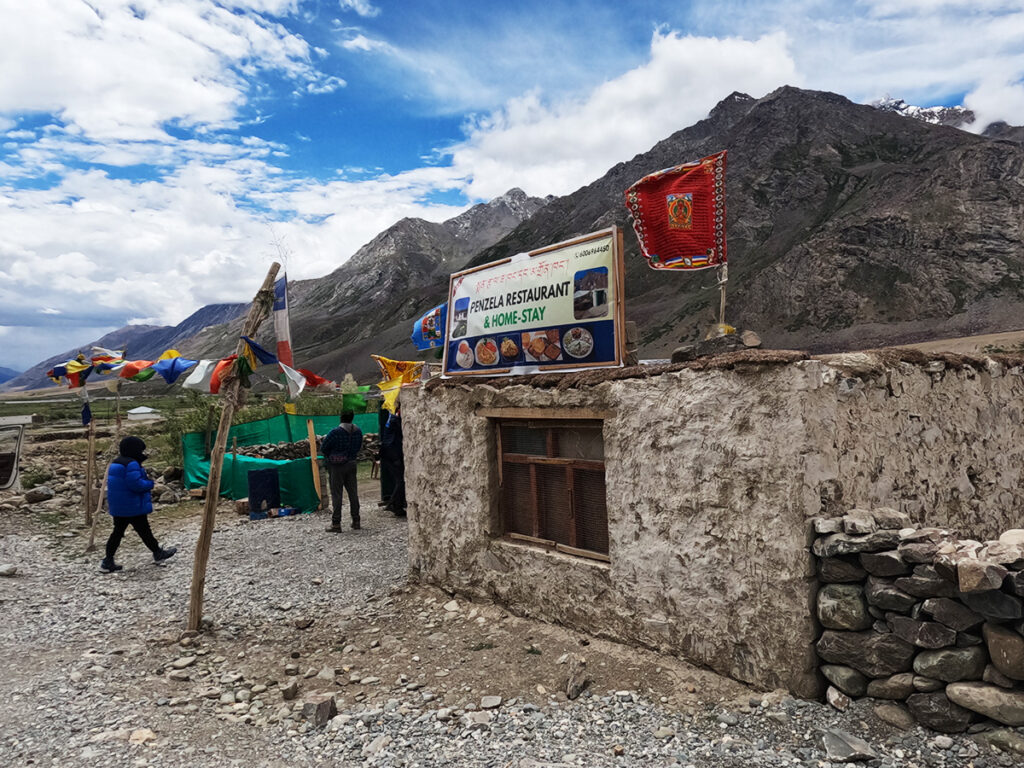
How to travel around Zanskar:
As they say, it’s not the destination but the journey. This seems apt, particularly for Zanskar Valley. The drive across the dirt roads, muddy trails, and river crossing is an adventure in itself.
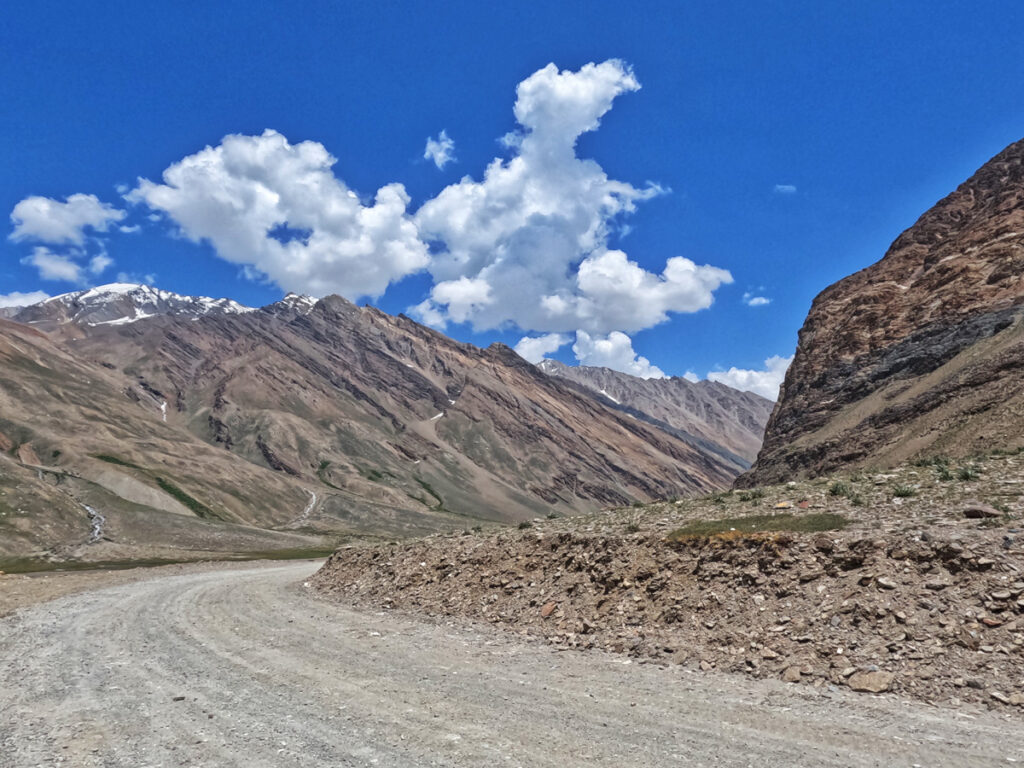
Public transport: Bus service is available in Zanskar. But buses are not that frequent and their reliability cannot be vouched for. A bus runs from Leh to Padum via Kargil once a week. However, getting a seat on this bus will be nearly impossible as only a sole bus runs once a week on this route.
Daily bus service is available from Kargil to Sankoo, Panikhar, and Parkachik.
The other mode of public transport is shared taxis. This is far more reliable than the buses and the local people also seemed to prefer this. You will get shared taxis from Leh to Kargil, Kargil to Padum, and vice versa. A shared taxi from Kargil to Padum will cost INR 1,500 approximately. Further, shared taxis from Kargil to the villages of Sankoo, Panikhar, Parkachik, and Rangdum are also available. We suggest enquiring about the timings and fares beforehand and booking seats, if possible.
Hired taxis: Hiring a cab for traveling in Zanskar Valley is perhaps the best option. Although given the bad road condition, it will cost a hefty. Remember a taxi rented in Leh or Srinagar cannot be used for traveling or sightseeing in Kargil and Zanskar. Similarly, a car rented from Kargil can’t be used for sightseeing in Leh or Srinagar.
Hire an SUV car with good ground clearance. We traveled in Xylos and faced no problems while crossing streams or driving on rocky terrains.
Hiring an SUV for 9-10 days in Zanskar will cost you around INR 50,000.
For hiring an SUV, you can contact Norbu Pibitang (9469369109/7889857547).
Private cars: If you have an SUV with good ground clearance, you can definitely self-drive in Zanskar. It will give you flexibility with your itinerary and also save you money. However, since Zanskar is a remote area and the roads are in bad shape, take all precautions regarding your vehicle and drive with utmost care.
Bikes: Ladakh and biking have now become synonymous. If you are an avid biker, you can definitely hire one or drive your own bike to Zanskar.
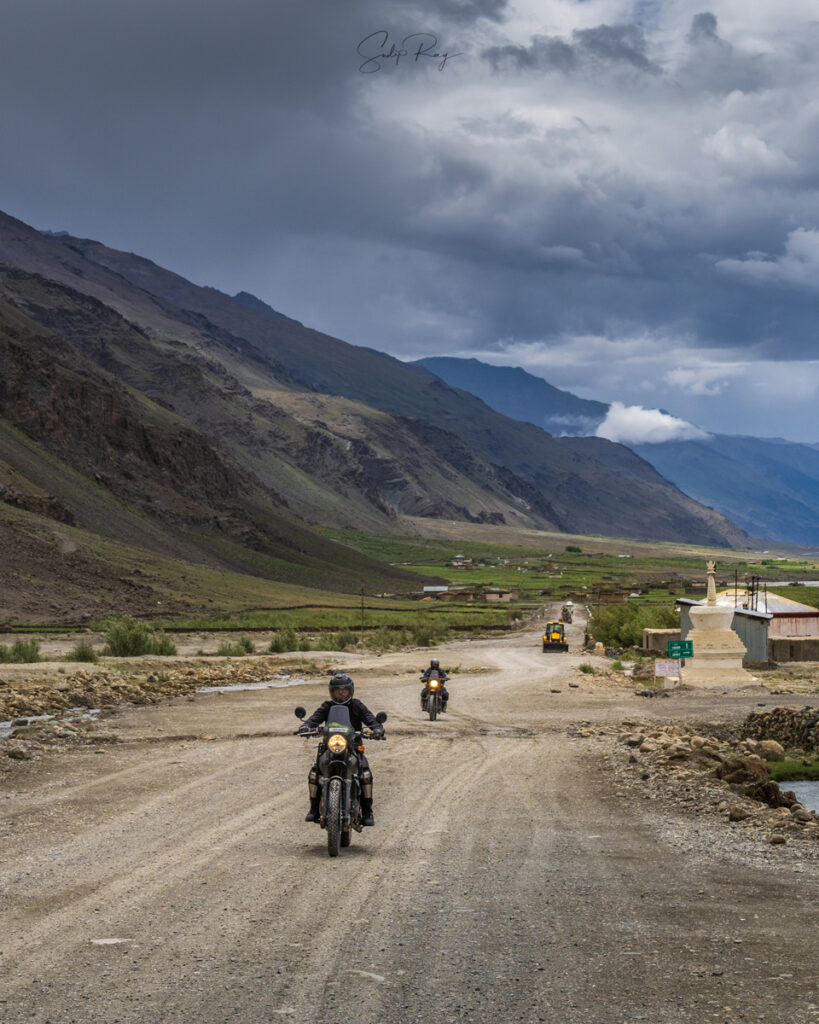
Acclimatization and AMS while traveling in Zanskar:
Zanskar Valley is situated at an average height ranging from 13,000 to 18,000 ft. As such, acclimatization is crucial here.
-If you are flying in Leh, take complete rest for one day and give your body ample scope to adjust to the sudden height gain. Leh’s altitude is 11,562 feet.
-While traveling from Leh to Padum, plan for at least 2-night halts on the way. The journey from Leh to Padum involves both driving through lower altitudes and sudden height gains. As for us, we halted at Damsna, Rangdum, and Pensi La before reaching Padum on our 4 th day.
-The general rule for tackling Acute Mountain Sickness (AMS) is to stop for a day every 2,000 feet and climb above 8,000 feet.
-Don’t overexert yourself. Keep your body relaxed and walk slowly.
-Keep yourself hydrated by drinking ample amounts of water.
-Eat carbohydrate-rich food. Opt for foods that are easy on the stomach and avoid fatty and junk foods. Please keep in mind that, our digestion system slows down as we gain height.
-Don’t starve yourself. Also, don’t overeat.
-While traveling, it’s wise to carry dry fruits like dates, apricots, raisins, almonds, and walnuts. You can also carry biscuits and chocolates. You won’t find food joints everywhere in Zanskar. These foods will help you in such situations.
-You can also carry ginger, garlic, and cloves. They are helpful in battling nausea, dizziness, and vomiting at high altitudes.
-Strictly avoid smoking and drinking alcohol at high altitudes.
-Also, avoid sleeping at odd hours.
-Refrain from turning the car heater on.
-Acetazolamide or Diamox is often used as a precautionary measure against AMS. However, we advise consulting a doctor before starting Diamox.
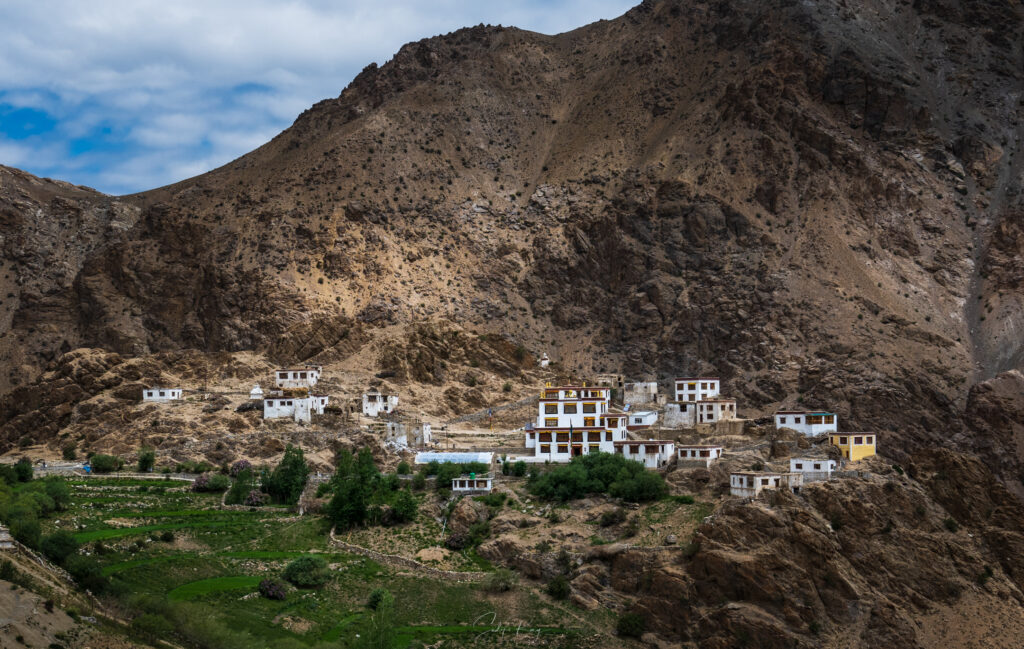
Hospitals and medical assistance:
Zanskar is one of the remotest places in India. It is also underdeveloped compared to the Leh district of Ladakh. As such, healthcare facilities are not readily available in Zanskar.
Padum is the only place in Zanskar Valley where you will find a hospital. There are also a few medicine shops here.
There is also another hospital with better equipment at Kargil.
We, therefore, suggest carrying basic medicines for fever, common cold, indigestion, dysentery/diarrhea, stomach ache, and headache along with painkillers, antiseptics, and bandages.
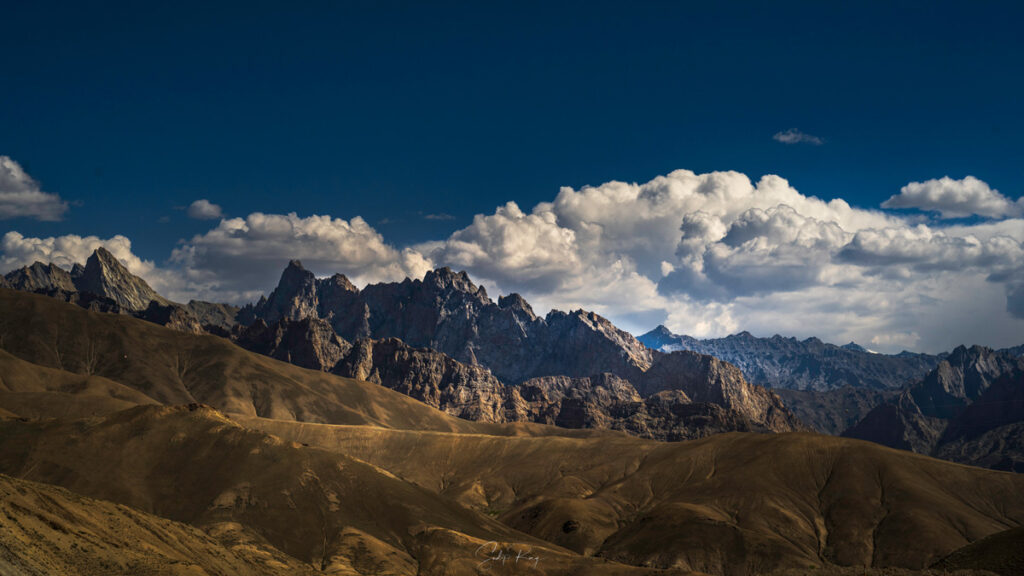
Mobile connectivity in Zanskar:
No pre-paid mobile connections work in the entire Ladakh. Only post-paid connections of BSNL, Airtel, and Jio work in Ladakh.
However, in Zanskar, only Jio’s post-paid remains active. We found mobile towers in almost every small village of Zanskar. Mobile connectivity is however absent in remote spots, such as Gumbok Rangan.
Availability of ATMs:
You will come across ATMs at Kargil, Sankoo, and Padum. However, there is no guarantee of the availability of cash 24X7 in these areas. Hence, it is better to carry sufficient cash with you while traveling across Zanskar.
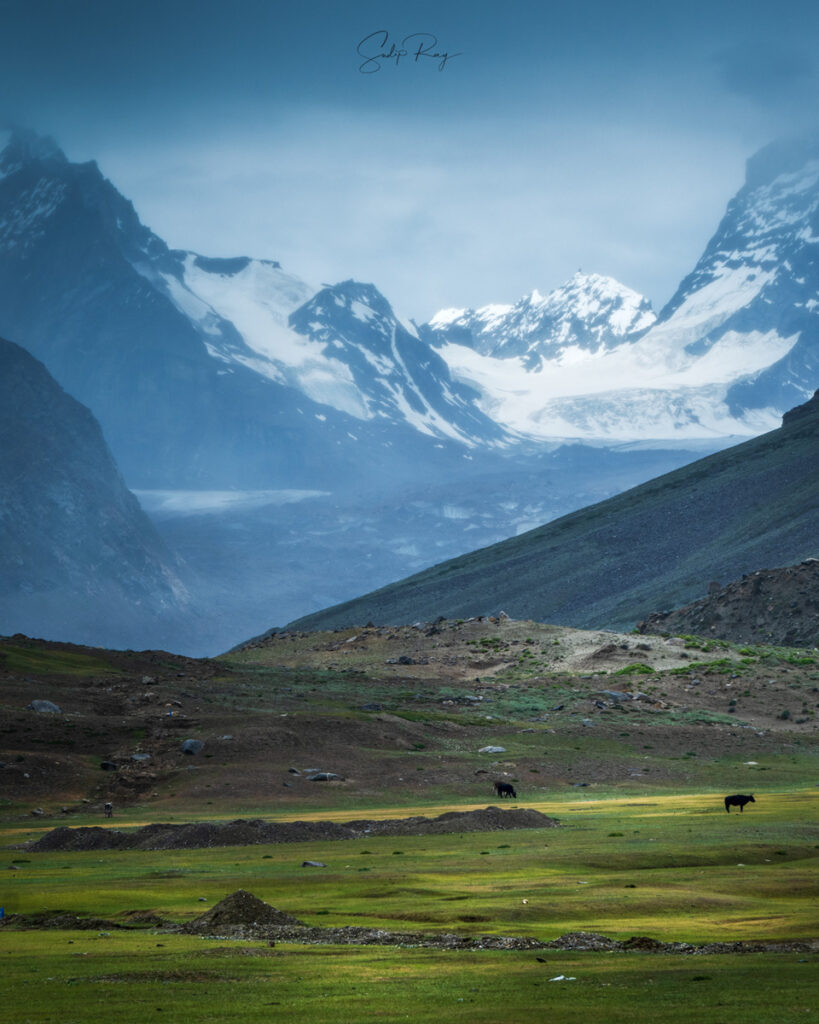
Petrol Pumps in Zanskar:
After Leh, you will find petrol pumps only at Kargil and Padum. However, the activity of Padum’s petrol pump is doubtful. We found it closed twice within a span of 3 days. We suggest filling your car to the fullest at Kargil and carrying spare fuel in a jerrycan in case of emergency.
Car mechanics:
We saw a number of car repair shops in Kargil. Padum has few mechanics also. If you are taking your own car or bike to Zanskar, we suggest getting your vehicle serviced beforehand. Also, carry basic spare parts and a toolkit in case you face minimal breakdowns on your journey.
Is it safe to visit Zanskar:
Zanskar Valley is absolutely safe for tourism. Yes, the roads are abysmal and you need to be vigilant while on road. However, local people are nice, friendly, and helpful. People in Zanskar will always greet you with a hearty smile and go out all the way to help you with their limited resources. We camped at various locations across Zanskar and faced no threats or problems at all.
Taking kids and elderly persons to Zanskar:
Though Zanskar is a piece of heaven on earth, we felt that it is not ideal for a family vacation with kids and elderly members of the family. Zanskar has high altitudes where the oxygen level is quite low. You need to be physically fit to tread the paths of Zanskar. Also, medical facilities are scarce here as well as other day-to-day amenities.
The Floating Pebbles
Related posts.

Kalimpong: Romancing the Vibrant Hill-station
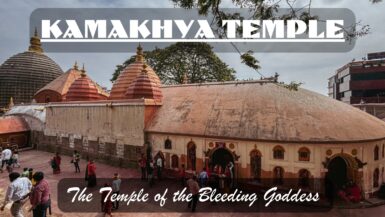
Kamakhya Temple: The Legendary Temple of the Bleeding Goddess
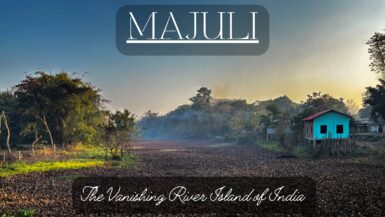
Majuli Island: The Vanishing River Island of India

- Group Tours Calendar
- Planning, Sightseeing & Routes
- Preparing for Ladakh Trip
- Stay, Eat, Permits & Others
- Taxis, Self-Drives & Bike Rentals
- Public Transport & Budget Travel
- Preparing for Spiti Valley Trip

9 Day Trip to Zanskar Valley from Leh [Day by Day Travel Itinerary]
Are you looking for a travel plan for a trip to Zanskar Valley from Leh? This 9-day detailed travel itinerary of Zanskar Valley from Leh will help you plan a memorable trip. This itinerary covers all the major tourist attractions in Zanskar Valley including Rangdum and Padum with local sightseeing.
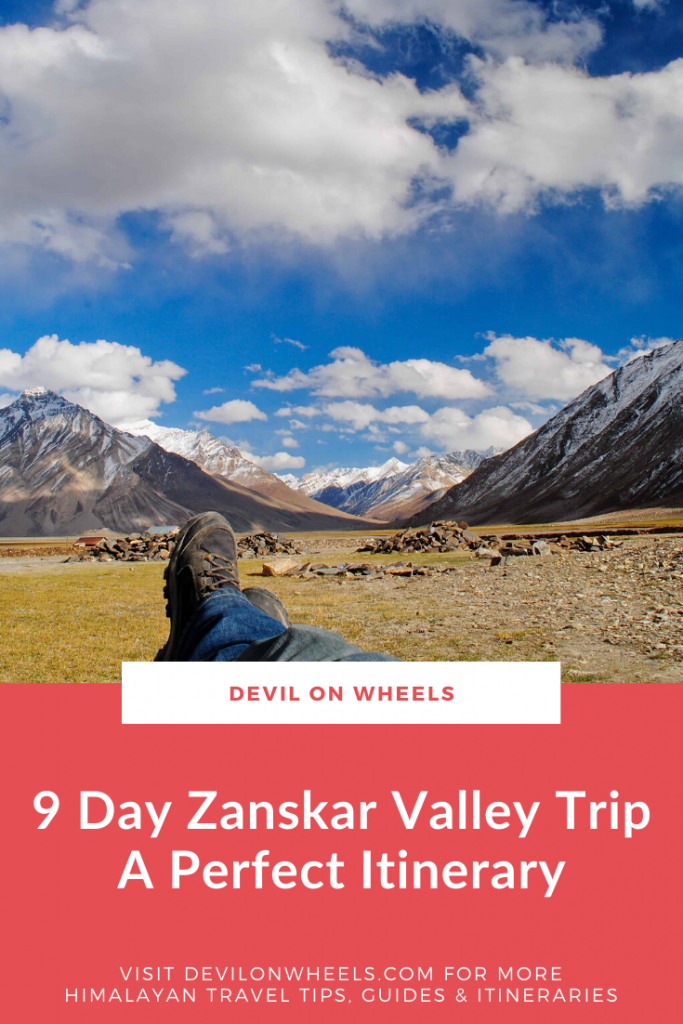
Suru and Zanskar Valley have started coming out to be the next popular adventure destinations in the Himalayas after Leh – Ladakh and Spiti Valley . It is not a surprise as other destinations have been flocked with tourists, adventurists are looking out towards more secluded and peaceful locations in the Himalayas .
Hence, nestled in the remote corner of Ladakh district, Zanskar Valley is the appropriate candidate for being popular among adventure-loving tourists. As more and more questions have started appearing on Discover with Dheeraj website for different plans of Zanskar Valley, in this article today, I will share a detailed travel plan covering Zanskar Valley from Leh in 9 days .

Let's quickly dive into the details:
Do I need Inner Line Permit for the Zanskar Valley trip from Leh?
There is no need for an inner line permit to visit Zanskar Valley. Hence, in case you are not visiting any other sightseeing places in Ladakh, no permit is required for Zanskar Valley.
However, you must note that in case you are planning to hire a taxi, Ladakh taxi can only drop you to Kargil, where you will have to take a Kargil based taxi to drop you to Padum. Once you reach Padum, you will have to hire a local Padum based taxi, which can help you do sightseeing in Zanskar Valley and drop you back to Kargil and Leh.
These taxi rules are quite complicated in Zanskar Valley, and at times, they do allow Kargil based taxi but not always. So, keep this important distinction in mind 😀 …
Dheeraj Sharma
Mode of Transport in Zanskar Valley
You can check the Leh – Ladakh taxi union rate list 2019 – 20 including the contacts of some reliable taxi drivers within Leh – Ladakh. They will easily offer about 12-15% of discount by directly getting in touch with drivers and of course, talking in person rather on the phone always help in bargaining more. Try to call the local drivers directly to connect with them and check the more comprehensive List of Taxi Drivers for Ladakh – Srinagar – Leh – Manali with recommendations/reviews for DoW community members.

In case you love to ride the bike and want to rent a bike for Zanskar Valley trip, you can refer Leh – Ladakh Bike Rental Rates 2020-21 . However, I will highly recommend that you plan a bike ride to Zanskar Valley only if you have experience of riding in trans-Himalayas on bad dirt roads with bumpy rides. If you have any back pain issues, then please stay away from a bike ride.
9 Day Travel Plan – Zanskar Valley from Leh
In this itinerary of Zanskar Valley, as you will be flying directly to Leh which is located at an altitude of about 3500 Mtrs. Hence, you must acclimatize properly in order to combat acute mountain sickness . It is of utmost importance to rest for at least one day before moving or travel anywhere in Ladakh or towards Zanskar Valley. Please do not take AMS lightly.
You are safe to travel down towards Alchi or Kargil on the first day in case you wish, but I have taken a conservative approach to rest on the first day.

Now, let’s look at this detailed day by day travel plan for making a trip to Zanskar Valley from Leh.
Day 1 | Delhi – Leh (By Flight)
- Checkin at Hotel. Many hotels provide free pick and drop from Airport. Ask while you book them.
- Take ample rest as well as water or anything that keeps your body hydrated enough. DO NOT OVER HYDRATE. Take ORS Soluted water or ORS – L tetra packs from home.
- Do not overexert your body at any cost. Avoid too much up-down on stairs or avoid it in entirety, if possible.
- After 5-6 Hrs of rest, you can visit Leh Palace, Local Leh market, Shankar Gompa .
- If you feel exerted, go back to the hotel, have dinner at the Hotel and take rest. Avoid any exertion.
- Follow the sunset by a stroll at Changspa road and have a nice dinner on varied cuisines offered in-around Changspa road.
- Go back to the hotel for an overnight stay at Leh.
- Overnight at Leh
You do not need to pass Zojila when traveling to Zanskar Valley from Leh side.
Day 2 | Leh – Lamayuru – Kargil
- Cover Mulbekh Maitreya, Lamayuru Monastery, Lunar Landscapes
- On the way, you can also cover Sham Valley sightseeing that includes Gurudwara Pather Sahib, Magnetic Hills, Confluence at Nimmu
- Overnight at Kargil
Day 3 | Kargil – Sankoo (42 KMs) – Panikhar (67 KMs) – Parkachik (98 KMs) – Rangdum (138 KMs) – Penzi La (165 KMs) – Padum (255 KMs)
- Have breakfast either at Kargil, preferably packed breakfast from the hotel
- It is going to be a long day, hence, leave for sure by 7 AM
- Have lunch at Rangdum, specifically not letting you stay at Rangdum as it a much harsh place than Padum with the least facilities. So, better break journey while coming back
- Beautiful Stod River join you after descending from Penzi La
- Will take about 9-11 Hrs
- Overnight stay at Padum
Day 4 | Rest day at Padum or visit to Zongkhul Monastery
- Rest at Padum and enjoy the stay to acclimatize better
- After lunch, you can do Padum – Tungri (17 KMs) – Zongkhul (37 KMs)
- Will take about 2-3 Hrs
Day 5 | Padum – Stongde (15 KMs) – Zang La Fort (32 KMs) – Karsha (62 KMs) – Padum (74 KMs)
- Explore local sightseeing in Padum including Sani, Stongdey, and Karsha monasteries, Zang La Fort
- An old monastery situated in the nearby village of Tsa-zar, midway between Stongde and Zangla
- Sheela Village Waterfall : You can spend some time at the waterfall at Sheela village while coming back to Padum from Stongde
- Karsha monastery : Evening visit for a nice view of Padum village
- Stongde monastery : Morning visit for better views
- Zang La Fort : Ahead of Stongde and offers some scenic wide views
- Will take about 3-4 Hrs
Day 6 | Padum – Penzi La Pass (90 KMs) – Rangdum (117 KMs)
- On the way see and click some lovely pictures of Drang Drung Glacier
- Spot some wildlife including Marmots as well on the way to Penzi La
- Stop by at Statso – Langtso Twin Lakes on the way to Penzi La
- Some time at Penzi La with pictures
- Rangdum Gompa is a MUST DO which is about 2-3 KMs from Rangdum
- Enjoy any leftovers while going towards Padum earlier
- Will take about 5 Hrs
- Overnight stay at Rangdum, avoid JKTDC Rest House at Rangdum and prefer a homestay
Travel Tip : If you are driving yourself to Zanskar, you must check 40 must-have things to carry on a self-drive road trip to Zanskar Valley .

Day 7 | Rangdum – Parkachik (40 KMs) – Sankoo (96 KMs) – Umba La – Drass (160 KMs)
- Spend some time at beautiful Panikhar village and enjoy the scenic beauty around
- Excellent views of Nun – Kun from Purikutchey
- Trek down to the river and relax for a while on the way
- The rock-carved Maitreya at Kartse Khar
- Have lunch at Sankoo
- Give a shot at the unexplored Umba La route on the way back
- Will take about 7-8 Hrs
- Overnight stay at Drass
Day 8 | Drass – Kargil – Lamayuru – Leh
- Cover Kargil War Memorial
- Cover Mulbekh Maitreya, Lamayuru Monastery , Lunar Landscapes
- On the way, you can also see Gurudwara Pather Sahib , Magnetic Hills, Confluence at Nimmu
- About 9-10 Hrs drive, depending upon the breaks you take in between
Day 9 | Leh – Delhi By Morning Flight
- Back to Sweet Home
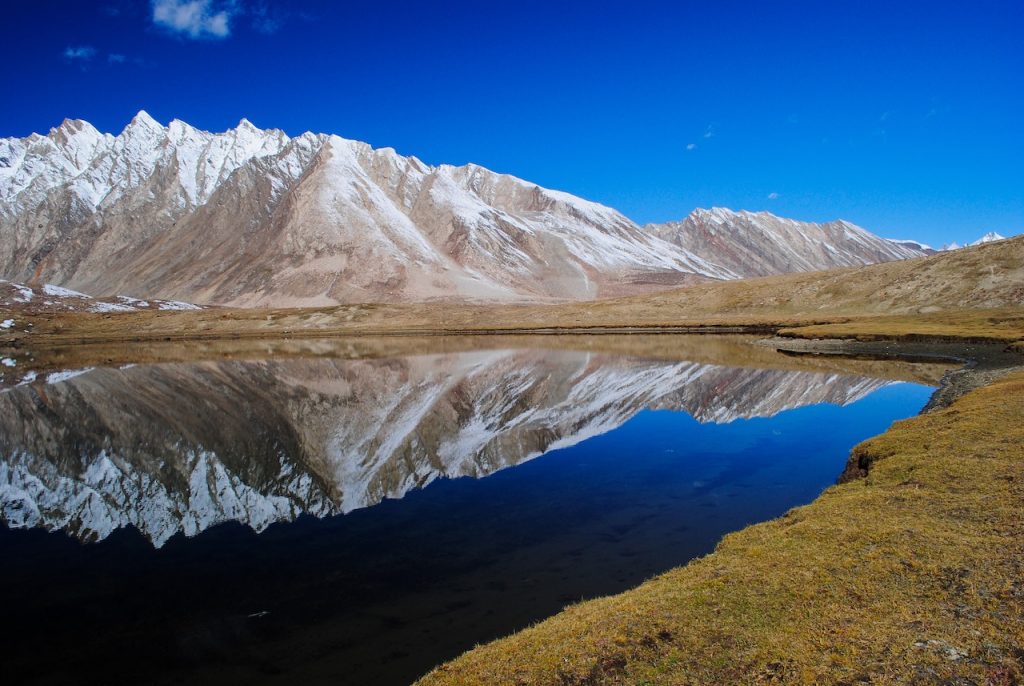
Other Important Links for Zanskar Valley
These are some of the most commonly referenced articles on the Zanskar Valley on Discover with Dheeraj website. Please refer to them in case you have any questions regarding these topics.
- Best Time to Travel Ladakh & Zanskar Valley
- How to plan a journey to Zanskar Valley
- Zanskar Valley – Most Common Itinerary
- Local Sightseeing in Padum – Zanskar Valley
- How to make a budget trip to Zanskar Valley by public transport?
- Phugtal Monastery Trek – A Travel Guide
- How to calculate cost or budget for Zanskar Valley trip?
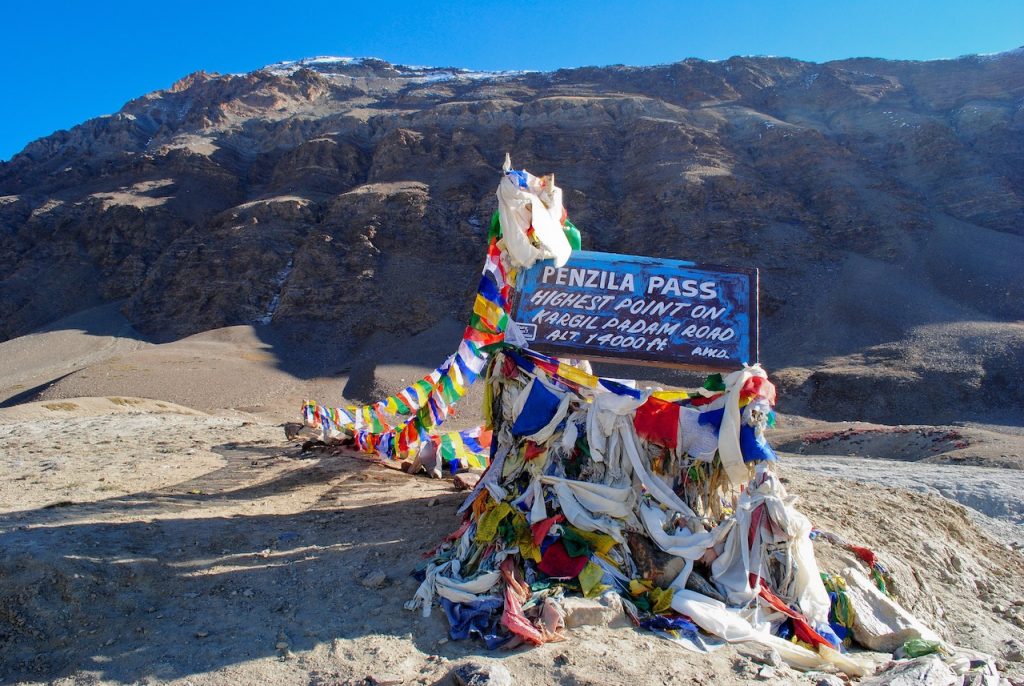
Zanskar Valley via Darcha – Shingo La Route
As of 2019 September, only one car was able to reach Padum from Darcha – Shingo La route. In the coming years, I expect to see this route from Manali – Darcha – Padum getting more attraction from the tourists.
Once it is fully operational and safe for travel, I will share more details on this route itinerary as well.
I hope this article helps you planning a trip to Zanskar Valley from Leh. You can always tweak this article in case you are planning to travel within Ladakh or travel down from Manali – Leh Highway instead of flying out of Leh or maybe even come from Srinagar – Leh Highway and travel down to Manali – Leh Highway. I will share those itineraries in the next few posts.
Have a travel question?? You can follow me on Instagram and subscribe to my YouTube channel to ask your travel questions in a direct message on Instagram or comment on my YouTube videos.
But, I am sure, if Zanskar Valley from Leh is what you need, this article will help you in finalizing the plan. If you have any questions about your Zanskar Valley trip, please feel free to post them on this website or my Instagram profile.
In case you have made a trip to Zanskar Valley and want to share any tips or suggestions with other fellow travelers, please share them in the comments section. If you wish to write a post for Discover with Dheeraj as a guest author, I can also set up your account to share the experience of your trip to Zanskar Valley.

In the end, if you know a friend or a family person who is making a trip to Zanskar Valley from Leh Ladakh, please feel free to share this article with them as well.
- X (Twitter)
I am Dheeraj Sharma - a traveler, techie, and Himalayan lover. Since 2009, I have been helping thousands of travelers every year plan memorable & budget-friendly trips to the Himalayas - Smartly, Safely, and responsibly.
Related Posts
Manali to leh via zanskar – shinkula pass [new complete guide], lahaul valley trip – the most complete travel guide for tourists, suru valley – 7 beautiful & must visit places for travelers in 2022.
Comments section gets closed in 90 days. To ask your travel questions, you can follow my YouTube Channel for a faster reply or for a much slower reply follow me on Instagram . :)
Can someone suggest any change that we might have to do in the itinerary?
Day 1: Early morning flight Delhi to Leh 0740 hrs arrival. Spend remainder of the day resting. (Shanti stupa popular sunset + Leh palace + Local bazzar)
Day 2: Leh kargil highway -> Hall of fame museum -> Gurugwara pathar sahib -> Magnetic hill -> Confluence of indus and zanskar river -> Spituk Monestry -> Leh
Day 3: Nubra valley -> After 2 hours -> Khardungla -> Indus Valley (Rest) -> Hunder sand dunes and camel ride (Overnight stay in hotel)
Day 4: Nubra -> Khardungla-> Leh (Diskit monestry on hill top ) Optional: Jokhng leh mosque, Central asian museum
Day 5: Leh -> Changla pass -> Pangong (Chang thang valley -> Chang la(2nd highest point)) -> Tangtse temple(OPT)-> Overnight in tent or guest house
Day 6: Pangong -> Thicksey Gompa -> Shey palace -> Leh
Day 7: (Friday morning )Leh -> Manalli Day 8: (Saturday) Leh -> Manalli (Reach in afternoon by 2PM) Bus at 5PM
Your plan is nice and good and relaxed. Go ahead with it.
Type above and press Enter to search. Press Esc to cancel.
Privacy Overview
Ad blocker enabled.
HOW MANY DAYS ARE REQUIRED TO COVER ZANSKAR
- ZANSKAR OVERVIEW
- Why should you visit ZANSKAR
- Weather in ZANSKAR
- Where is ZANSKAR
- Do I require permits for visiting ZANSKAR
- How safe is ZANSKAR
- How do I reach ZANSKAR
- What do I see in ZANSKAR
- Most Preferred Itineraries for ZANSKAR
- Where to stay while in ZANSKAR
- Adventure Activities in ZANSKAR.
Invariably, a visit to the ZANSKAR valley is linked to the LADAKH itinerary & hence assumes a very unjust & insignificant time allocation for its coverage. But a visit to the ZANSKAR valley cannot be considered to be complete without experiencing a taste of its spiritual culture & local hospitality. Most of the journey covers the diverse landscapes ranging from the green SURU valley, PARAKCHIK glacier, RANGDUM, PENZI LA, DRANG DRUNG glacier & the long remote stretches. I have seen people considering ZANSKAR as a touch down point and returning back the next day.
In most of the itineraries, a visit to the ZANSKAR valley does not include more than 3 or 4 days, out of which 2 complete days are spend on the to & fro travel time. The remaining 1-2 days are good enough to cover the local sightseeing. However, if you want to include PHUKTAL monastery in your ZANSKAR itinerary, it would require atleast 3 additional days at a reasonably good pace. A good trekker may be able to do it in 2 days too, but it would be very tiresome.
Hence I would recommend as follows
- 3 days (Kargil – Padum – Kargil) without PHUGTAL monastery trek
- 4 days (Kargil – Padum – Kargil) without PHUGTAL monastery trek
- 7 days (Kargil – Padum – Kargil) with PHUGTAL monastery
3 DAYS ITINERARY (KARGIL – PADUM – KARGIL)
DAY 1 (KARGIL to PADUM)
- If you are driving a self owned vehicle, it would be recommended that instead of Kargil, you should try to extend yourself till PURIKUTCHEY / SANKOO on the earlier day. By doing this, you can get more time this day for enjoying the journey enroute.
- Start by 06:00 am to 06:30 am from KARGIL / PURIKUTCHEY. Enroute, visit the Trespone Mosque for SURU valley view, Nun Kun peaks, Parakchik Glacier, Rangdum Gompa, Penzi La, DRANG DRUNG glacier & Reach Padum. Enroute you can break at RANDUM for lunch break.
- Visit the KHAR Palace in the morning to get a complete view of PADUM, PIBITING & KARSHA.
- Proceed to ZANGLA FORT overlooking the ZANGLA village & ZANGLA nunnery. Enjoy the fantastic views from a deserted Fortress which was once a capital of ZANSKAR.
- Visit the STONGDEY Monastery to be fascinated by the Vast Valley Views & the aerial view of the village below. (The view from the monastery gallery is my all time favourite in Zanskar)
- Visit the KARSHA Monastery to see the life at KARSHA. You will find the little lamas in the schools at KARSHA looking amazingly at you. At KARSHA, enjoy the evening view of PADUM from a distance.
- Next to KARSHA is STAMSLING Nunnery. Although, it looks very close to KARSHA, there is no direct access route. One would have to do a long turn to visit the Nunnery.
- Enroute back to Padum, visit the PIBITING Monastery perched in the middle of the valley on a hillock.
- Start early by 06:00 am to 06:30 am. Enroute, 6 kms from PADUM, you can visit the SANI Monastery.
- If you start early from PADUM, you can make a detour of 16 kms from TUNGRI to cover ZONGKUL monastery enroute. Instead of taking a right turn to take the bridge at TUNGRI, go straight further 16 kms. You will have to back track the same distance till TUNGRI & take the bridge for a KARGIL.
- Break at DRANG DRUNG glacier to get a glimpse of the amazing glacier.
- Halt at RANGDUM for lunch
- Depending on the available time, you can decide to break the journey at PURIKUTCHEY, SANKOO or extend further till KARGIL.
4 DAYS ITINERARY (KARGIL – PADUM – KARGIL)
- Visit the STONGDEY Monastery to be fascinated by the Vast Valley Views & the aerial view of the village below.
- Visit the ZONGKUL MONASTERY in the morning to see the magnificent monastery embedded in a cave.
- While on your return, see the SANI monastery. Break for lunch back in Padum.
- Post lunch, proceed to BARDAN monastery to see the Monastery perched on a hillock.
- Go further to MUNEY monastery.
- Return back to PADUM. You can spend the evening at PIBITING monastery.
- Start early by 06:00 am to 06:30 am.
- It would take about 11-12 hours from PADUM to KARGIL considering all breaks.
7 DAYS ITINERARY (KARGIL – PADUM – PHUKTAL – PADUM KARGIL)
- Start by 06:00 am to 06:30 am from KARGIL / PURIKUTCHEY. Enroute, visit the Trespone Mosque (for SURU valley view), Nun Kun peaks, Parakchik Glacier, Rangdum Gompa, Penzi La, DRANG DRUNG glacier & reach Padum by evening. Enroute you can break at RANDUM for lunch.
- Next to KARSHA is STAMSLING Nunnery. Although, it looks very close to KARSHA, there is no direct access route. One would have to take a long turn to visit the Nunnery. It offers the same views as KARSHA.
- Enroute back to Padum, visit the PIBITING Monastery perched on a hillock in the middle of the valley.
DAY 3 (PHUKTAL Trek) 30 kms drive & 8 hours trek.
- Start early from PADUM & hire a taxi for a drop / drive till Icher village. It’s a 30 kms drive & would take approximately 1.5 hours. Enroute, you can visit the BARDAN & the MUNEY monastery. Insist on a drop till the last motorable point at Icher on this journey.
- ICHER to ANMO is a 5-6 hours trek. Anmo to CHA would be another 2 hours. Break for the night at CHA preferably OR at ANMO
DAY 4 (CHA – PHUKTAL – PURNE) 6 hours trek
- Start off from CHA & visit the PHUKTAL Monastery (2.5-3 hours trek).
- Return on the same route OR to PURNE village (3 hours trek). Break for the night at PURNE.
DAY 5 (PURNE to PADUM) 8 hours trek with 30 kms drive.
- Start off from PURNE & break your journey at ANMO for snacks / lunch.
- Trek to ICHER for about 5-6 hours.
- Drive / Call a taxi from ICHER to PADUM.
- Enroute visit the MUNEY & BARDAN monastery if not covered while on Day 3. Ideally, it is recommended that you visit BARDAN on Day 3 (while travelling to PHUKTAL) & halt at MUNEY monastery on DAY 5, so that the time span is evenly divided.
DAY 6 (PADUM -ZONGKUL – SANI- PADUM) 64 kms drive.
- In the second half, you can either re visit the STONGDEY monastery or the PIBITING monastery.
DAY 7 (PADUM – KARGIL) 240 kms drive.
Ladakh with Zanskar Valley
- No Of Days 12N/13D
The stark and glorious land of Ladakh is located in Jammu and Kashmir. Yet, it is so far removed from what one expects of Kashmir, both in terms of geography and culture. A Ladakh tour will show you a very different and awe-inspiring world. Ladakh itself is separated from the Kashmir valley by the Himalayan range and the difference is immense. The breath-taking landscape is almost magical. Ladakh is known to be the world’s coldest desert. Here, you will find glaciers and sand dunes and freezing winds shaping the raw landscape.

Tour Highlights
Leh, Tingmosgang, Lamayuru, Kargil, Zanskar – Rangdum, Padum & Monasteries
Tour Information
Leh – excursion to monasteries (50 kms / 02 hrs – one way), leh to sham valley (92 kms / 4 hrs), tingmosgang to kargil (via lamayuru) 143 kms / 5 hrs, kargil to rangdum (130kms/6hrs), rangdum – padum via suru valley (131 kms/5 hrs), in padum (excursion to karsha & bardan gompa) approx 5 – 6 hrs, in padum (excursion to stongde & zangla) approx 6 – 7 hrs, padum – rangdum via suruvalley (131 kms/5 hrs), rangdum – kargil (130 kms / 6 hrs), kargil to leh (210 kms / 6 – 7 hrs), depart leh (fly out).
- Package Inludes
- Package Excludes
- Travel Document
· Assistance on arrival at Railway station/Bus stand/Airport
· Welcome, Drink on arrival (Non-Alcoholic).
· 12 Nights and 13 Days accommodation at a good hotel as per the respective rooms.
· Entire Site seeing by AC car
· Pick and Drop from New Delhi Railway Station/Airport
· All Toll Tax, Green Tax, Parking Charges, and Driver Stay during Visit.
· Maximum KM blockage will be 2000 km with Toll Tax, Parking, Night Halt,Etc.
· Fare – Air/Train
· Any Entrance fees for monuments or sights
· Rides and other charges
· Government Service Tax
· Taxi service not exclusively mentioned in the package.
· Only items explicitly mentioned in the package are inclusive, otherwise all are exclusive.
While on Trip you need to carry your Identity Proof's along with you. At Hotels Manager or Receptionists may ask for your travel documents. Documents needed are mentioned below in accordance with age
- ADULT: Voters ID / Passport / Aadhar Card / Driving Licence
- CHILD (5 to 11 years) : Passport / Aadhar Card / PAN card
- CHILD (2 to 4 years) : Aadhar Card / School ID
- For Infants - Carry 2 passport sized photographs
Tour Gallery
Similar packages.
.webp)
Highlights of Ladakh
Journey on Leh – Kargil Highway from Leh To Sham Valley (75 Kms / 4 Hrs). Enroute visiting Gurudwara...
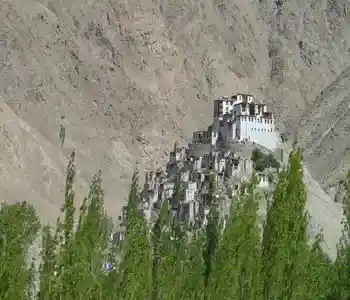
Monastery Tours
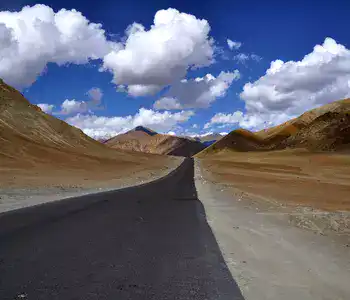
Ladakh Incentive Tour
Leh, Monasteries, Sham Valley, Tsomoriri Lake, Pangong Lake & Nubra Valley

Trekking to Phugtal Monastery

Manali to Shrinagar via Ladakh

Offbeat Ladakh with Adventure
.webp)
Discovering Manali and Ladakh
View all Tours
Quick Enquiry
Zanskar valley tour
Phuktal, padum, karsha....
The Zanskar valley is a hidden gem for travellers seeking an authentic village life experience in the remote Himalayan region. It is also home to numerous monasteries steeped in history, with the most renowned being the enchanting Phuktal monastery .
The Zanskar valley is accessed from Leh and the Indus valley via Singe La pass at an altitude of 5,360 metres above sea level. After descending from the pass, you will arrive at Lingshed , a charming Zanskari village with a prominent whitewashed gompa.
The town of Padum , the capital of Zanskar, serves as an ideal base for exploring the nearby villages, palaces, and monasteries of the region, including Zangla , Stongde , Karsha , Bardan , Sani and Zongkhul .
As you drive from Padum towards Rangdum , you will encounter a variety of natural wonders, such as Pensi La & Drang Drung glacier , Parkachik glacier & Nun Kun Peak and the breathtaking Suru valley .
As part of your Zanskar tour, you will have the chance to explore all the attractions situated between Leh and Kargil in the Sham region of Ladakh. This includes visits to the well-known monasteries in the Indus valley, such as Alchi , Likir , Lamayuru , Shargole , Rizong , Basgo , Phyang and Spituk .
Other nice places that you will be able to see during this tour include the 8-metre-high Maitreya Buddha rock carving at Mulbek , the confluence of Indus and Zanskar rivers known as Sangam , the mysterious Magnetic Hill and the Sikh place of worship Gurdwara Pathar Sahib .
OTHER TOURS THAT MAY INTEREST YOU
Places to visit in zanskar valley, phuktal monastery.
Phuktal monastery , situated in the southeastern part of the Zanskar region in Ladakh, is the most impressive attraction in the area and one of the most secluded gompas. It is constructed around a natural cave, a sacred site believed to have drawn scholars, translators, and monks over 2,550 years ago. Its remote location made it an ideal haven for monks seeking tranquility for meditation. The present-day Phuktal monastery follows the Gelug school of Tibetan Buddhism and was founded in the early 15th century by Jangsem Sherap Zangpo, a disciple of Je Tsongkhapa.
The name 'Phuktal' derives from the Zanskari dialect, where 'Phuk' means 'cave,' and 'tal' means 'at leisure'. Reaching this monastery involves a two-hour walk, making it an ideal adventure for hiking enthusiasts who want to experience the natural beauty along the Tsarap river.
Padum , situated at an altitude of 3,669 meters, serves as the capital of the Zanskar region and is home to approximately 1,500 residents. This charming town provides a variety of amenities, including quaint restaurants, hotels, guesthouses, and shops. It offers easy access to nearby villages and monasteries, making it an ideal central hub for travelers seeking to explore the Zanskar region.
Singe La Pass (5,057m)
Lingshed monastery.
Lingshed monastery is an historical and spiritual treasure nestled amidst the majestic Zanskar Range mountains on the south side of Singe La pass. Founded in the 1440s by Changsems Sherabs Zangpo, a disciple of Je Tsongkhapa, it is located 83 kilometers north of Padum. This Gelugpa Buddhist monastery has a rich history, originally established on a monastic site founded by Translator Rinchen Zangpo.
Karsha Monastery
Karsha monastery stands as the largest and most significant monastery in the Zanskar valley. Affiliated with the Gelugpa or Yellow Hat sect, this monastery comprises a series of 30 whitewashed buildings, cascading along the mountainside.
Presently under the guidance of the younger brother of the 14th Dalai Lama, Karsha monastery was established by the Buddhist master Phagspa Sherab, who introduced Buddhism to the Zanskar valley and is attributed to Guru Padmasambhava. Within the monastery, you can find numerous shrines, ancient rock carvings and the Avalokiteshvara Temple. However, the most remarkable feature of the monastery is a chorten that houses the mummified remains of Rinchen Zangpo, an incarnate lama, enclosed within a wooden box adorned with silver.
Zangla Palace & Monastery
Zangla village , once ruled by a monarch who still resides here with his family, is a unique and historic place. An old palace on a nearby hillock, just a 15-minute hike away, overlooks the village. Inside the palace, an intact Buddhist shrine offers breathtaking views of the valley.
Stongde Monastery
Stongde monastery , one of the most significant gompas in Zanskar, may not appear very imposing when viewed from below, but it occupies a prominent vantage point that offers breathtaking views of the Zanskar valley, especially in the morning light.
Legend has it that Stongde was once situated on the shores of a large lake. A small, box-like room below the main monastery, which is believed to have been right at the lakeside about a thousand years ago, is said to have been used by the Tibetan Buddhist Great Translator Marpa Lotsawa for meditation.
While the current monastery structure mainly dates back to the 20th century, a small and atmospheric prayer room on the left side as you enter the inner courtyard houses ancient murals that are believed to be over 250 years old.
Bardan Monastery
Bardan monastery is a 17th-century Buddhist gompa, approximately 12 kilometers south of Padum, situated on the banks of the Lungnak river. This charming monastery boasts a grand Dukhang, an assembly hall adorned with magnificent statues of revered Buddhist deities and a collection of small stupas.
Sani Monastery
Sani monastery , located on a flat area much like Alchi, belongs to the Drukpa school and is affiliated with Stakna in Ladakh. This school holds a special reverence for the master Naropa , and a small chapel within is said to house relics of this great teacher. Sani monastery is a captivating blend of diverse elements spanning different eras and architectural styles.
Zongkhul Monastery
Pensi la & drang drung glacier.
Pensi La , located 150 km south of Kargil, is a mountain pass at an elevation of 4,400 meters above sea level. This pass connects the Suru valley and the Zanskar valley regions.
Rangdum Monastery
Rangdum , situated at the end of the Suru Valley, is the first Buddhist village along the route to Zanskar. The monastery, perched on a small hill, is affiliated with the Gelugpa order.
Parkachik Glacier & Nun Kun Peak
Parkachik glacier , situated on the slopes of Nun Kun peak, showcases its expansive icy terrain. This glacier is a prominent natural attraction.
Suru Valley
Situated to the south of Kargil, the Suru valley is a fertile and picturesque region embraced by the Suru river, a tributary of the Indus river. This charming valley not only sustains the local communities but also boasts awe-inspiring landscapes.
Best time to visit Zanskar valley
The Zanskar valley tour is feasible from mid-May to mid-October , when the Singe La pass is open to traffic. Throughout the rest of the year, the road is inaccessible. The responsibility for road maintenance and snow clearance falls under the purview of the Border Roads Organisation (BRO), a division of the Indian Ministry of Defence.
Tips for planning a trip to Zanskar valley
Altitude and acclimatization, permit for zanskar valley, phone and internet service in zanskar valley, accommodation in zanskar valley, suggested itinerary for zanskar valley, zanskar valley (8-day tour), private taxi, shared taxi, map of ladakh, hotels in ladakh, sightseeing tours, tour packages, travel itineraries, practical info, ladakh travel guides, client reviews.

Zanskar Valley Trip Packages
Zanskar Valley is a rugged region in Ladakh, a home to the offbeat wanderers. It has the incredible lofty mountains of the Zanskar Range with lovely rivers and lakes. The valley can be reached either from Leh or Srinagar. From both sides, it is a long drive through mountainous landscapes. The valley has remained famous for mountaineers, trekkers, and for those looking for a serene travel escape.
One of the fantastic features of this remote place is the range of ancient monasteries here. You will see them from bazaars to the mountain cliffs. These monasteries have the monks in meditation for years, cut out from the rest of the world and living in serene mindfulness. The joy of traveling to Zanskar is to explore these monasteries, along with, of course, the barren mountains of this region.
Discover the beautiful landscpaes of Leh Ladakh through: Ladakh Tour Packages.
In Zanskar Valley Tour you explore this entire region. From short hikes to cultural tours to the visit of ancient Buddhist monasteries, the tour makes you see one of the remotest places in India. Your tour package will cover all tour requirements. From transportation services to hotel bookings, from activities like hiking to cultural tours, you will have a guide for everything related to this tour.
We’ll discuss Zanskar Valley Trip and its most significant features to help you get a sense of what it’s like to be there. Continue reading to learn about how beautiful Zanskar is!
Zanskar Valley Tour Itinerary
Day 2: Drive to Suru Valley. The drive on this drive will expose you to the breathtaking beauty of the Himalayas. You will go via the famous Zojila pass which connects Kashmir Valley to the Ladakh region. As you go down from the pass you will drive via Drass and Kargil. At Kargil, we have to take the right to reach Suru Valley. Explore Suru Valley, the famous Sanku Village, and the base camp to Nun Kun Peaks. Night stay at Suru Valley.
Day 3: Drive to Padum. We will be exploring the different places on the way. See the long and most cherished Suru River and Drang-Drung Glacier. Further, you will be driving over Pansila Pass and Rangdum. Night stay at Padum.
Day 4: Padum Exploration. Padum is God’s Calm country. This is the place where time stops, and you feel like you have been transported back to 100 years. Explore the local culture, tradition, architecture, food, and varied monasteries and stupas. Night stay at Padum.
Day 5: Drive to Kargil. Explore Kargil Market and the villages. Night stay at Kargil.
Day 6: Reach to Srinagar. On this day we will be having a good time in the Drass Valley, visiting the second coldest inhabited village in the world here. Take a stroll through the village. Also visit, Thajwas Glacier of Sonamarg. Night stay Srinagar.
Day 7: Departure.
Zanskar Valley Trip Cost
- All Days Transportation Srinagar airport to Srinagar airport. SUV Cabs only.
- Transportation for sightseeing in Zanskar valley.
- All night’s stay during the trip. The sharing of double or triple available as per the cost mentioned above.
- All passes and permits.
- All tour coordination.
- Fuel, Taxes and tolls.
- Driver food and lodgings.
- Personal Expenses.
- Anything not mentioned in the inclusion list.
Things to Do in Zanskar Valley
Below are the handpicked attractions of Zanskar. These are the best things to do in Zanskar Valley. Get to know them before you plan your travel to Zanskar.
Trekking: Most trekkers and travelers know about the Chadar Trek or the Frozen Lake Trek which is the most sought-after trek in Zanskar Valley during the winter. This trek is possible only in the winter months because that’s when the temperatures are below freezing point and it’s extremely cold in this region keeping the Chadar Lake frozen.
Book here the most beautiful trek in Leh Ladakh: Markha Valley Trek
Not many people know that there are plenty of summer treks here too. From short day hikes to the long treks across the region. The Padum Darcha trek, the Lugnak Trail, and the Zanskar-Sham Valley trek are also popular in Zanskar.

Bike Rides: The Zanskar Valley is a biker’s dream . Bike riding in the Zanskar can give you an adrenaline rush. Besides, biking e here, and river rafting at Zanskar valley can be enjoyed too.
The bike tour makes you explore this place fully. You tend to go to that part of Zanskar which is otherwise quite inaccessible. The road in and around this valley are in bad conditions, so bikes let you go beyond them. The valley is connected to Leh, Srinagar, Kisthwar, Manali etc. And to explore these places nothing is best than the bike tour.
Enjoy the adventurous bike ride through: Leh Ladakh Bike trip
Baralachha Pass : A splendid pass through a spectacular landscape is what makes traveling through the Baralachha Pass a unique experience. This pass lets travelers get a view of the beautiful Zanskar mountains as well as the Pir Panjal mountain range.
Sangam Point : Sangam Point is a spectacular place to view an amazing blend of two beautiful rivers the Indus and the Zanskar rivers. The point where these two distinctly colored rivers meet is called the Sangam Point. Tourists are surely going to be bedazzled with this natural, colorful, and adorable show of the pristine Indus and Zanskar rivers. Everyone who comes here will take the most pictures of this truly picturesque display of nature, right here in the Zanskar Valley!
Festivals and Culture: If you thought Zanskar Valley was only about the mountains, rivers, lakes, and adventures then that’s not all about it. The festivals, celebrations, and culture of the Zanskar are what make this place a truly colorful and adorable one. The Sani festival, the holy dance by the Lamas, and the beautiful blend of Tibetan, North Indian, and Chinese cultures visit the Zanskar an amazing and enriching experience.
Monasteries : Visiting monasteries in Zanskar or for that matter anywhere in Ladakh is an amazing experience. Monasteries in Zanskar have enlightened monks, gorgeous Gautam Buddha statues, colorful artwork, and ethnic architecture to be impressed by. Monasteries are a place for meditation, peaceful stays, a celebration of holy festivals, and learning about the enlightened living of the Lamas from the monks themselves. Zanskar Valley has some great monasteries to be visited by all the tourists coming here. some of the popular monasteries are Likir Monastery , Alchi Monastery, and Thiksey Monastery .
Visiting monasteries is a beautiful experience for everyone and all age groups. Moreover, the monasteries in Zanskar are so aesthetic that clicking photographs here can give you some splendid photogenic memories to cherish for a long. The names of some monasteries in Zanskar are already mentioned in this blog, still, we add the names of the famous Tibetan-Indo monasteries in Zanskar Sani, Lingshed, Stongdey, and Phuktal monastery.
Local Cuisine and Delicacies: Whether you are on a trek or sightseeing in Zanskar, taking a break to enjoy a sumptuous breakfast, lunch, snacks at snack time, and dinner is essential and enjoyable. Thukpa (soup with vegetables and noodles), Momos, Skyu (traditional soup), Tingmo (steamed Tibetan bread with dal, cooked vegetables, or meat), Chutagi (a pasta-like dish served with vegetable-based sauce), Chhurpi (Yak Cheese), Khambir (Ladakhi wheat-bread) and the most important Kahwah (tea) are some of the local foods that every traveler in Zanskar must insist on and try out. This is all part of Zanskar valley trip.
Enjoying filling meals made from local ingredients as well as readily available noodles (known as Maggi in India) adds to the delightful experience for all visitors to the Zanskar. From very young to seniors, all can come to Zanskar Valley just to enjoy eating in nature’s spectacular setting!
Popular Places in Zanskar Valley
Zanskar Valley is a stunning and remote valley known for its amazing landscapes, monasteries, and unique culture. Here are some of the best places to visit in Zanskar Valley:
1. Padum: The largest and the prime town in Zanskar, Padum is the administrative center of Zanskar. It is surrounded by scenic landscapes. The old town, with its traditional houses and monasteries, is worth exploring. This is the place where you will get the best of stay options, rather only at Padum you get to stay in Zanskar Valley.
2. Karsha Monastery: One of the largest and the popular monasteries in Zanskar, Karsha Monastery provides panoramic views of the surrounding mountains. It is an important religious center and a cultural center of the entire Zanskar Valley and has remained so for many decades now.
3. Zangla: Known for its ancient Zangla Palace, this village is a peaceful and charming place with beautiful mountain views. The palace is now in ruins, however, provides a glimpse into the history of the region. This is one of the best places to visit in Zanskar Valley.
4. Stongdey Monastery: While on the Zanskar Valley Trrip, you must visit this Monastery. Situated on top of the hill, Stongdey Monastery offers magnificent views of the Zanskar Valley. The monastery is known for its beautiful architecture and ancient artifacts.
5. Phuktal Monastery: This monastery is built into the cliffs and is one of the most isolated monastic establishments in Zanskar. This is further remote in Zanskar Valley for which no transportation goes. You will have to embark on the trek to reach this monastery. The trek to Phuktal is an adventure in itself, taking you through scenic landscapes.
6. Sani Monastery: Famous for its annual “Tsechu” festival, Sani Monastery is one of the oldest in Zanskar. The monastery has a collection of ancient murals and artifacts.
7. Zongkhul Monastery: This monastery is situated in a cave. This monastery is an interesting site to visit. It is known for its beautiful frescoes and a meditation cave used by Naropa, a renowned Buddhist scholar.
8. Suru Valley: Suru Valley is nearby and is an age-old destination for wanderers and ancient people. This forms part of the ancient route as well. It is known for its lush greenery, meadows, and the Drang Drung Glacier.

Highlights of Zanskar Valley Tour Packages
- The Zanskar Valley, which is 6,000 meters above sea level on average, is encircled by the breathtaking grandeur of the tranquil mountains.
- A walk known as the “Chadar” journey can be taken on the frozen Zanskar River during the winter months when it freezes to form a thick layer of ice.
- White water rafting and nighttime camping next to stunning mountains are both available at the Zanskar River.
- Adventure seekers can take on difficult treks on their zanskar valley trip like the Lugnak Trail Trek, Padum-Darcha Trek, and Zanskar-Sham Valley Trek in Zanskar thanks to its dangerous terrain.
Why Should You Choose Zanskar Valley Trip?
You must choose Zanskar Valley because of the variety of things one can explore and experience here. The beautiful blue rivers, pristine lakes, spiritually enlightening monasteries, challenging roads, and passes, silver glaciers, and of course the people and its culture. Zanskar is home to many monasteries like Sani, Lingshed, Stongdey, Phuktal Monastery, and Alchi Monastery .
Going through the Pensi La Pass overlooking the glaciers and the view of Suru Valley can be a mesmerizing experience. Most travelers are recommended to visit Zanskar Valley from May to September to enjoy the beauty of this valley to the fullest.
Zanskar Valley Trek Highlights
Zanskar Valley offers heaven for trekking enthusiasts. It has plenty of trekking trails. From short treks to trans-Himalayan long treks, the Zanskar Valley trek is the common name given to all these treks inside Zanskar. These treks offer several opportunities that allow you to experience its stunning landscapes, remote villages, and traditional Ladakhi culture. One of the most famous treks in the region is the Chadar Trek, which takes place on the frozen Zanskar River during the winter months. Here are some trekking options in Zanskar Valley:
1. Chadar Trek:
- Duration: Approximately 9-10 days
- Best Time: January to February (during the winter when the Zanskar River freezes)
- Highlights: Walking on the frozen river, stunning winter landscapes, visiting remote villages, and experiencing the unique culture of the region.
2. Padum to Darcha Trek:
- Duration: About 8-10 days
- Best Time: Late June to September
- Highlights: Crossing high mountain passes, exploring remote villages, visiting monasteries, and enjoying panoramic views of the Himalayas.
3. Stongdey to Zangla Trek:
- Duration: Approximately 5-6 days
- Best Time: June to September
- Highlights: Stongdey Monastery, beautiful landscapes, traditional villages, and a chance to experience the local culture.
4. Phuktal Monastery Trek:
- Duration: 5-6 days
- Highlights: Trekking through picturesque landscapes, visiting the unique Phuktal Monastery built into the cliffs, and exploring remote villages.
5. Darcha to Padum Trek:
- Duration: Around 14-16 days
- Highlights: Crossing high passes, scenic landscapes, remote villages, and monasteries along the way.
6. Zangla to Karsha Trek:
- Duration: Approximately 7-8 days
- Highlights: Zangla village and palace, Karsha Monastery, panoramic views of the Zanskar Valley.
7. Markha Valley Trek (extended to Zanskar):
- Duration: 15-18 days
- Highlights: Combining the popular Markha Valley Trek in Ladakh with an extension to Zanskar, offering diverse landscapes and cultural experiences.

Best Time for Zanskar Valley Tour Packages
This is the most frequent query regarding this valley. The best time to visit Zanskar Valley is from June to September. These are the prime summer months when the weather is pleasant, and the places are accessible. Here is how Zanskar Valley Trip looks in every season.
Winter: Zanskar’s winter season starts in December and it lasts until March. During this time, the region receives significant snowfall and extremely low temperatures. Which makes this place quite difficult to travel. This season is not recommended for any sightseeing.
However, the winter months provide the most thrilling experience. Just picture how freezing it would be to walk on a completely frozen lake.
Zanskar’s winter season is hip and exciting. It is quite cold outside, with temperatures ranging from -2°C to -25°C.
We merely advise all of our readers and visitors to be aware that visiting Zanskar and Ladakh in the winter is not recommended due to numerous other inconveniences that one may have to endure. However, we advise the courageous and knowledgeable to join.
Summer: Zanskar’s summer season lasts from June to September. Summertime temperatures range from 15 to 30 degrees Celsius. The daytime temperature can change from moderately hot to very hot. In Zanskar, the snow begins to melt in March, but it doesn’t melt and is cleared off the roads and valley until June. In Zanskar, summer may be a thrilling and exciting time of year. You can have a nice time in Zanskar throughout the summer if you have the right advice and assistance from travel experts.
Autumn: The autumn months of Zanskar are October and November. You get to see the most colorful landscape in these months. This is also quite a good time to visit this valley. However, the temperature gets cold in these months. Days are dry and sunny. Nights are cold and dry.
Monsoon: Due to its location in a rain shadow, Zanskar (Ladakh) experiences moderate to low rainfall throughout the monsoon season. The temperature range is 10 to 25 degrees Celsius. All tourists to the Zanskar Valley are strongly advised to travel to and explore the valley during the monsoon season!
How to Reach Zanskar Valley?
The Zanskar Valley is accessible from both Leh and Srinagar. It can be reached in several
By Air: One option is to travel to Leh first, then hire a taxi to travel to Zanskar from Leh. Most places in India have transportation options to Leh, including air, rail, and road. Landing at Kushok Bakula Rimpochee Airport in Leh is the most typical method of plane travel. You can take a taxi from the airport to get to Leh and/or Zanskar.
Similarly, you can land at Srinagar airport and then from there take a cab to Zanskar.
By Train: There are no direct trains to Leh or Zanskar from anywhere in India. To get to Leh or Zanskar, you can travel to Jammu Tawi and then take a taxi. Leh and Zanskar Valley are separated by 462 km, which can be travelled in 11 hours by car. Same way you can get from Jammu railway station to Srinagar by road.
By Road: Both Leh and Srinagar are connected to road to the national highways. You can come via road from any city in India.
The best way to reach Zanskar Valley is from Srinagar. You will have to take the road of Srinagar-Kargil-Padum. The distance from Srinagar to Zanskar Valley is 532 kilometers. The road journey from Srinagar to Zanskar Valley is full of adventure. To reach Zanskar Valley take the Srinagar-Leh highway to reach Kargil. Once you reach Kargil you have to cross another 250 kilometers to reach Padum. Book a taxi service in Srinagar to reach the final destination.
The distance from Kargil to Zanskar Valley is 230 kilometers approximately. The road conditions are good. You will enjoy the breathtaking views from Kargil to Zanskar Valley.
Where to Stay at Zanskar Valley
Since Zanskar Valley is an offbeat tourist place, you need to have the information about where to stay at Zanskar in advance. Padum in Zanskar has a variety of lodging and stay options. Padum has a wide range of budgets for Three-Star hotels. Camp stays are also available in Padum.
Tourists can also stay at Government-run guesthouses in Sankoo, Panikhar, Parkachik, and Rangdum. Karsha in Zanskar has both private guest houses and monasteries where visitors can stay. Homestays are available across Zanskar including all the places mentioned in this part of the blog and Reru and Hanumil.
While in Zanskar remember to carry warm clothes, water, food packets, cash, fuel, hygiene and sanitation essentials, a basic medical first aid kit, torch, suitable mobile phone sim card for better connectivity and an overall good experience. For a detailed list of must-carry things for a tour or trek in Zanskar Valley, you can seek information from travel planners. In our package of Zanskar valley trip, all of the lodgings are included.
Transportation & Communication
Network: The mobile network in Zanskar is very poor. There are multiple on your sightseeing or while going to Zanskar where there is no network at all. You will be struggling to get in touch with the rest of the world. In some places, there is quite a good network. In the hotels, you will have a Wi-Fi facility in Zanskar.
Transportation: Since this is a remote place with most of the road not in the right condition, you need to hire the best cab. Do not compromise on the cab quality and the driver credentials. Some shared cabs go to Zanskar Valley, however, they are very few.
Road Condition of Zanskar Valley: The road condition to Zanskar Valley is not all good. You will see some patches which are extremely in bad condition. The road at times is very bumpy and cut off from the blacktop road. You will have to be careful about the road conditions to Zanskar.
Things to Carry on the Zanskar Valley
Zanskar Valley will take you to the remotest regions of Ladakh. This is the most offbeat place you can go to. However, it is equally rewarding with its divinely charming vibe and landscape. There are a few things to carry on the Zanskar Valley Trip that you need to keep in mind before you embark on this tour.
Documentation: You must always carry your original IDs with you. If you are Indian, the Adhar card original is enough. However, for foreign nationals, carrying an original passport is a must.
Medicine: If you are on medicine, you must carry that as you won’t be finding any medical shops here. Only some basic medicine average that too quite remotely and scarcely. Also carry some basic medicine like pain killers, anti-fever, allergic, anti-sprain, etc.
Tour Plan: To visit this remote place, we recommend booking through a Travel Company only. As the travel company has a lot of contacts and knows how to handle any kind of emergency they can guide you very well in this. Cliffhangers have the best-on-ground staff in Zanskar that takes care of any contingency here in this region.
Tips for Visiting Zanskar Valley
Before visiting Zanskar Valley, you must keep in mind certain things to make your travel and vacation hassle-free and safe. Visiting Zanskar Valley can be a unique and rewarding experience, but it’s essential to be well-prepared due to the remote and challenging conditions. Here are some tips to help you make the most of your trip to Zanskar:
1. Acclimatization: Acclimatization is an essential part of Zanskar Valley Trip. Since this valley is situated at a high altitude, so you have to acclimatize properly. Spend at least one day in Leh or another location like Kargil before heading to Zanskar.
2. Weather and Clothing: Even in summer, temperatures can be cool, and winters are extremely cold. Bring warm feather jackets, insulated clothing, and waterproof gear. If you plan to trek during the winter, pack appropriate cold-weather clothing like thermals, fleece, gloves, woolen caps, woolen socks, etc.
3. Permits: Obtain necessary permits before traveling to restricted areas or engaging in specific activities. This is especially important for treks and visits to certain monasteries.
4. Local Culture: Respect the local culture and traditions. Zanskar has a rich Buddhist heritage, and it’s important to be mindful of local customs.
5. Transportation: Be prepared for bumpy and rough roads.
6. Cash and Essentials: Carry enough cash as ATMs are not available at most of the places in Zanskar. Bring essential items like a first aid kit, toiletries, and any specific medications you may need.
7. Communication: Mobile network coverage in Zanskar can be limited. Inform your family or friends about your plans and be prepared for limited connectivity.
8. Trekking Guides and Equipment: If you plan to trek, hire a local guide who is familiar with the terrain and weather conditions.

Zanskar Valley Tour Packages
There are several tour packages to choose from, and you must review a lot of information about these tour packages before making your decision. From duration, itinerary, accommodation, and travel or miscellaneous support, all is to be gone through to finally decide upon your best Zanskar Tour Package. For you, we are mentioning the basic details of some significant Zanskar Valley Tour Packages.
Ladakh With Zanskar Valley Tour : This tour could last between 12 and 13 days. You can go to places like Leh, Zanskar, Kargil, Manali, and Pelling. The cost of such a package could be around INR 20,700 for a person.
Chadar Trek Tour : A Chadar trek can take around 8 to 9 days. You can also visit and travel in Zanskar and Leh through such a tour package. This tour can cost you at least INR 12,000.
Leh To Zanskar Motor Bike Tour : A motorbike tour of Zanskar Valley can take 12 to 13 days. Bike tours are costlier since they require special arrangements to be done by the travel planners. On average, a good Zanskar MotorBike Tour package can cost around INR 35000.
Darcha – Padum Trek in Zanskar : Trekking in Zanskar through Darcha and Padum can take around 10 days or more. Places like New Delhi, Manali, Darcha, Zanskar, and Leh can all be explored and enjoyed. This is one of the famous seats of Zanskar valley trip.
Darcha Lamayuru Trek Tour : You can choose to go on a Darcha Lamayuru Trek of around 15 days and on the way take a delightful experience of visiting New Delhi, Manali, Zanskar, Purnia, Padum, Kargil, Leh, Darcha, Diglipur, Nowrozabad (Khodargama).
Zanskar River Rafting Tour : The Zanskar River, which runs wholly within Ladakh, India, is the Indus River’s first significant tributary and has a volume equivalent to or greater than the main river. It rises in the Great Himalayan Range’s northeast and drains the Himalayas and the Zanskar Range in the Zanskar area. Near Nimo, it runs northeast to join the Indus River. A river rafting tour at Zanskar River can be a wonderful experience. Zanskar, Oskarsham, Skelleftea, Sodertalje, Uddevalla and more.
Ladakh With Zanskar Valley Tour Package : This can be an exciting tour package. You can cover Bethlehem, Zanskar, Padum Manali, Lamayuru, Rangdum, etc., and have the most spectacular tour experience ever. 10 to 15 days could be ideal to cover all these beautiful places.
A Zanskar and Nubra Valley Tour : This exploration can be of around 10 days and you can explore two spectacular valleys of Ladakh, the Zanskar, and Nubra.
Srinagar-Kargil-Zanskar-Tour : Srinagar and Kargil can also be visited with your Zanskar trip and get to know almost the whole of Jammu and Kashmir. You can spend a week or more in these beautiful destinations of North India. Such a tour package can cost you around INR 15000.
There are a variety of Zanskar Valley trip packages available, and before selecting one, you must research a lot of information about each one. To choose the finest Zanskar tour package, consider all factors including duration, itinerary, lodging, and travel or other support. We’ve listed the essential information about a few noteworthy Zanskar packages for your convenience. Zanskar Valley Trip takes around 8-10 days for a complete experience.
Tour of Ladakh and the Zanskar Valley: This trip could take 12 to 13 days. Such locations as Leh, Zanskar, Kargil, Manali, and Pelling are accessible. An individual could have to pay about INR 20,700 for such a package.
Tour of the Chadar trip: A Chadar trip might last between 8 and 9 days. Through such a tour package, you can also visit and travel to Zanskar and Leh. You might spend at least INR 12,000 on this excursion.
Zanskar River Rafting Tour: The Zanskar River is the Indus River’s first significant tributary and has a volume equal to or greater than the main river. It entirely resides in the Indian state of Ladakh. It begins in the northeast of the Great Himalayan Range and drains the Zanskar Range and Himalayas in the Zanskar region. It flows northeast to join the Indus River close to Nimo. A river rafting excursion on the Zanskar River can be a fantastic adventure. among others, Zanskar, Oskarsham, Skelleftea, Sodertalje, and Uddevalla.
Tour of Ladakh and the Zanskar Valley: This may be a thrilling itinerary. With the most amazing tour ever, you can visit Bethlehem, Zanskar, Padum Manali, Lamayuru, Rangdum, etc. It can take 10 to 15 days to visit all of these stunning locations.
Zanskar Valley vacation packages are widely available from Cliffhangers India. Contacting Cliffhangers India can be your best option if you’re specifically seeking the Zanskar Valley tour or trek. Numerous offers are waiting for you.
How to reach Zanskar Valley?
There are multiple ways you can reach Zanskar Valley. One can choose to reach Leh first and then hire a cab to reach Zanskar from Leh. To reach Leh you can travel by air, railway, or road from most places in India. The most common way to travel by air is to land at Leh’s Kushok Bakula Rimpochee Airport. From the airport to reach Zanskar, you can hire a taxi.
Similarly, for reaching Leh or Zanskar by railway, direct trains are unavailable. You can fly to Jammu Tawi and then take a cab to Leh or Zanskar.
The distance between Leh and Zanskar is around 462 Km and can take around 11 hours by road. Zanskar and Leh are reachable by road from most nearby cities. National Highway 1 and 301 can opt for road travel.
Is it essential to book Zanskar Valley Tour Packages In Advance?
Yes, you must book the Zanskar Valley tour in advance as there are only limited stay options there. If you want some decent stay options then must book way in advance.
How to reach Zanskar Valley from Leh?
Leh to Zanskar Valley distance is 462 km, which can be travelled in 11 hours by car. There is a proper road that connects Leh to Zanskar. You can hire a cab or bus from Leh to Kargil and from there take a cab to Zanskar.
How many days do you need to see Zanskar?
You need 7 days to explore Zanskar Valley properly. You can add a few more days if you want to explore this place quite extensively. The 7 days include the days you will be coming and going to Zanskar either from Leh or Srinagar.
Where is Zanskar Valley?
Zanskar Valley is located in the hidden corner of Leh Ladakh. If you are planning your trip to Zanskar Valley, you have to first arrive at Ladakh. Visit the most famous places for sightseeing such as Lamayuru, Padun sightseeing, Phugtal monastery, Darcha, etc. Zanskar Valley is one of the majestic valleys in Leh Ladakh.
Which Is the Highest Peak of Zanskar Valley?
Kamet Peak is the highest peak of Zanskar Valley. It is 25,446 ft tall and one of the highest points of Zanskar. Zanskar is surrounded by magnificent snow-covered mountains ice glaciers and frozen lakes. It is one of the most beautiful valleys in the Leh Ladakh region.
What Is Zanskar Valley Famous For?
Zanskar Valley is famous for its trekking routes, beautiful landscapes, and magical beauty. The valley is surrounded by snow-capped mountain peaks and gorgeous water streams. Zanskar is located at a distance of 105 kilometers from Ladakh, and it is one of the major attractions for enjoying adventure activities such as Rafting, paragliding, etc.
What is the best time to visit Zanskar Valley in Ladakh?
The best months to visit Zanskar Valley are either the summer months from May to June or the monsoon months from July to September. So, the months from May to September are the preferred months for a trip to Zanskar Valley in Ladakh. As October sets in, the most awaited Frozen Lake Trek/Chadar Trek season begins in this snowy and freezing place called Zanskar Valley.
Which Trek is Famous on the Zanskar?
Chader Trek is one of the famous treks in Zanskar Valley. Your journey will start from Leh town. It will take you through the frozen Zanskar River. The average temperature during the day is -10. it is one of the most popular treks in all the treks of Zanskar Valley.
Is Zanskar Valley Worth Visiting?
Zanskar Valley is the most popular tourist attraction in Ladakh. The Valley is popular for its pristine water bodies, enchanting beauty, and serene environment. It is also well known for its Buddhist monasteries and beautiful landscapes. The Valley sits at an altitude of 13154 feet in the northern part of India.
What is the best time for the Zanskar Valley Trek?
The best time for Zanskar Valley trek is from June to September. During the winter season, Chader trek is one of the best treks in Zanskar Valley. There are many treks in Zanskar Valley. There are no specific timings for Zanskar treks. All the treks of Zanskar Valley are in the high-altitude. The most spellbinding trek is the Zanskar Trek. The journey will take you through a contrasting route every day. Zanskar trek is one of the toughest treks in the Himalayas.
How Many Days Do You Need for Zanskar Valley Trip?
3-4 days are enough to explore the entire Zanskar Valley. You will explore the breathtaking glaciers of the Zanskar Valley. Sightseeing on the other side of the Zanskar Valley is the best thing you can see. Besides, there are many top attractions that you can cover in 2 days such as Bardan Gompa, Stongdey Gompa, Karsha Gompa, Phugtal Gompa, and Padum Khar.
Does Zanskar have snow?
Yes, Zanskar Valley receives plenty of snowfall during the winter months. The winter months start from December to March and temperatures drop significantly, to sub-zero. The region has a cold desert climate with harsh winters, and the landscape is covered in snow during this time.
The frozen Zanskar River during the winter months is the backdrop for the famous Chadar Trek, where adventurers walk on the frozen river surface. The snow-covered landscapes add to the beauty of the region, creating a stunning and serene environment.
What’s the Zanskar Valley temperature?
1. Summer (June to September):
- Daytime temperatures: 15°C to 25°C (59°F to 77°F)
- Nighttime temperatures: 0°C to 10°C (32°F to 50°F)
2. Autumn (October to November):
- Daytime temperatures: 5°C to 15°C (41°F to 59°F)
- Nighttime temperatures: -5°C to 5°C (23°F to 41°F)
3. Winter (December to March):
- Daytime temperatures: -10°C to 5°C (14°F to 41°F)
- Nighttime temperatures: -20°C to -5°C (-4°F to 23°F)
4. Spring (March to May):
When should I go to Zanskar Valley?
The best time to visit Zanskar Valley is from June to September. During this time the weather remains pleasant which is good for sightseeing. From October the weather starts dropping drastically and the days are bitter cold. During the winter season from November till April, the Valley receives heavy snowfall and the roads are also cut off in the winter season.
Do we need a permit to visit Zanskar Valley?
No, there is no need for permission to visit Zanskar Valley. You can visit anytime in summertime and there will be no permission required to visit this beautiful place.
How far is Zanskar Valley from Kashmir?
The distance from Srinagar to Zanskar Valley is 452 kilometers. You can go to Zanskar two ways one from Srinagar, and you can go from Leh which means you have to reach Ladakh from Manali. Coming from Srinagar is the best way to enjoy the road trip to Zanskar Valley. The drive from Srinagar to Zanskar will take you around 9-10 hours to reach Zanskar Valley.
- Sinthan Top
- Leh to Nubra
- Kashmir Taxi Service
- Leh Ladakh in June
- Leh Ladakh in July
- Leh Ladakh in August
- Leh Ladakh in October
- Nubra to Pangong Tso
- Bike on Rent in Srinagar
- Leh Ladakh in September
- Leh Ladakh Bike Trip Cost
- Best Time to Visit Leh Ladakh
- Best Places to Visit in Leh Ladakh
- Best Time to Visit Kashmir for Snowfall
- Best Time to Visit Leh Ladakh for Snowfall

Leh to Zanskar Valley Itinerary – How to Plan your Journey
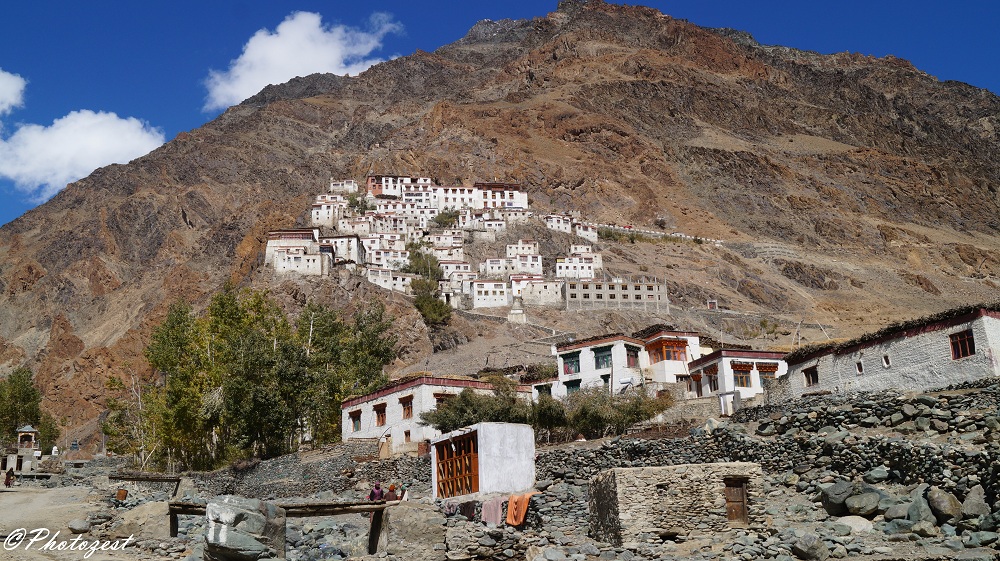
Including Zanskar valley in your existing Ladakh trip can be an addition of anywhere between 2 to 5 days, depending on how you intend to cover it. To give you an idea of how the overall journey can be planned, mentioned below are a few examples of a Leh to Zanskar Valley Itinerary explaining the route and the journey in detail.
The minimum time that you will need to visit Zanskar after Ladakh is 2 days. But t here is plenty to see in Zanskar valley and you can easily spend a week here exploring the place. The itinerary that I am suggesting below is a very comprehensive one and includes all sightseeing spots in the valley.
The travel plan below is not limited to just 2 days but depending on the number of days you have in hand, you can add or remove places for this to better suit you. For any other details on visiting Zanskar including the best time to visit, public transport, accommodation choices, and several other tips, please read How to Plan a Trip to Zanskar Valley .
Quick Navigation
Why Visit Zanskar
People think of Zanskar as the same as Ladakh. After spending some time in Ladakh, and assuming that the vistas will anyway be the same, most of the people tend to skip coming this way.
While the scenery may look similar, the fact is that Zanskar has a charm of its own that you just cannot miss. The beautiful contrast of green and brown between Suru and Zanskar valleys, the magnificent white of Drang Drung Glacier, the unique mix of culture are just some of the things that will make a trip here well worth your time.
An important thing that you need to remember though is in regards to the motorcycle and taxi rentals. Any vehicle that you have rented from Leh city will not be allowed in Zanskar and can only be used to get you as far as Kargil.
From Kargil then, you will have to rent another bike or cab which will bring you to Padum, show you around, and then take you back to Kargil. This is a great hassle that I wish I could tell you a way around but there really isn’t any.
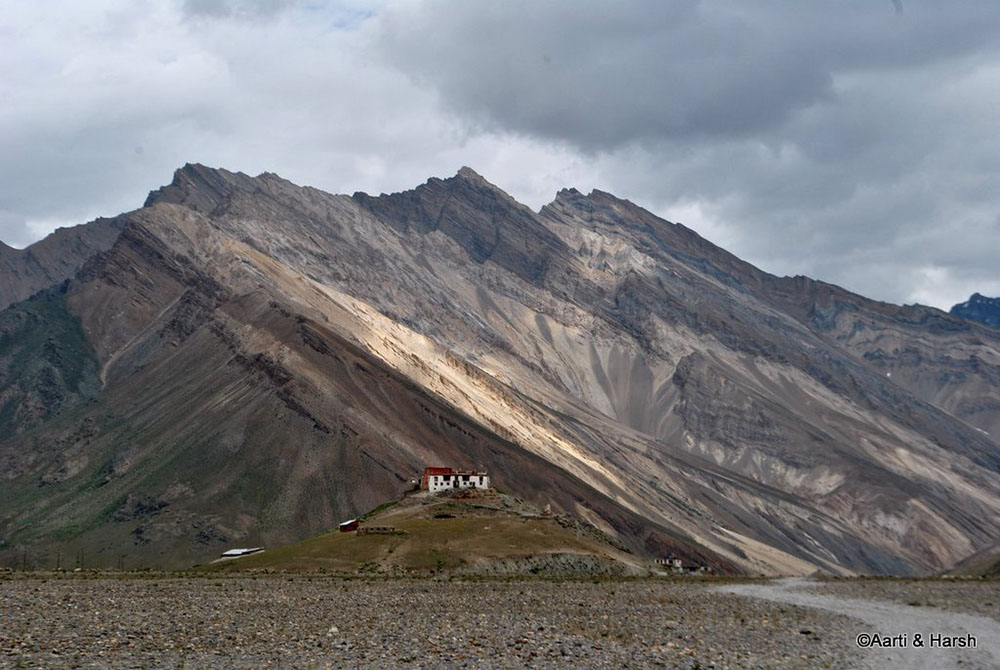
Leh to Zanskar Itinerary
Below is an example of how you can plan a visit to Zanskar Valley from Leh. I will first suggest an Itinerary that I recommend followed by a few alternate versions of it. The first itinerary assumes that you are coming to Zanskar from Leh and then will journey back to Leh city only.
- Leh – Day 1
- Leh to Kargil via Lamayuru – Day 2
- Kargil to Padum – Day 3
- Padum – Day 4 & 5
- Padum to Kargil – Day 6
- Kargil to Leh – Day 7
Why am I recommending traveling this way? Because this is pretty much a simple and straight journey that can be completed irrespective of your time and mode of travel.
It does not matter if you went by your own vehicle or public transport, early or late in the season. Following this itinerary, you will conveniently be able to travel to Zanskar valley from Leh and return. A detailed explanation of this Leh to Zanskar valley itinerary is mentioned below.
Also Read: Mobile Phone Connectivity in Zanskar Valley
Day 1 – Leh
Now this day could be in two possible ways that I can think of. The first one is that you just flew into Leh city in which case you should spend Day 1 resting and allowing your body to acclimatize.
The second one is that you were already in Ladakh and returned to Leh today from any of the other places like Pangong or Nubra valley.
Not much for me to write about Day 1 really because it will entirely depend on your itinerary so far. If you however flew into Ladakh today, then AMS will be your biggest concern. People who catch a flight to Leh are most prone to suffering from altitude sickness because of the sudden gain in altitude.
You must not exert yourself and take plenty of rest in order to allow your body to acclimatize. If you are feeling better by evening, then you can visit some of the local attractions in Leh city like Leh Palace, Shanti Stupa, and the local market.
Day 2 – Leh to Kargil
Your destination for the second day will be the small town of Kargil. The total distance of the journey will be about 220 kilometers; doable in 6 hours easily. The road is mostly all good until Kargil.
There are plenty of places that you should visit on the way like Mulbekh Maitreya, Lamayuru Monastery, Moon Landscape, Gurudwara Pather Sahib, Magnetic Hill, Indus Zanskar Confluence , etc. Cover as many places as you can and then you can visit the rest while on your way back.
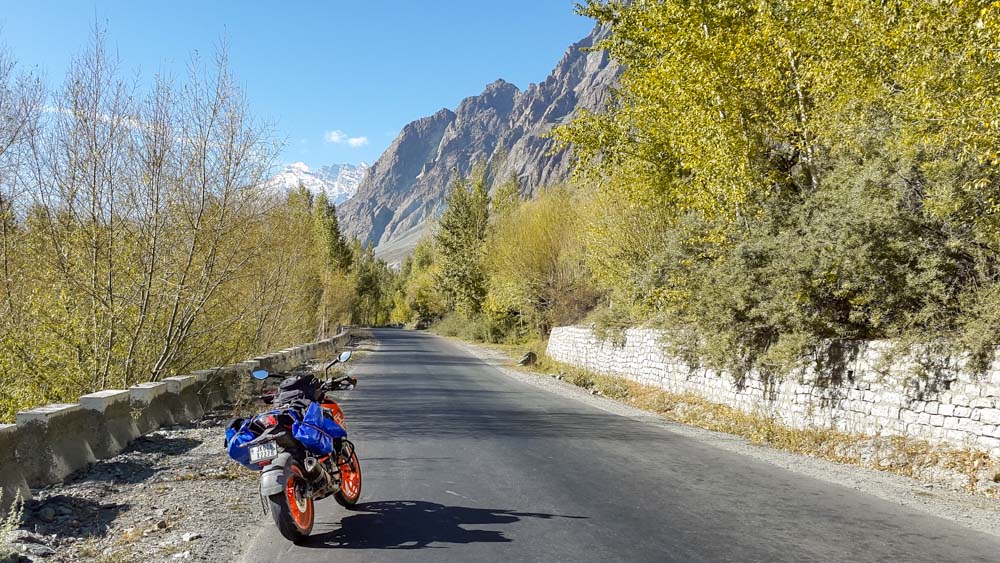
Day 3 – Kargil to Padum
The distance between the two towns is not really that great. It is just slightly over 230 kilometers but due to some bad stretches of the road, it may very well take you an entire day to cover.
There is also the fact that there will be plenty of sightseeing involved as well so an early start from Kargil is highly advised.
The route of the journey will be Kargil, Sankoo, Panikhar, Parkachik, Rangdum, Penzi La and finally to Padum. The area before Rangdum is all Suru valley and after Rangdum is all Zanskar. You will be amazed by the green it is all around in Suru valley and how it changes to a barren landscape slowly as you enter Zanskar.
I have covered the journey on this entire section in detail at Kargil to Padum Travel Guide . Take a look at this post to know more about the route and places you should be visiting here. Pensi La Pass, Drang Drung Glacier, Sta Tso, Lang Tso Lakes, and Nun-Kun Massif are some of the must-see places en route.
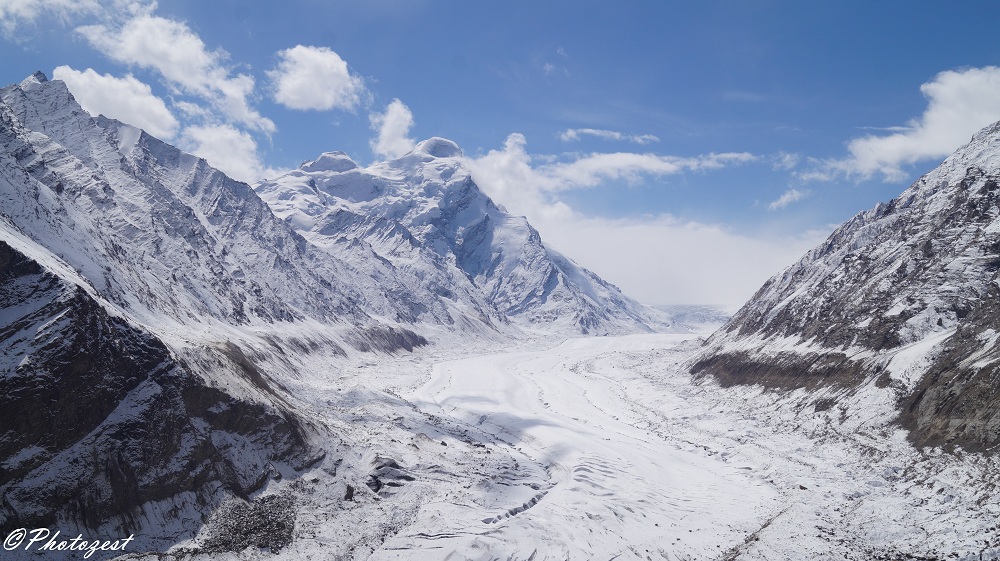
Day 4 & 5 – Padum
I have kept 2 days for sightseeing in Zanskar; covering places in Padum and in its vicinity. But you can cut it down to 1 day if you were short on time, or make it 3 if you could afford to do so.
For a complete list of places to visit in and around Padum, please read Tourist Places in Padum and its Vicinity . You will not really be covering a huge and most of the nearby local villages are within a day’s drive. If you arrived in Padum by public transport, then you can rent a private taxi for a day that can show you around.
Day 6 & 7 – Padum to Kargil to Leh
On day 6, you will return to Kargil via the same route that you took to get here. After spending the night in Kargil, you will then go back to Leh on Day 7. Plan your journey on this route in a way that you are able to cover all tourist attractions between Leh, Kargil, and Padum. Some can be visited while on your way to Padum and rest on your way back.
There are two roads from Kargil to Leh. One is via Lamayuru that you took to reach Zanskar valley. A second road exists that is rarely traveled by anyone. It takes you through the Batalik sector which is extremely close to India Pakistan border.
Also Read: Tourist Places in Zanskar Valley and its Vicinity
From Kargil, you will travel via Batalik and exit on Srinagar Leh highway away just before Khalsi. Please note though that this is the longer of the two roads and will easily take you about 8 to 9 hours to complete. So if you wanted to change the itinerary a bit, you can reach Zanskar from Leh via Lamayuru and go back via Batalik.
This is of course just one of the many ways that you can plan this journey. Depending on your own overall Ladakh itinerary and a few other factors, you can tweak it any way that is convenient to you.
Let me also suggest a few other examples of Leh to Zanskar Valley itinerary if this one did not fit into your plans well.
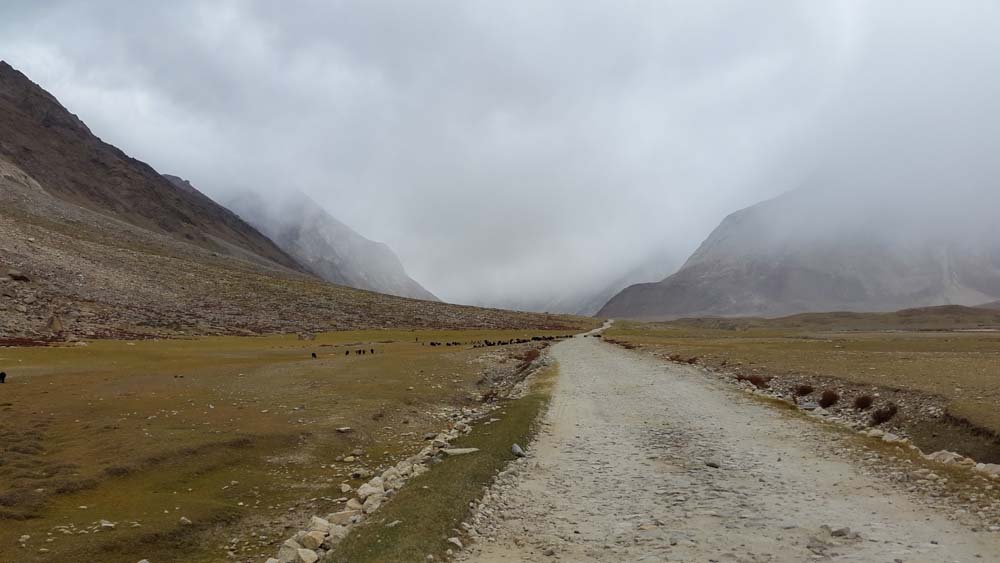
Leh to Srinagar via Zanskar
The two most popular ways to cover Zanskar are to either visit here while returning from Ladakh to Srinagar, or to plan a trip while going to Ladakh from Srinagar. If you too were thinking on the same lines, then let me also recommend how you can do so.
- Padum – Day 4
- Padum to Kargil – Day 5
- Kargil to Srinagar – Day 6
This itinerary is mostly the same as that I suggested above. The only difference is that on the last day, rather than going back to Leh, you will reach Srinagar via Drass and Sonamarg.
If you however wanted to try a different route, you can travel like this.
- Padum to Rangdum – Day 4
- Rangdum to Drass via Umba La – Day 5
- Drass to Srinagar – Day 6
Traveling in the manner above, you will spend the first half of Day 4 sightseeing in Padum and return to Rangdum in the latter half. You will spend the night in Rangdum and then reach Sankoo the next day.
At Sankoo, a road that was recently asphalted goes towards Umba La top and then descends down to Drass on the other side. This is more like a shortcut between Sankoo and Drass.
Also Read: Zanskar Valley Road Map
Do keep in mind that even though it is tarred, the road is very steep with a lot of hairpin bends. Weather too at this pass can change any minute. Before you take this road, please make sure to talk to the locals. Only proceed after you get an idea of how the road and weather ahead was.
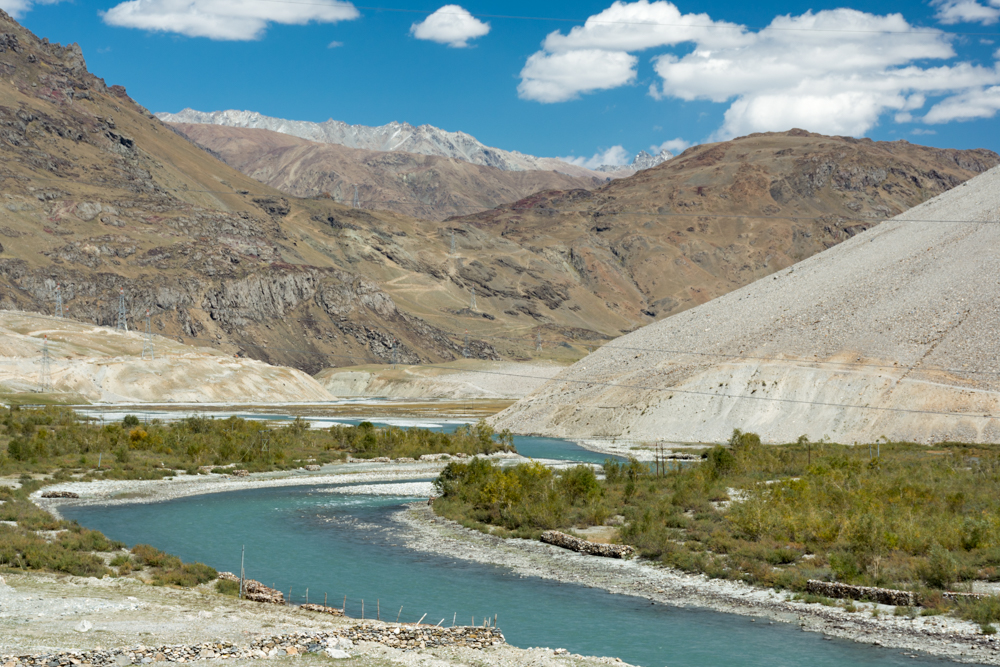
Srinagar to Leh via Zanskar
Now the above two itineraries were assuming that you were on your way home via Srinagar and covered Zanskar on the way. If you were however going to Ladakh via Srinagar and wanted to visit Zanskar on the way then you can travel like below.
- Srinagar – Day 1
- Srinagar to Kargil – Day 2
- Kargil to Leh via Lamayuru or Batalik – Day 6
Or like below
- Srinagar to Drass – Day 2
- Drass to Rangdum via Umba La – Day 3
- Rangdum to Padum – Day 4
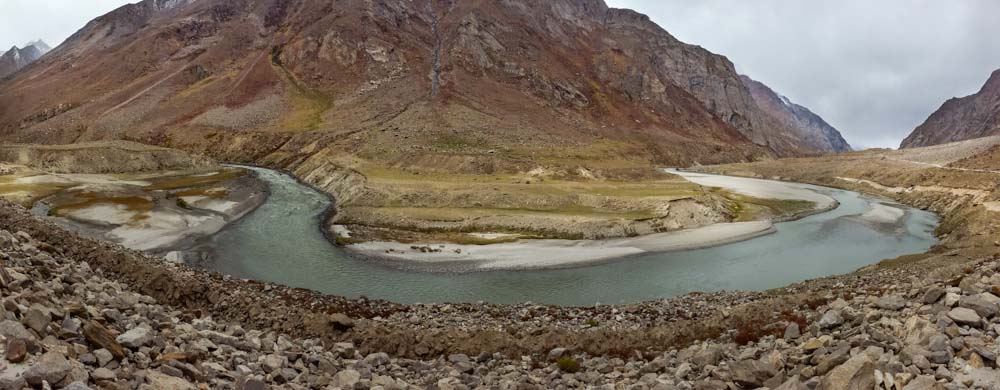
This is pretty much it. Those are some of the itineraries you can follow for your trip to Zanskar. Mentioned below are some of the other details of the journey which I believe can be of help.
Leh to Zanskar Distance
Rangdum is actually the place where you cross over from Suru valley to Zanskar. Leh to Rangdum is a total of about 350 kilometers but if you traveled all the way to Padum, then the distance increases to about 450 kilometers.
Leh to Zanskar Bus
The bus service from Leh to Padum is on weekly basis. This bus starts from Leh, halts at Kargil, and then continues to Padum the next day. The availability of seats on this bus too is uncertain.
Other than this, there is no direct bus from Leh to Zanskar valley. You will first have to board a bus from Leh to Kargil and then another one for Kargil to Padum.
Leh Zanskar Trek
The famous Chadar trek happens only in the winter season if that is what you were wondering about. Apart from the Chadar trek, there are numerous other trails too but for that, you must hire an experienced guide from Leh along with some porters.
Also Read: Accommodation in Zanskar Valley: Hotels, Guest Houses & Camp Sites
Leh to Padum
Leh to Padum is a 2 day’s journey minimum. There is really no way that you can do it in a single day. Though the distance of about 450 kilometers seems doable in a day, you must keep in mind that you will be driving through a hilly region and some bad roads that will severely limit your average speed.
Leh to Rangdum
Leh to Rangdum can be attempted in a day. But it will easily take about 12 to 14 hours depending upon your speed and breaks. You must start from Leh by the first light of the day. Even then, you will probably reach Rangdum by late evening only.
Leh to Drang Drung Glacier Distance
The total distance between Leh and Drang Drung Glacier is about 370 kilometers. A trip to Drang Drung Glacier from Leh is a 3 days affair at the least. The glacier is visible from the top of Pensi La pass. Even if you drove non-stop, you will probably not make it there by dark.
If you were interested only in the Drang Drung glacier and not all of Zanskar then you can first travel from Leh to Kargil on Day 1. On Day 2 you can do some local sightseeing in Suru valley including the glacier and town of Rangdum. You will then return to Leh on Day 3 either via Lamayuru or Batalik.
Also Read: Public Transport Services in Zanskar Valley
Kargil to Drang Drung Glacier Distance
Drang Drung Glacier is a total of 152 kilometers from Kargil.
Kargil to Padum Road
The entire stretch of road between Kargil to Padum is a dirt trail mostly. For the first 40 kilometers, until Sankoo, the road remains in excellent condition but deteriorates shortly after and remains so until Padum.
The good news however is that it never gets so bad where it may become too inconvenient. There are some bad sections indeed but for the rest of it, it is a ‘not so bad’ dirt road.

Leh to Zanskar Valley Itinerary – Conclusion
I hope the information above on Leh to Zanskar valley itinerary was of help. If you have any other questions, please feel free to ask in the comments section below or at our Community Forum , and I will be happy to answer.
Vargis.Khan
Not much to write about me really except for that I love to travel around whenever I can and to wherever I can. This blog is just a small attempt to share my travel experiences with the world. Hope you like it !!!
Related Articles
How to plan a trip to leh ladakh, srinagar leh highway status 2024 – 2025, zojila pass road status and condition 2024 –....
Hi, Is this the only route which we can see The Great Himalayan ranges? Not in any other part of Leh-Ladakh?
Hi Vargis! I really like your site and the detailed information you share. I am planning to visit Zanskar Valley and I am trying to find accommodation in padum but few hotels which i could find online are sold out. Could you please help me with few accommodation options near padum with phone numbers
Hi Vargis. Is it possible to go from Leh to Zangla following the Zanskar River on a Royal Enfield Himalayan ? Google maps show some road till near Skiu besides the zanskar river in Hemis National Park and then again the zanskar valley road north of zangla.
So there is a portion of about 100 kms between those two where it shows no road and wonder if you would be familiar if there is a dirt track or something connecting the two or if the terrain is something that the himalayan can take on ? alongside zanskar river ?
Any help will be highly appreciated – want to do something different than the regular manali leh kargil srinagar this july 2020 and hence looking at this route
* Padum and Darcha
There is but it is not completely motorable yet
Is there a road that connects Padum and Zanskar ?
Leave a Comment Cancel Reply
Save my name, email, and website in this browser for the next time I comment.

IMAGES
VIDEO
COMMENTS
The direct road between Zanskar Valley and Ladakh has not been built/completed yet, so the only way to travel to Zanskar Valley is via Kargil only. Zanskar Valley needs at least 4 days ex. Kargil. Two days are required to reach Kargil from Leh and come back to Leh or Srinagar. This makes it 6 days.
Zanskar Valley Itinerary 2: Manali to Zanskar Valley. In this Zanskar Valley itinerary, you will start from Manali and will end at Kargil. From there, you can either head towards Leh or Srinagar, as per your convenience. ... I recently used Travel Blogs to plan my trip to the beautiful Zanskar Valley in India. Their 8-day itinerary was well ...
It is a 230 kilometers long road that starts from Kargil and ends in Padum in Zanskar. The route will be as mentioned below. Delhi - Jammu - Srinagar - Sonamarg - Dras - Kargil - Sankoo - Parkachik - Rangdum - Pensi La - Padum. Until a few years ago, this used to be the only way in and out of Zanskar Valley.
Zanskar Valley Itinerary. Day 1: Srinagar to Kargil (209 kms) Day 2: Kargil to Rangdum (127 kms) Day 3: Rangdum to Padum (105 kms) Day 4: Padum to Hanumil to Padum (120 kms) Day 5: Padum to Reru to Padum (90 km) Day 6. Padum to Kargil (230kms) Day 7.
Reaching Zanskar from Manali. This is another road that opened in 2020 and the best thing about this road is that it connects the Lahaul Valley to Zanskar Valley via the Shinku La Pass (16580 feet). So basically, you can start your trip from Manali and reach Zanskar Valley. The route is as follows:
About Zanskar Valley: An itinerary for Zanskar Valley: Day 1: Flying into Leh. Day 2: Drive to Damsna in Kargil. Day 3: Journey through Suru Valley to Rangdum. Day 4: Onwards to Zanskar Valley. Day 5: A fascinating drive to Padum. Day 6: Gumbok Rangan. Day 7: A day with the sacred mountain.
Tucked away in the remote corners of Ladakh, Zanskar Valley is a place of breathtaking beauty and sheer adventure. Nestled between the mighty Himalayas and the Zanskar mountain range...
Itinerary to a trip to Zanskar valley. Day 1: Reach Leh and Acclimatize. Day 2: After breakfast, leave for Sham Valley Tour and Reach Kargil. Day 3 - 4: Explore Kargil and nearby Places. Day 5: Leave for Zanskar Valley Tour, Explore places on the way like Suru Valley, Rangdum, etc., and reach Padum. Day 6: Explore Padum
Zangla Palace is a 17th-century palace located in the village of Zangla in the Zanskar region of Ladakh, India. The palace is situated on a hilltop overlooking the village and the Zanskar River valley. It is a three-storey structure with a central courtyard. The palace was built by the Zangla royal family, who ruled the region from the 16th to ...
When you travel to Zanskar Valley, acclimatization is always an important factor in making it a memorable trip. ... I just want to know what should be the ideal itinerary to travel to Kargil, Zanskar Valley, Nubra , Pangong and Tsmori. And can we hire a 14 seater traveler to visit all these places? DHEERAJ SHARMA on Sep 27, 2017 16:41.
A Journey Through the Land of Mystic Beauty: Zanskar Valley Tour Itinerary travelaroundtheworldblog February 16, 2024 . Nestled amidst the mighty Himalayas, Zanskar Valley stands as a testament to nature's grandeur and mystique. Tucked away in the remote reaches of Ladakh, this pristine region offers intrepid travelers an unforgettable ...
Below are 7 itineraries that cover the major highlights of Ladakh, the tours can be customized. ... Zanskar valley - cultural tour. list of tours in Ladakh. Duration: 5-6 days Distance: 990 km. The isolated Zanskar valley is known for its breathtaking landscapes and its remote and authentic villages where it looks like the time has stopped. The ...
Explore the Zanskar valley tour package immerse in the allure of Zanskar. Book now for an enriching adventure and discover the beauty of this pristine destination. ... Choose from our pre-designed itineraries or customize your trip with us to turn your travel dreams into reality. Whether you seek adventure in the mountains, cultural immersion ...
The Zanskar Valley is a semi-arid region, perched at an average height of 13,000 ft. The road to Zanskar remains open only for 5 months in the summer. For the rest of the year, the valley remains cut off owing to heavy snowfall. The only medium of communication during this time is the frozen Zanskar river.
9 Day Travel Plan - Zanskar Valley from Leh. In this itinerary of Zanskar Valley, as you will be flying directly to Leh which is located at an altitude of about 3500 Mtrs. Hence, you must acclimatize properly in order to combat acute mountain sickness. It is of utmost importance to rest for at least one day before moving or travel anywhere in ...
Explore Zanskar Valley with The Tarzan Way's AI travel itinerary. Immerse yourself in iconic landmarks, hidden treasures of Zanskar Valley, and book your flights, accommodations, and transfers all in one go. Create a Trip. Login. Zanskar Valley Trip Planner. Bid farewell to generic holiday packages. ...
Overview/Itinerary About Zanskar Valley Tour. The ancient faraway kingdom of Zanskar, also known as Zahar is a far off valley in the Kargil district, located in the eastern fragment of Ladakh. Soaring at an altitude of 7,756 meters, Zanskar is a cold, arid desert with cavernous gorges and glaciers. In the past, Zanskar and Ladakh collectively ...
In most of the itineraries, a visit to the ZANSKAR valley does not include more than 3 or 4 days, out of which 2 complete days are spend on the to & fro travel time. The remaining 1-2 days are good enough to cover the local sightseeing. However, if you want to include PHUKTAL monastery in your ZANSKAR itinerary, it would require atleast 3 ...
Rangdum - Padum Via Suru Valley (131 Kms/5 Hrs) Drive to Padum, Padum the capital of the ancient kingdom of Zanskar, Padum (3505 m) is the present day administrative headquarters of the region. With a population of nearly 1500, Padum can be described as the most populous settlement of Zanskar, otherwise a very scarcely inhabited valley.
It is advisable to plan for a minimum of 5 days. Zanskar valley (5-day to 10-day tour) from ₹ 116,250 / car. At the end of the tour, from Kargil, you could go to Srinagar instead of coming back to Leh. Zanskar valley and Srinagar (5-day to 10-day tour) from ₹ 129,375 / car.
Below is an example of an itinerary for Zanskar Valley. I will first detail an itinerary that I recommend provide by a few other alternate versions of it. Delhi to Jammu - Day 1. Jammu to Srinagar - Day 2. Srinagar - Day 3. Srinagar to Kargil - Day 4. Kargil to Padum - Day 5. Rest Day in Padum - Day 6. Sightseeing in Padum - Day 7.
From duration, itinerary, accommodation, and travel or miscellaneous support, all is to be gone through to finally decide upon your best Zanskar Tour Package. For you, we are mentioning the basic details of some significant Zanskar Valley Tour Packages. Ladakh With Zanskar Valley Tour: This tour could last between 12 and 13 days. You can go to ...
The first itinerary assumes that you are coming to Zanskar from Leh and then will journey back to Leh city only. Leh - Day 1. Leh to Kargil via Lamayuru - Day 2. Kargil to Padum - Day 3. Padum - Day 4 & 5. Padum to Kargil - Day 6. Kargil to Leh - Day 7.